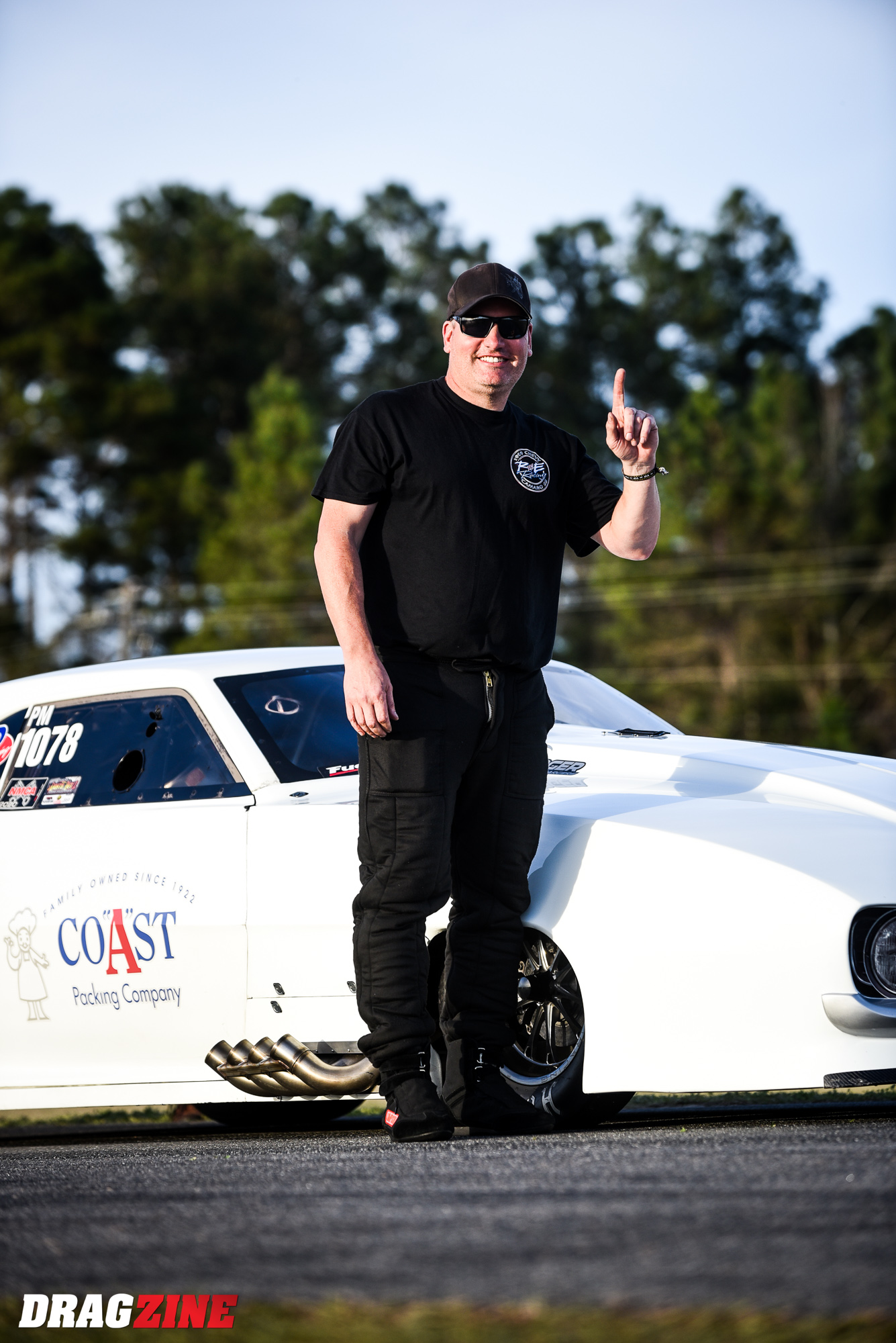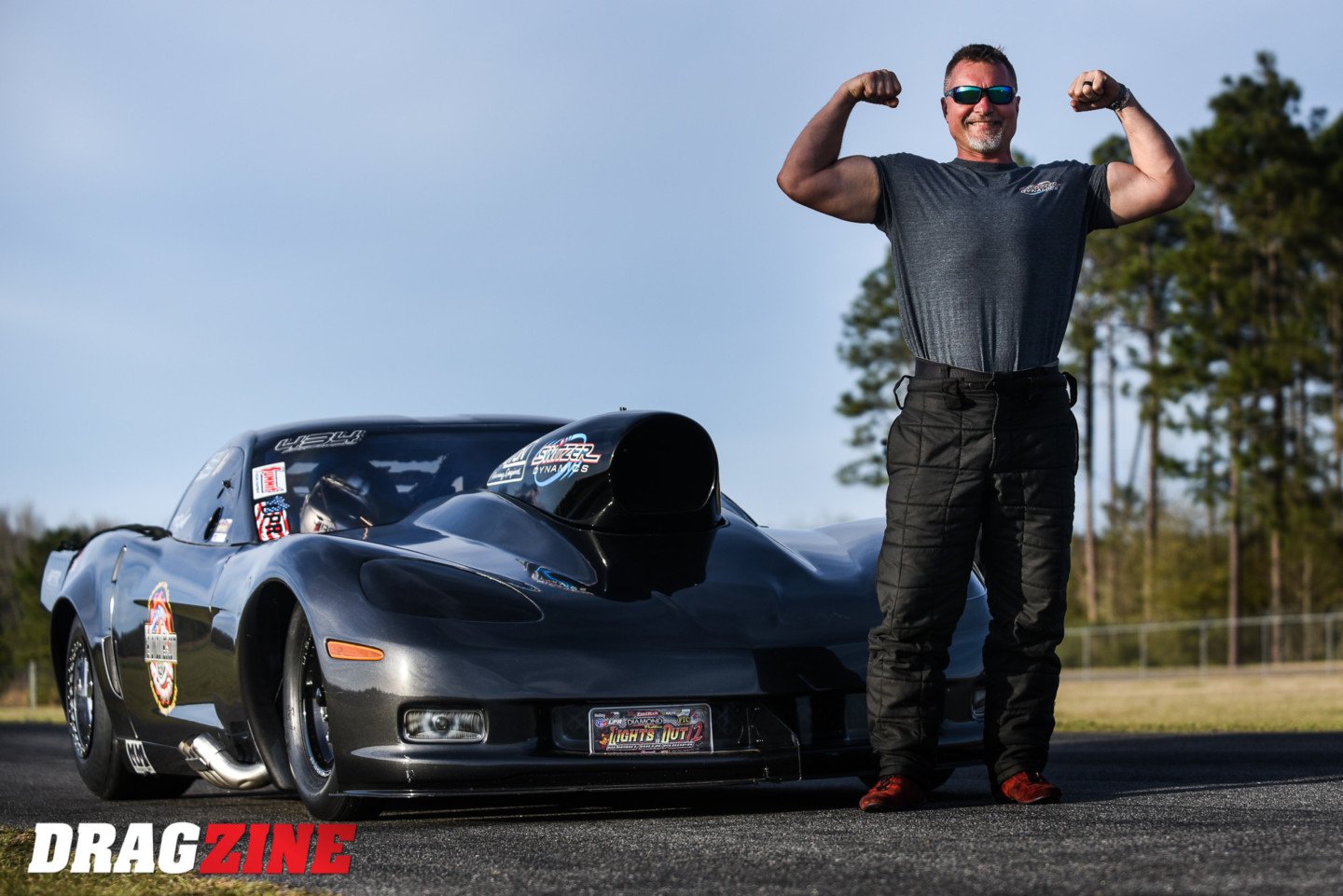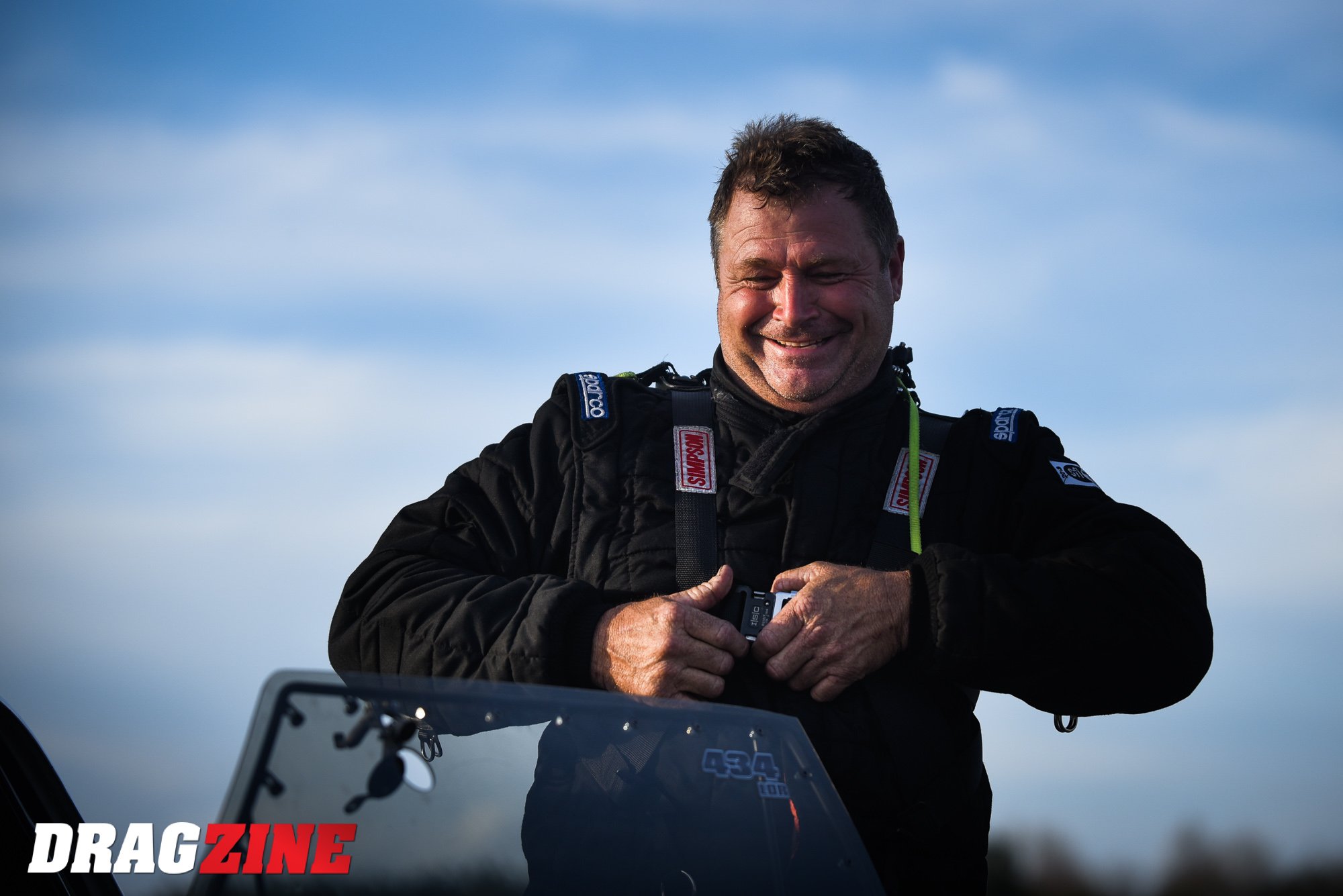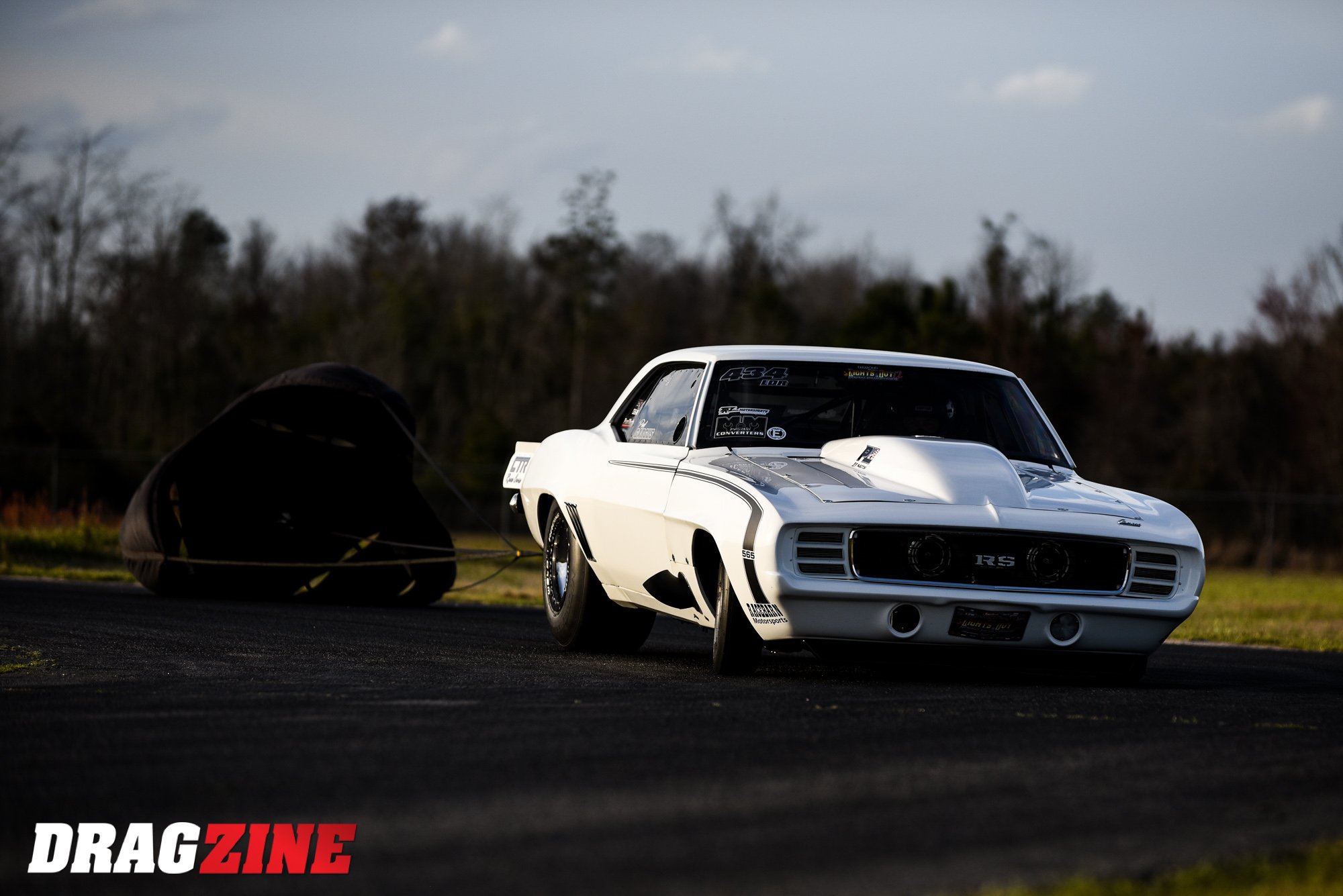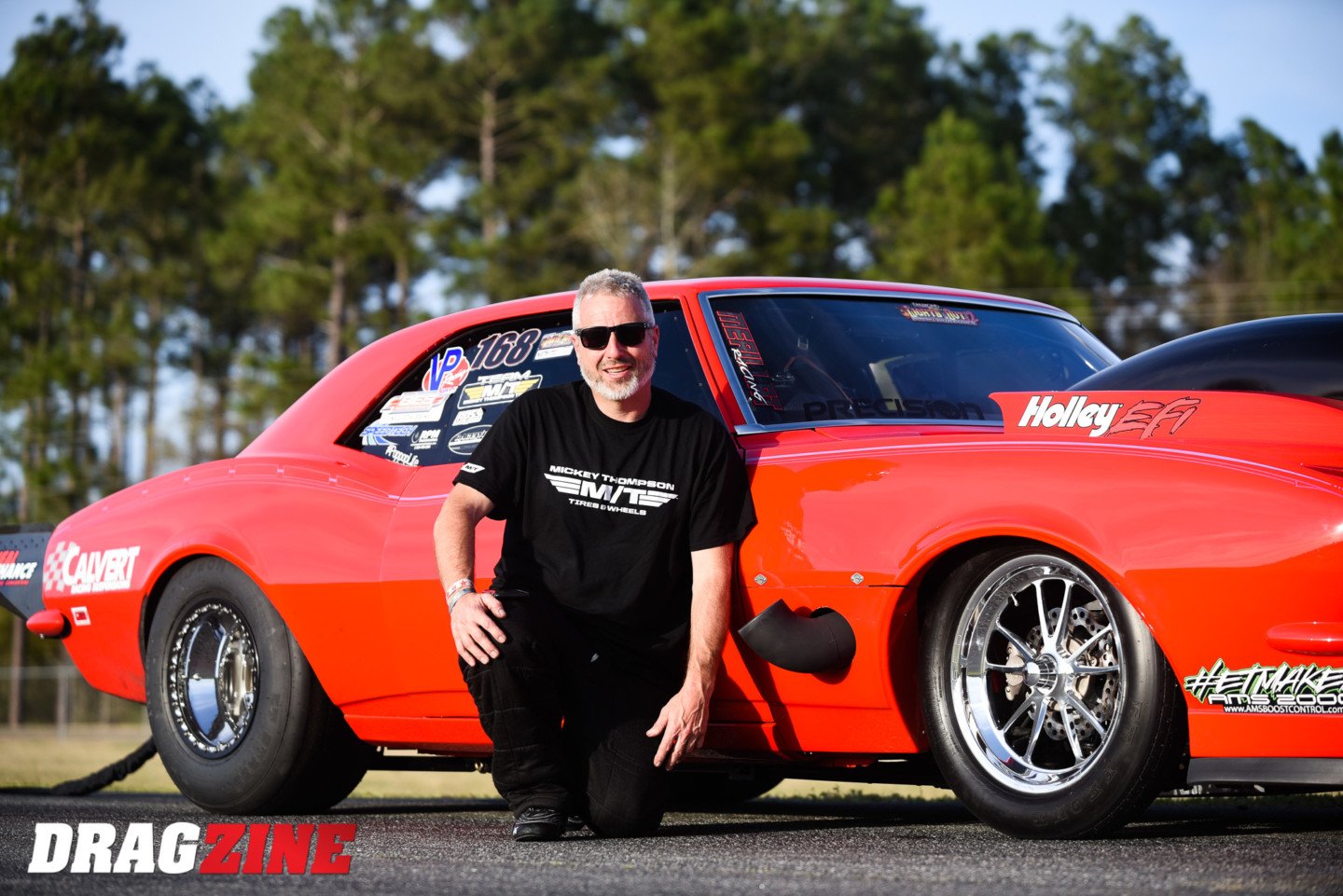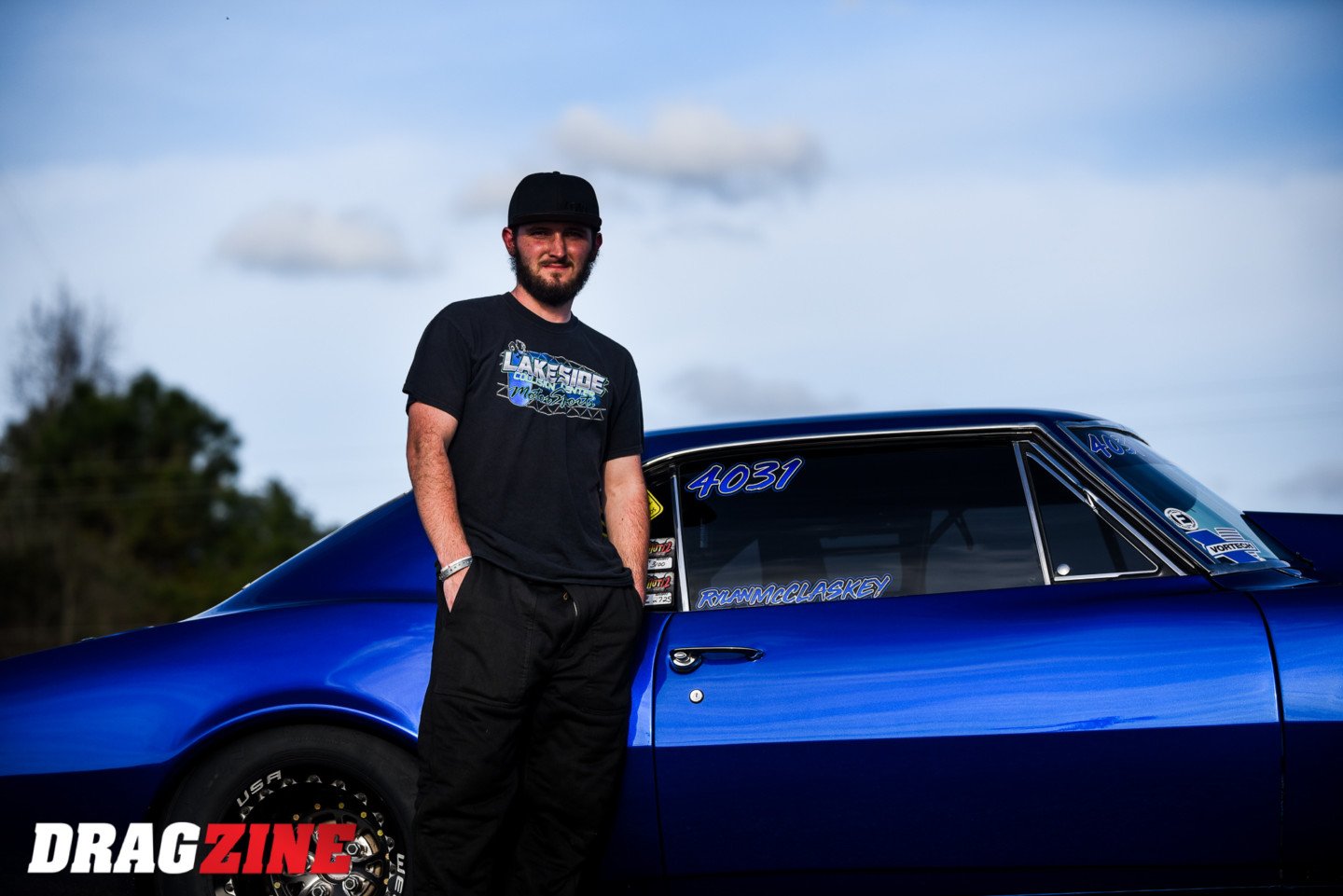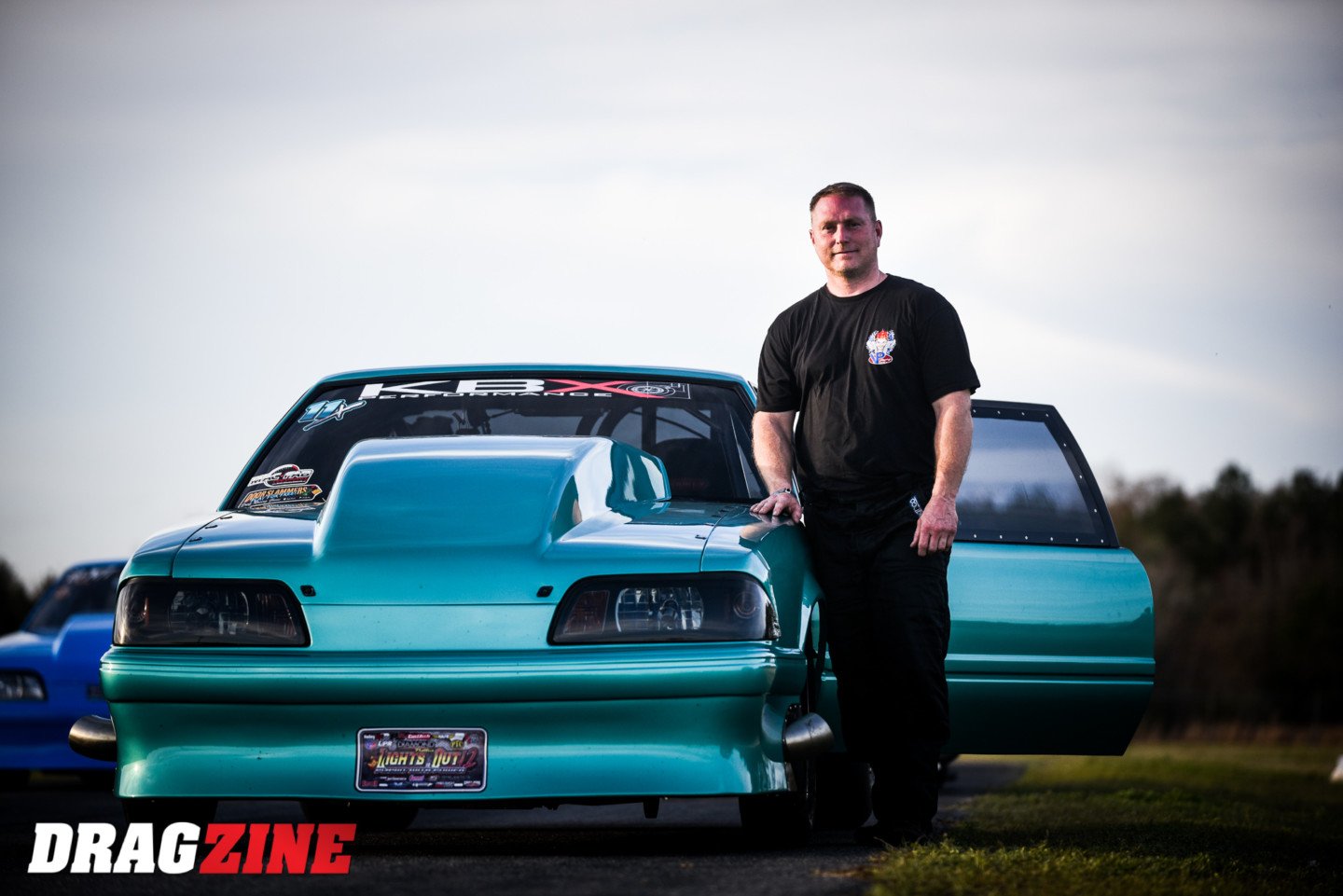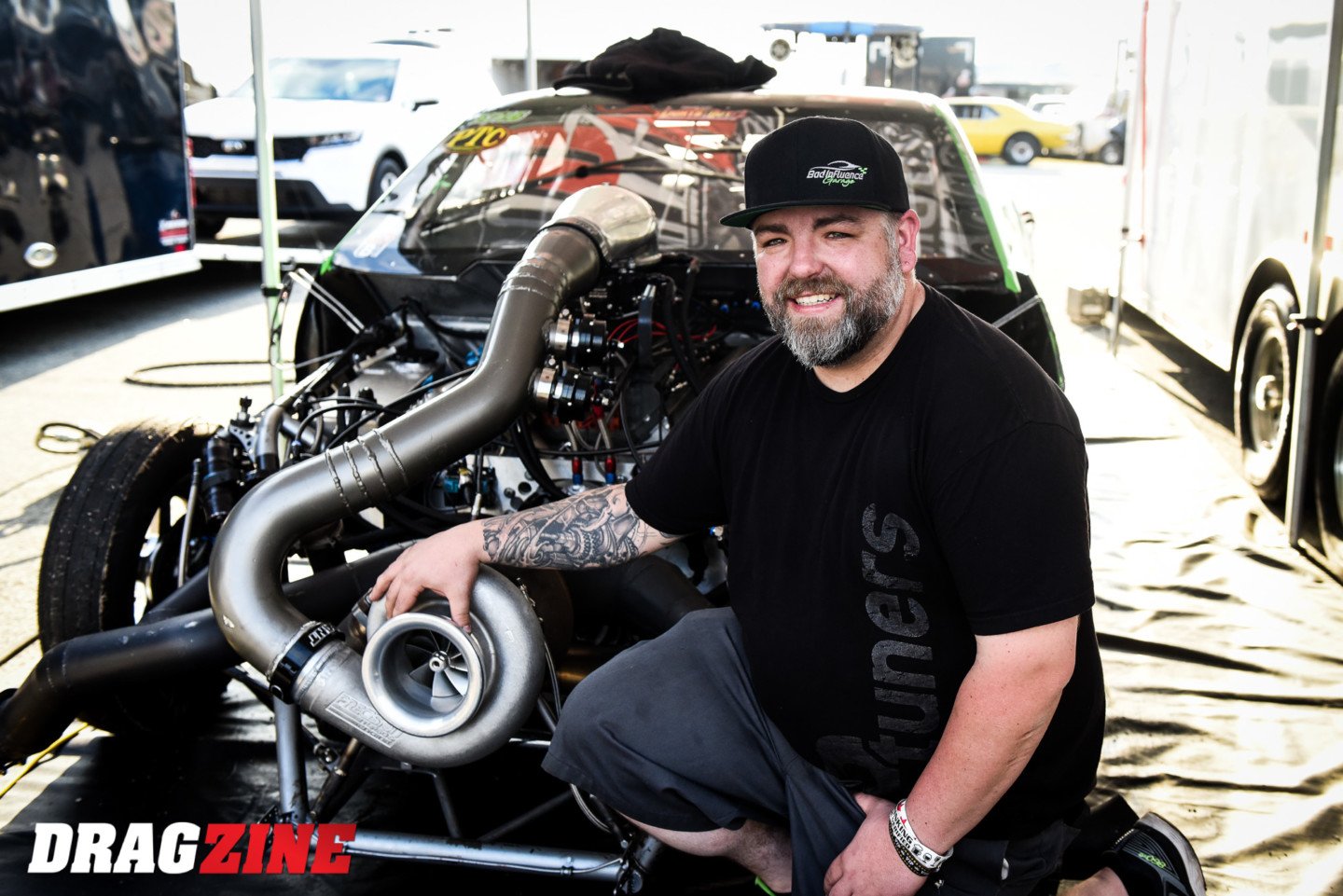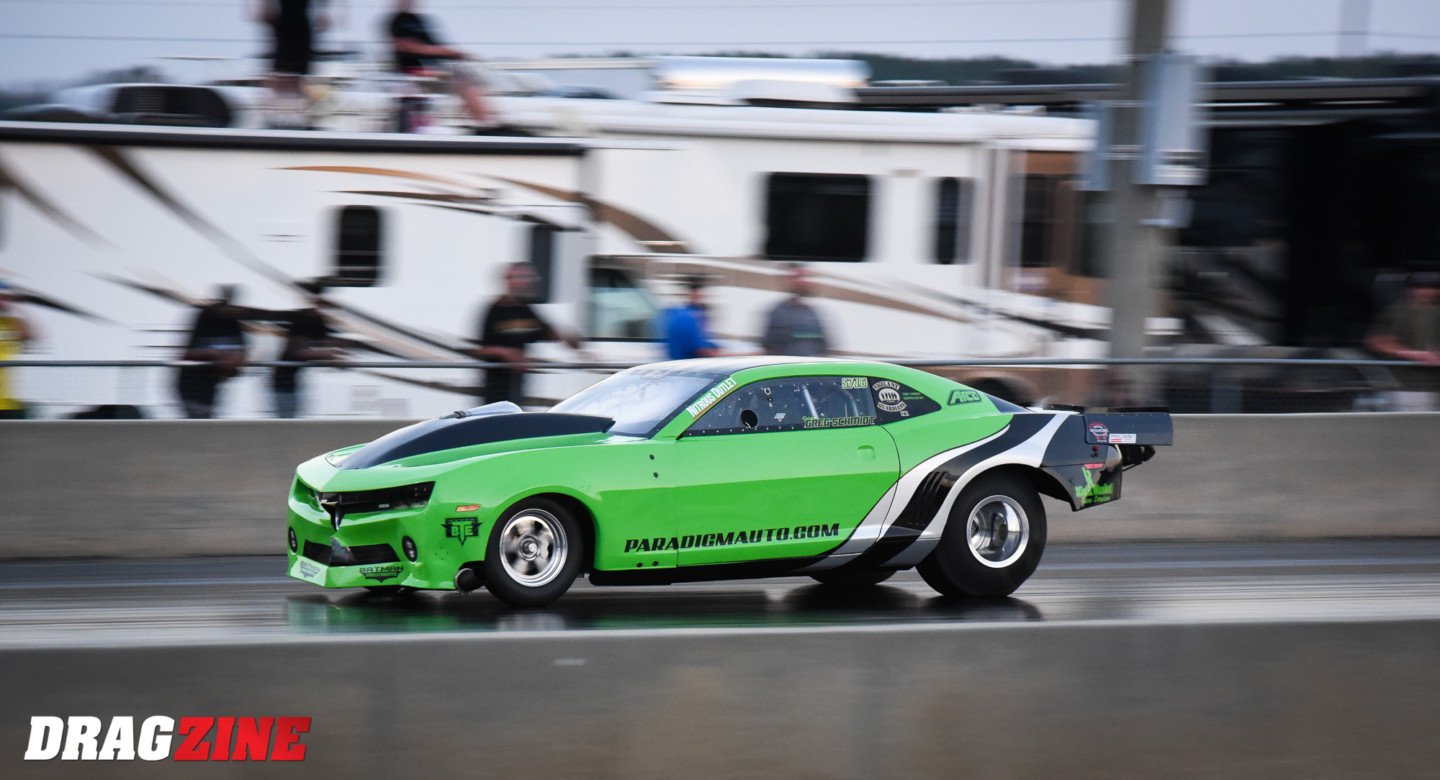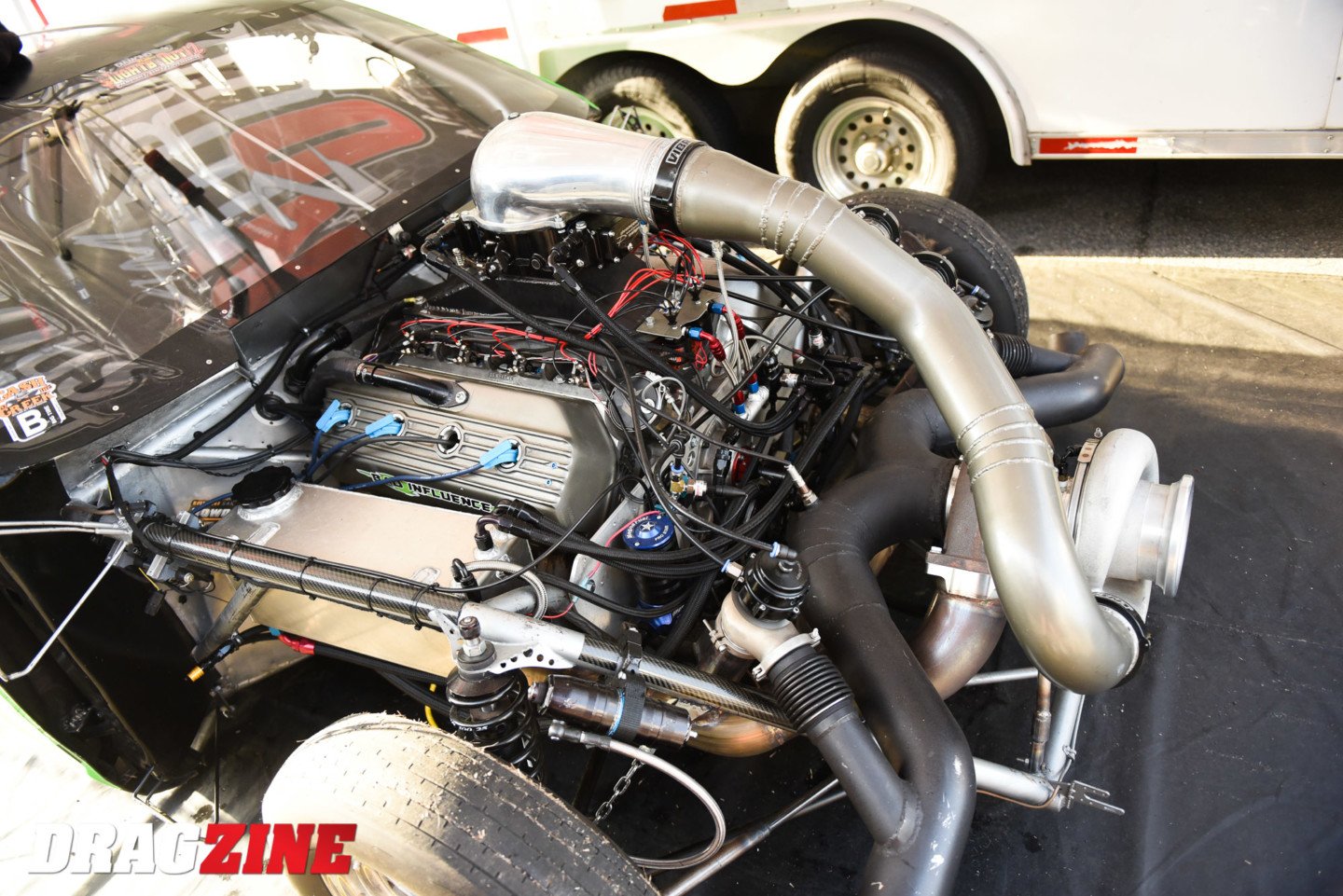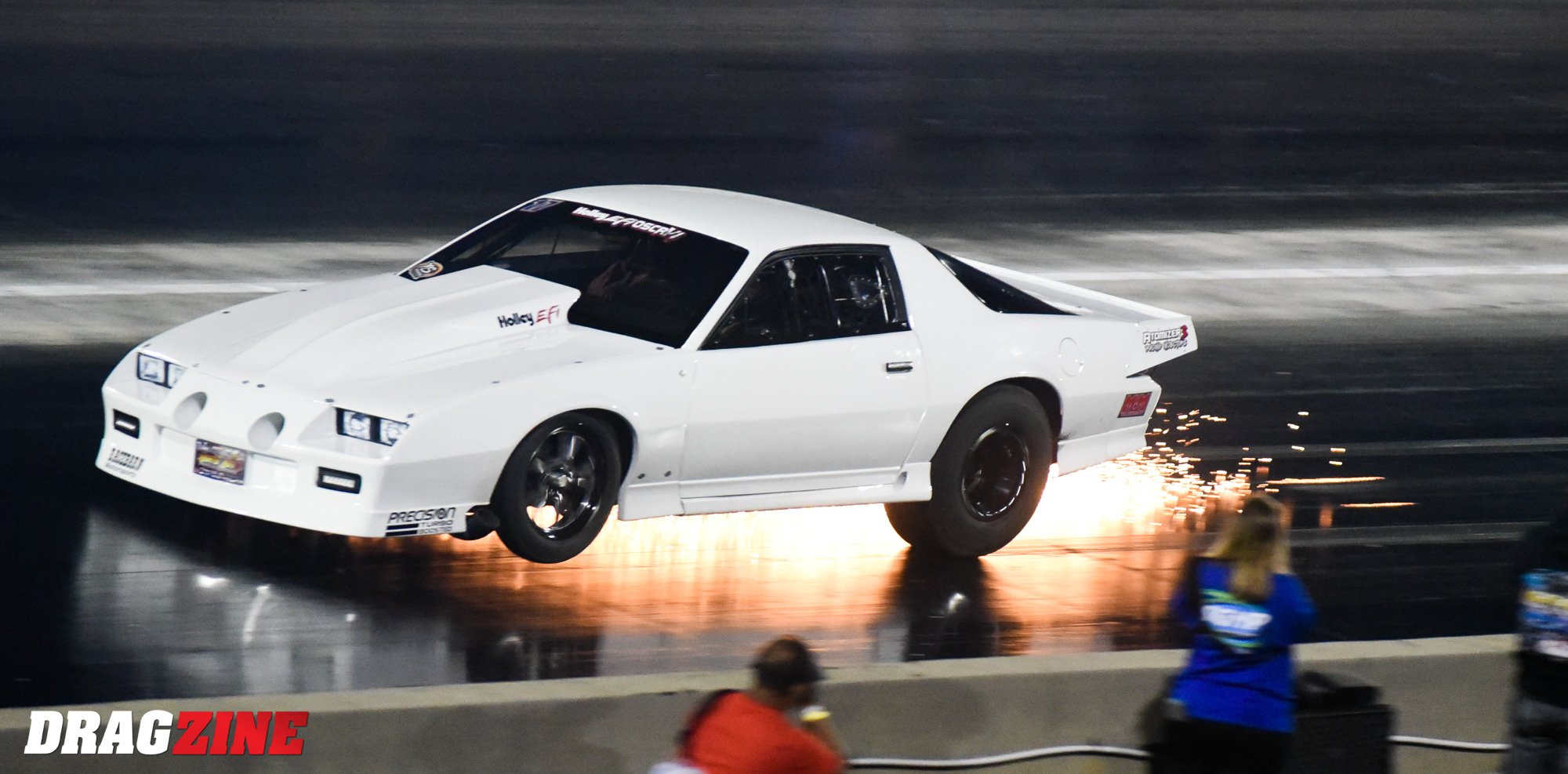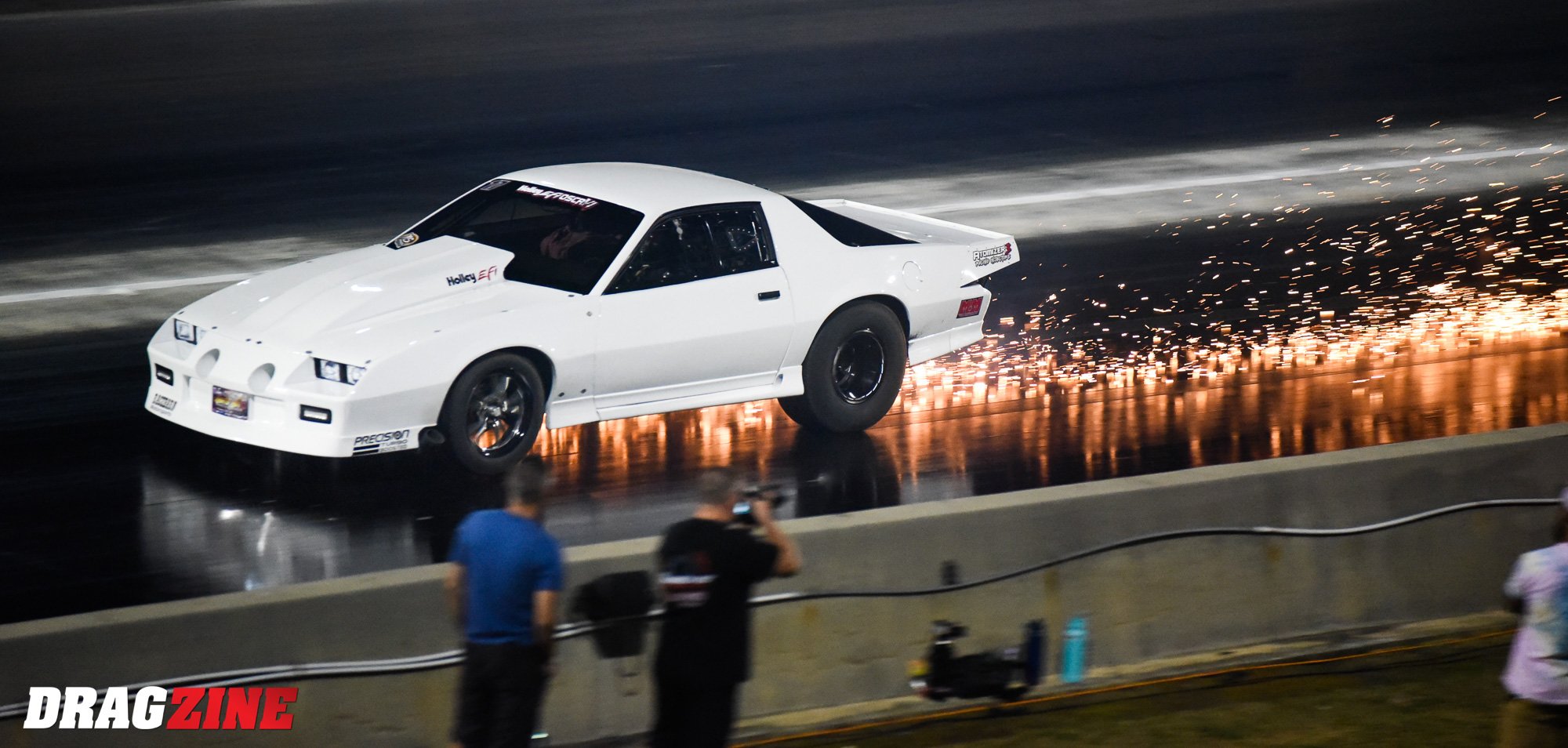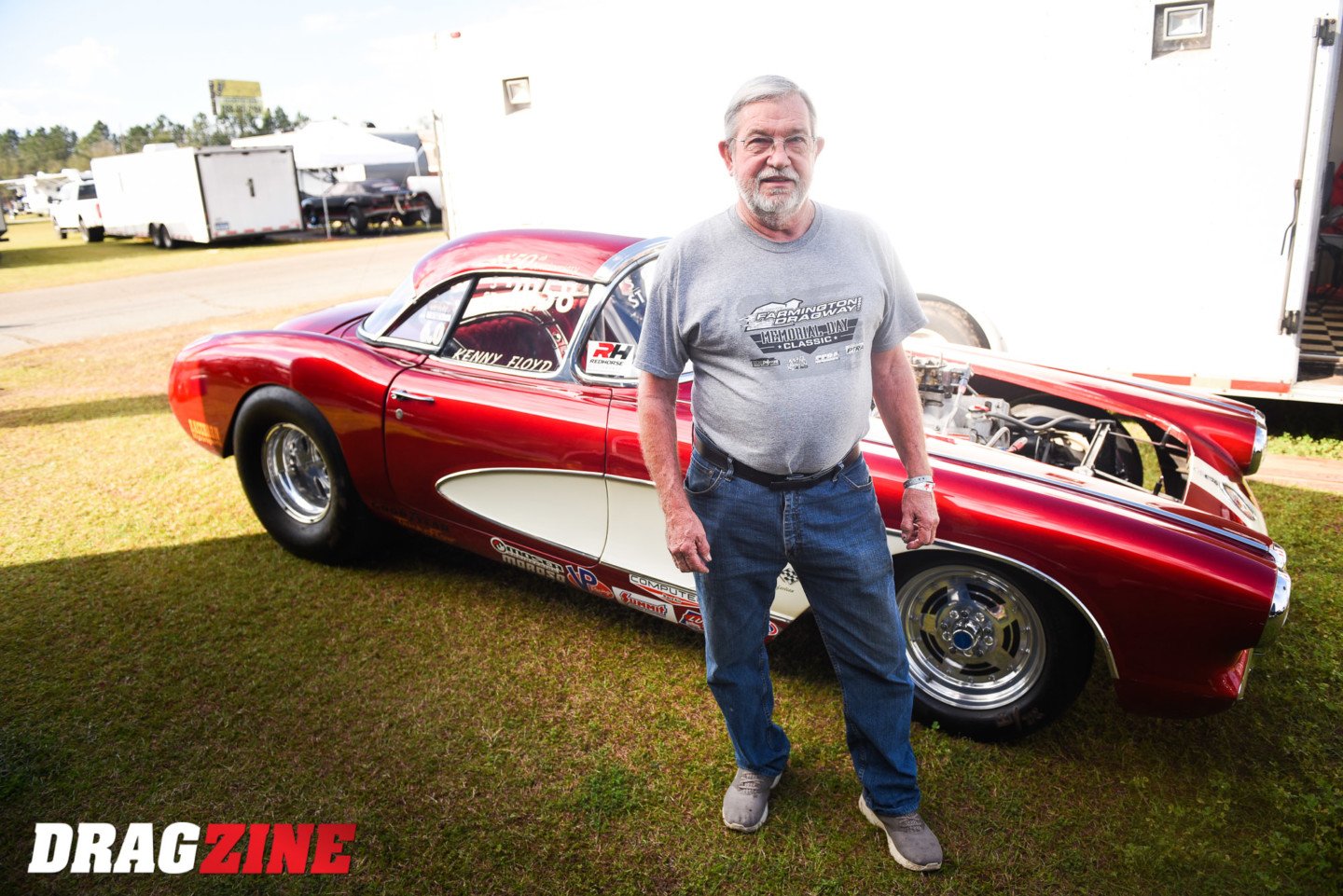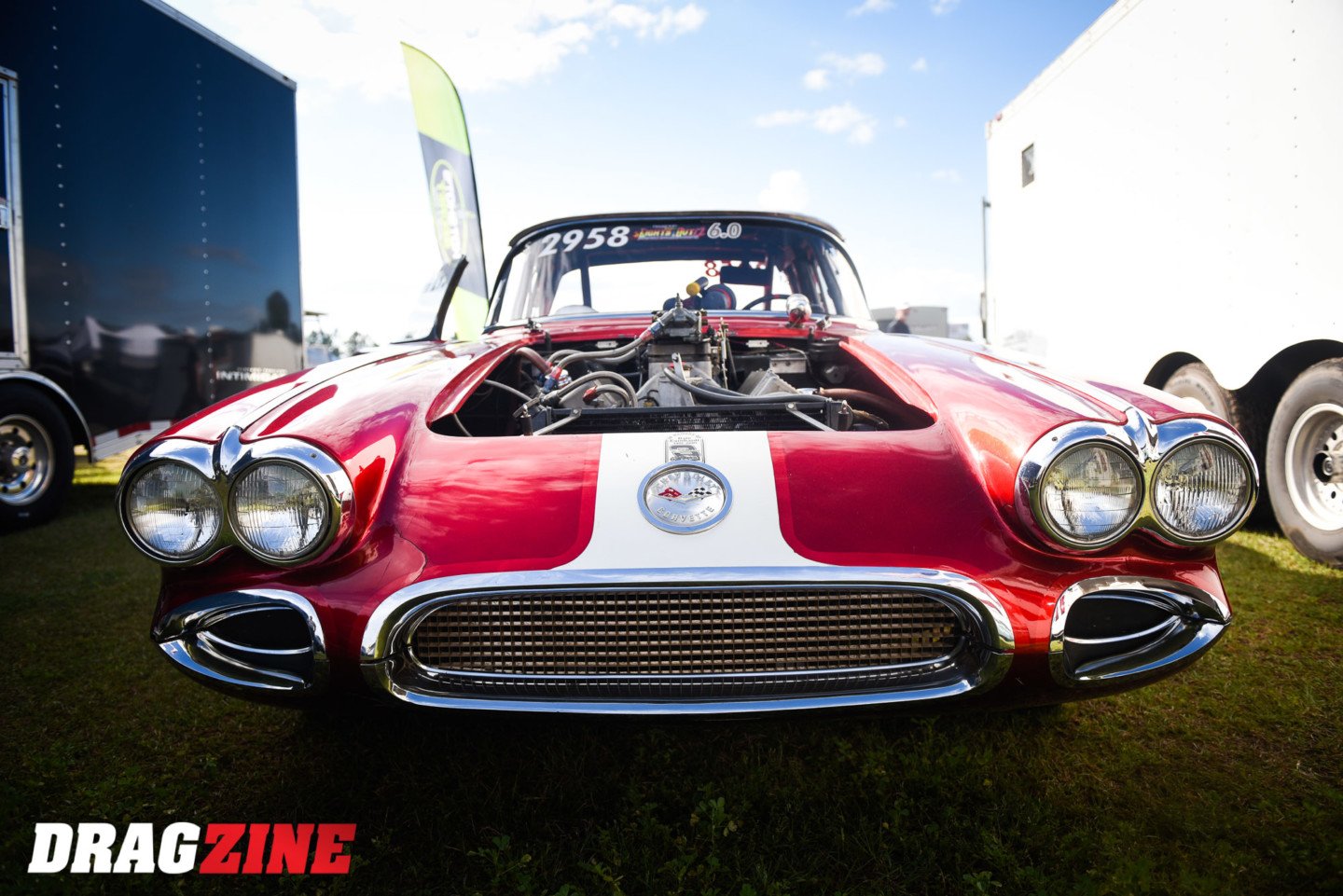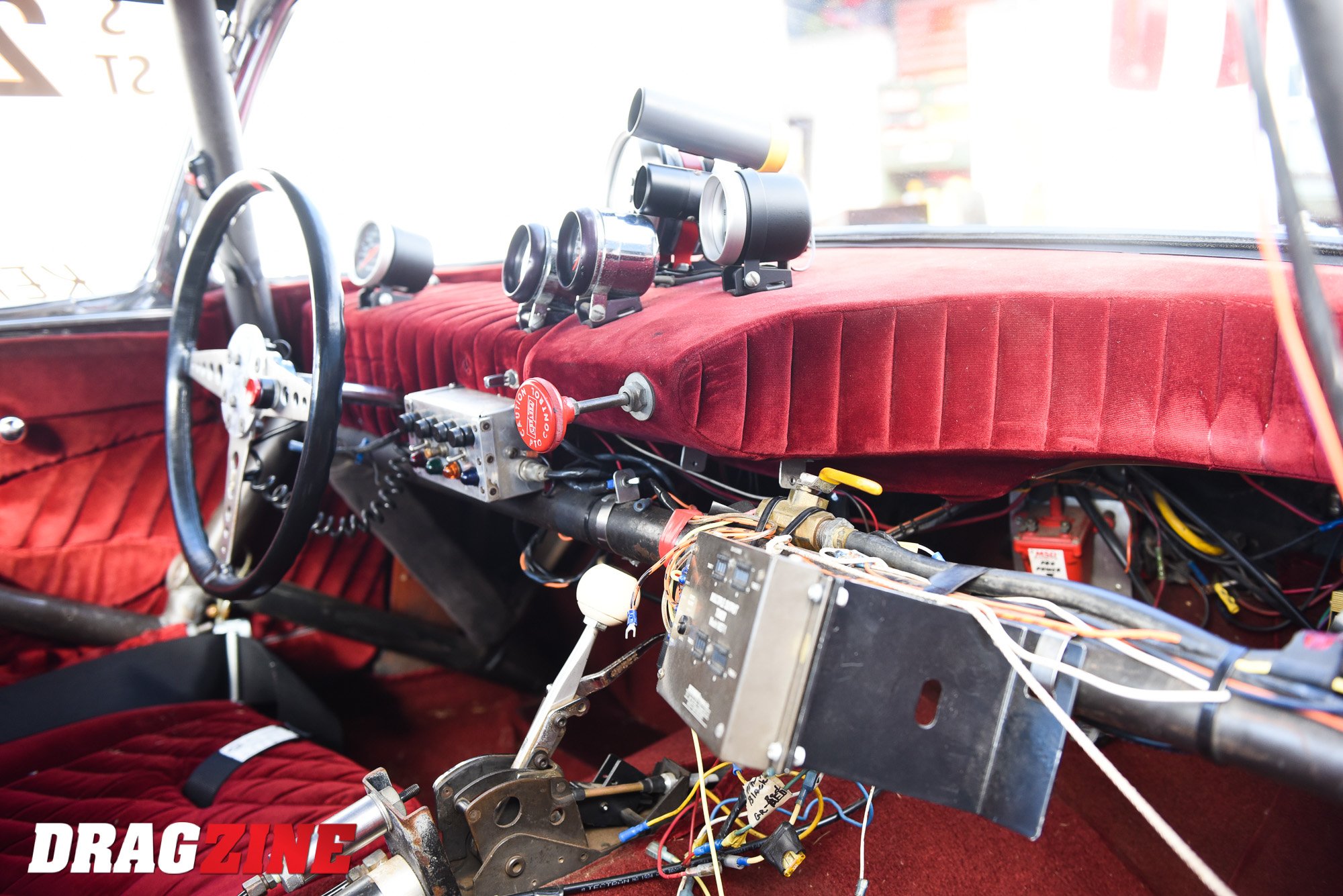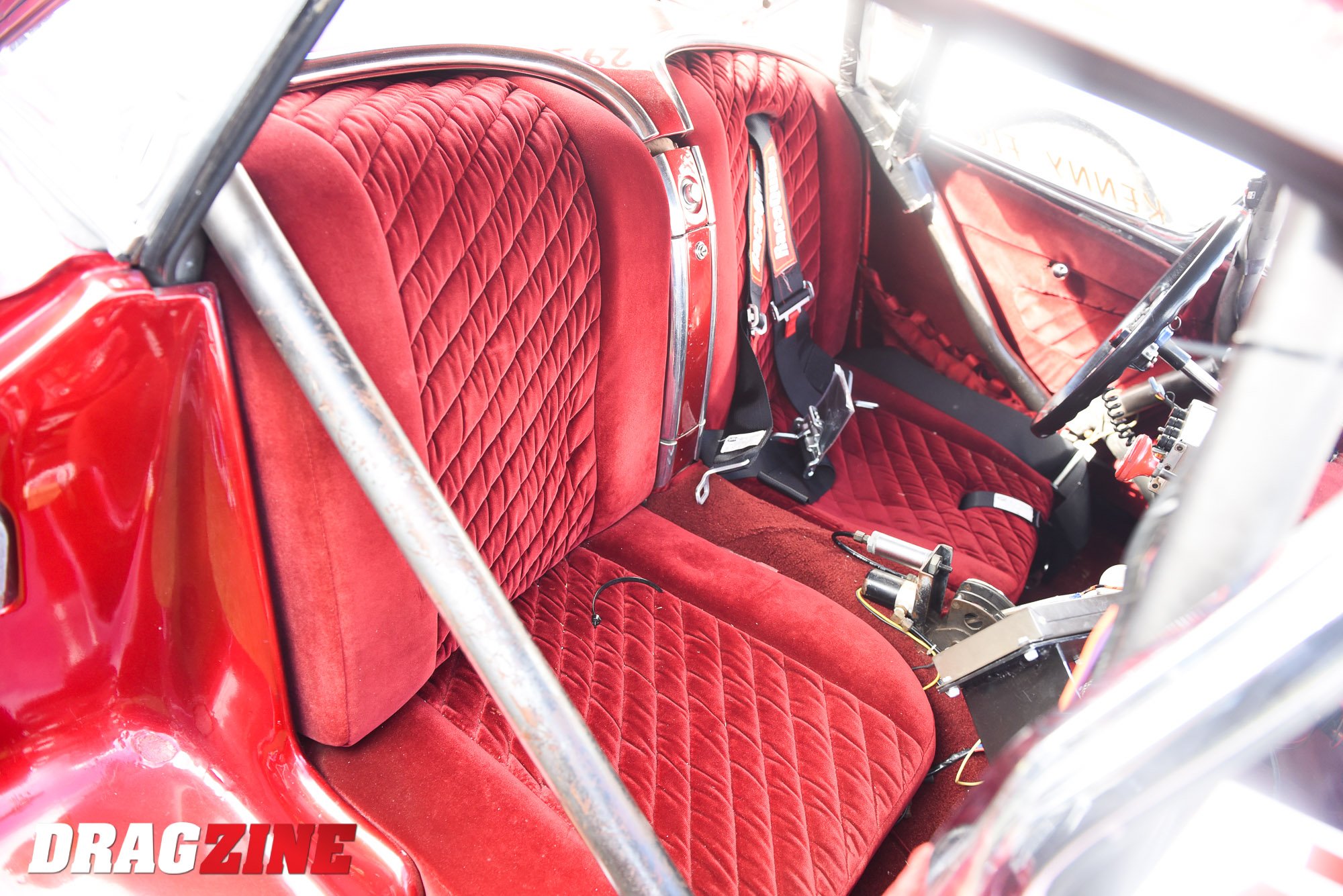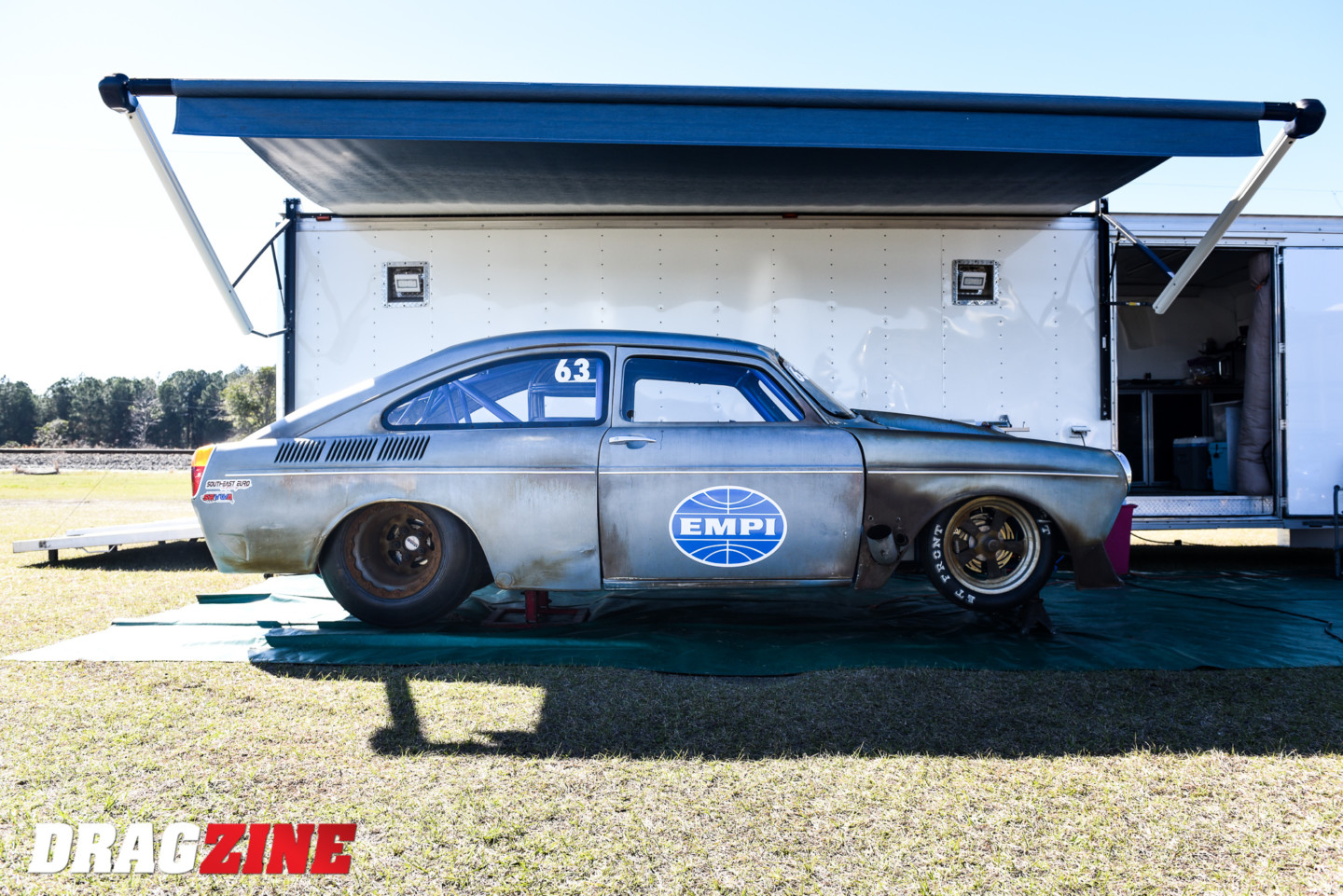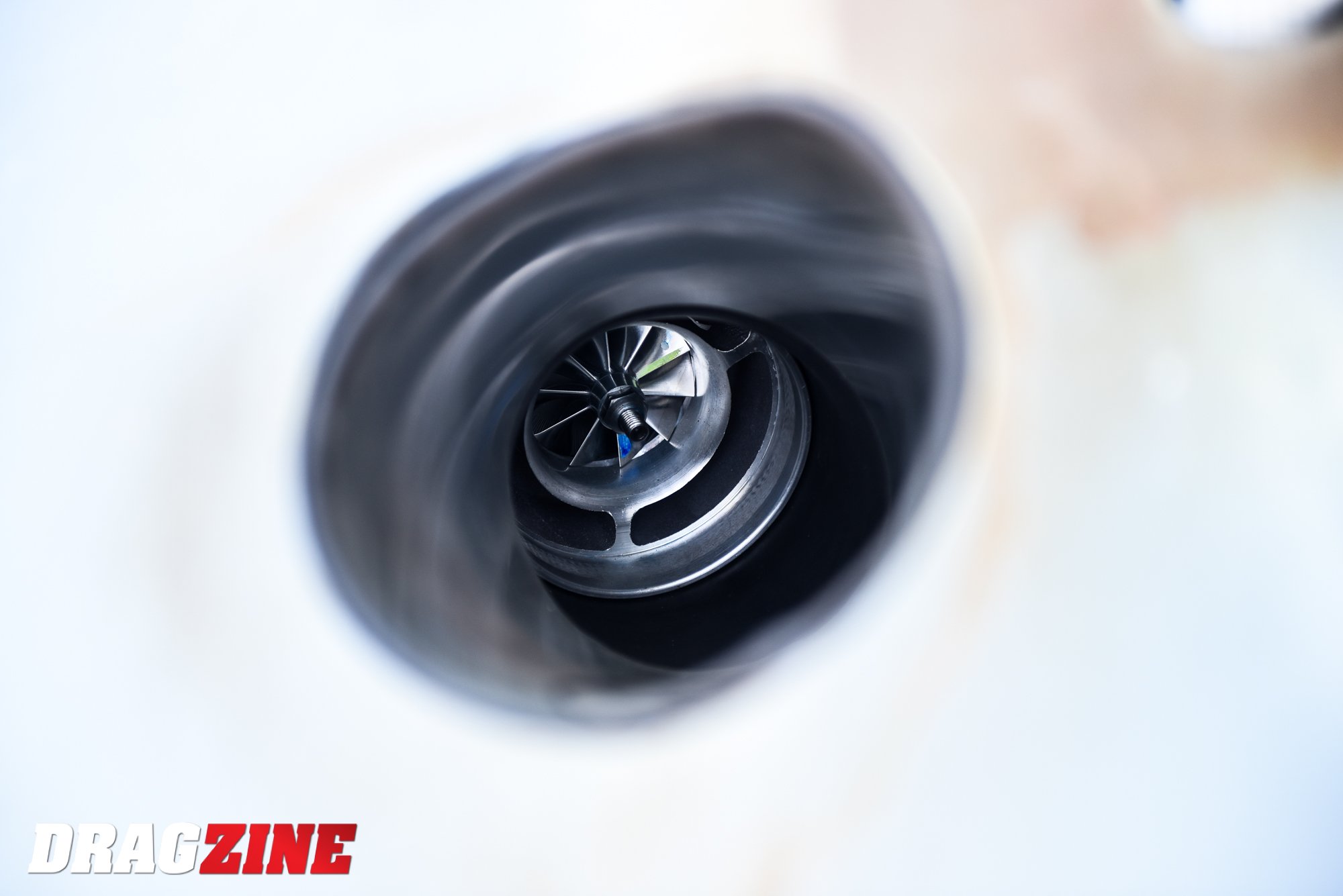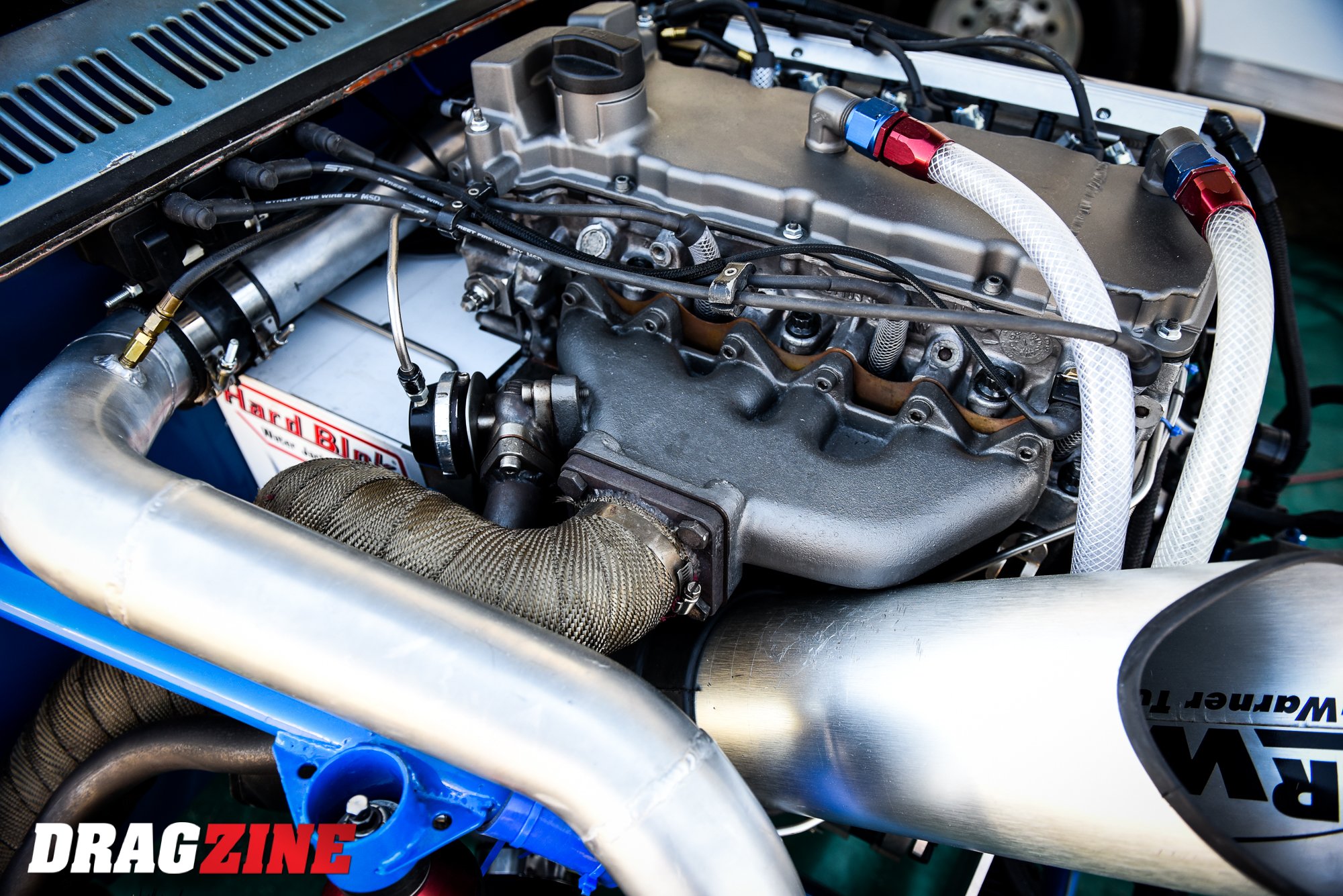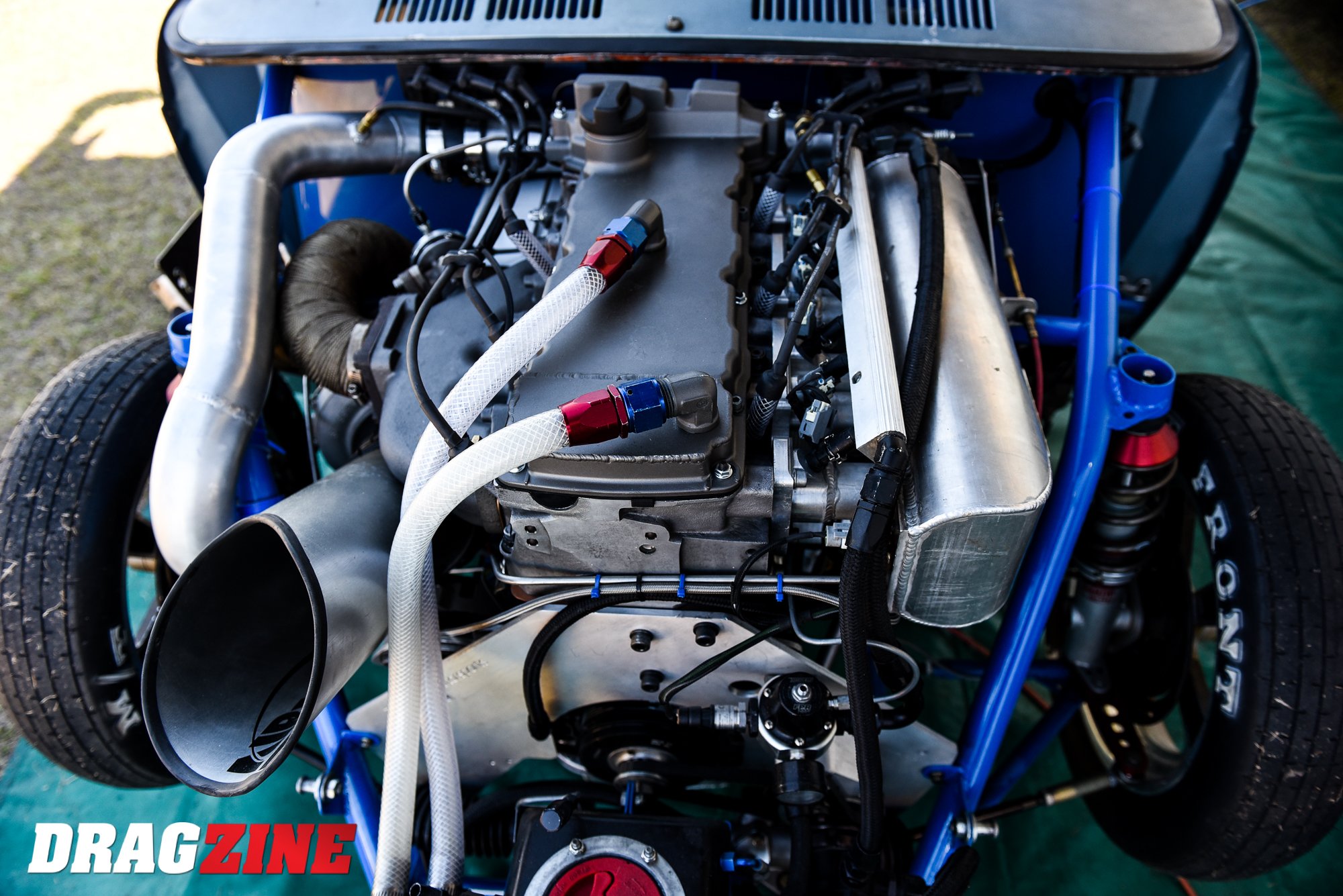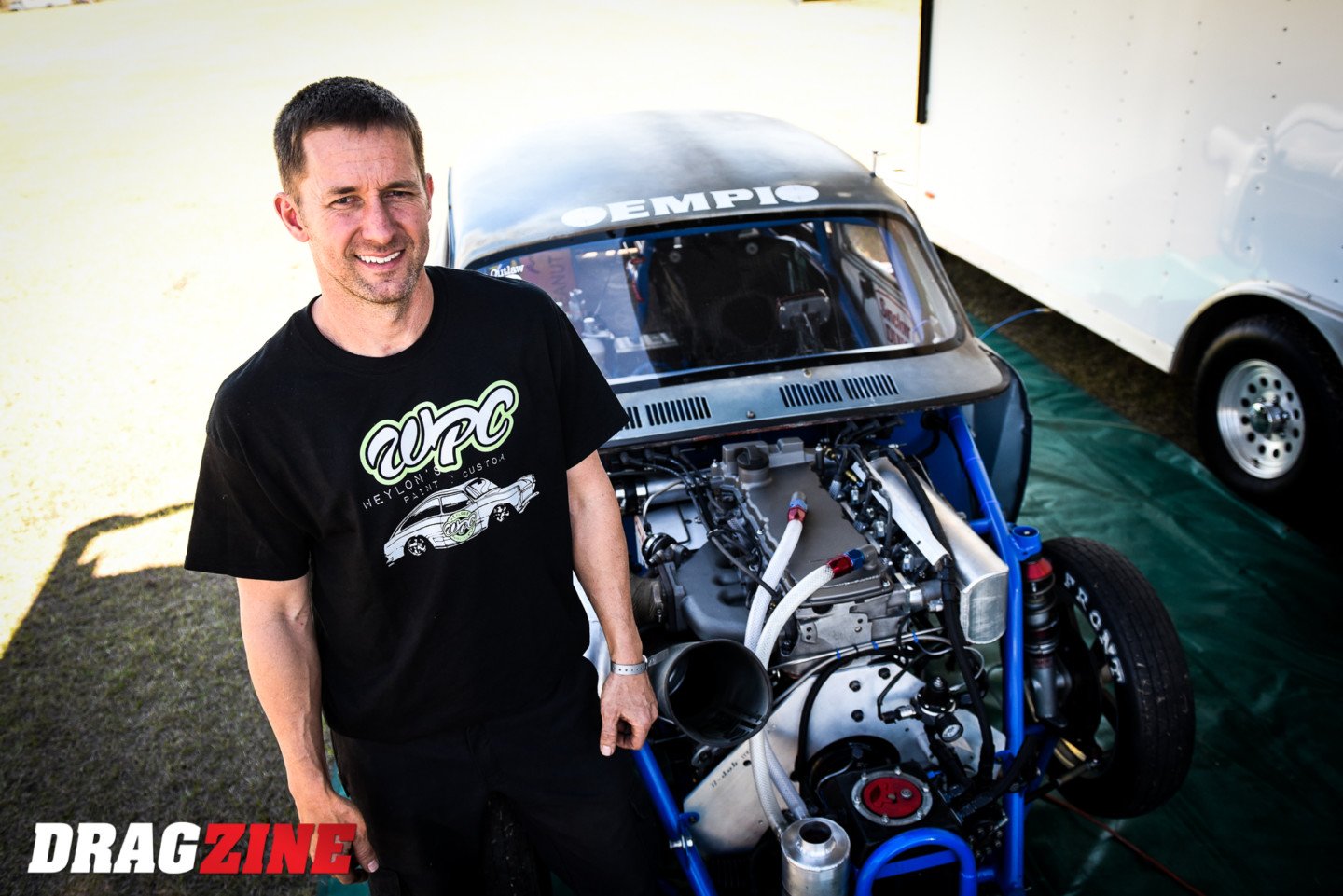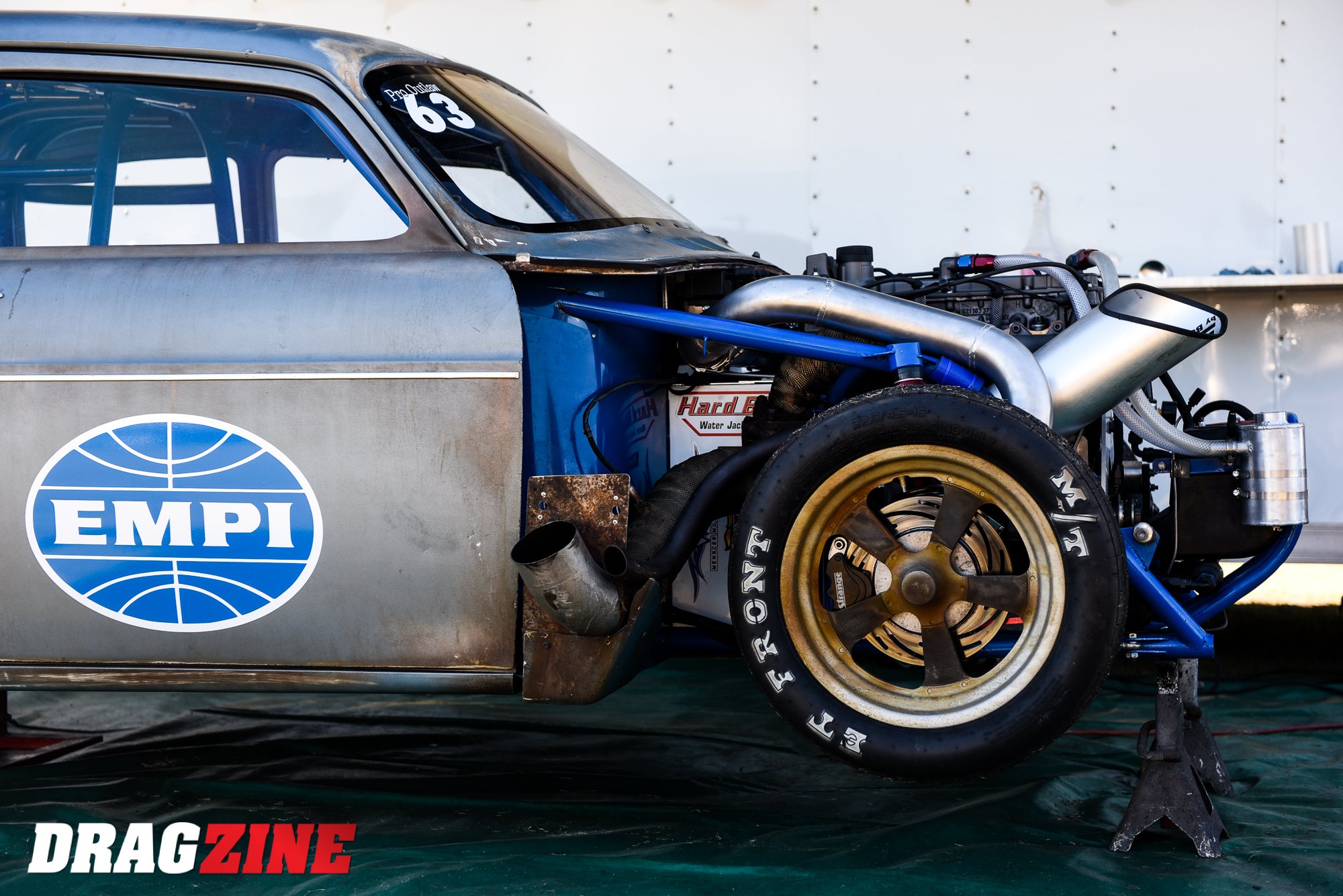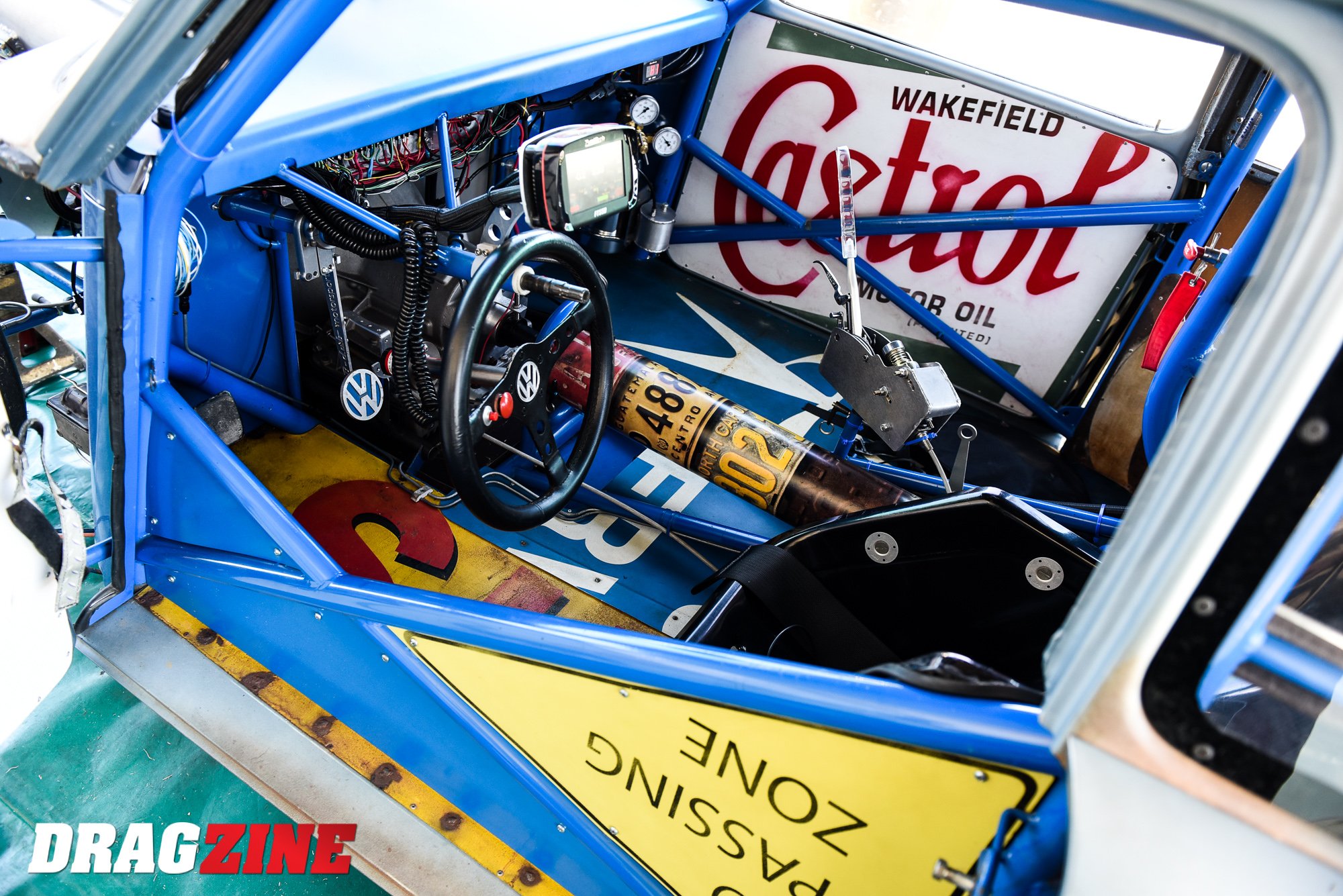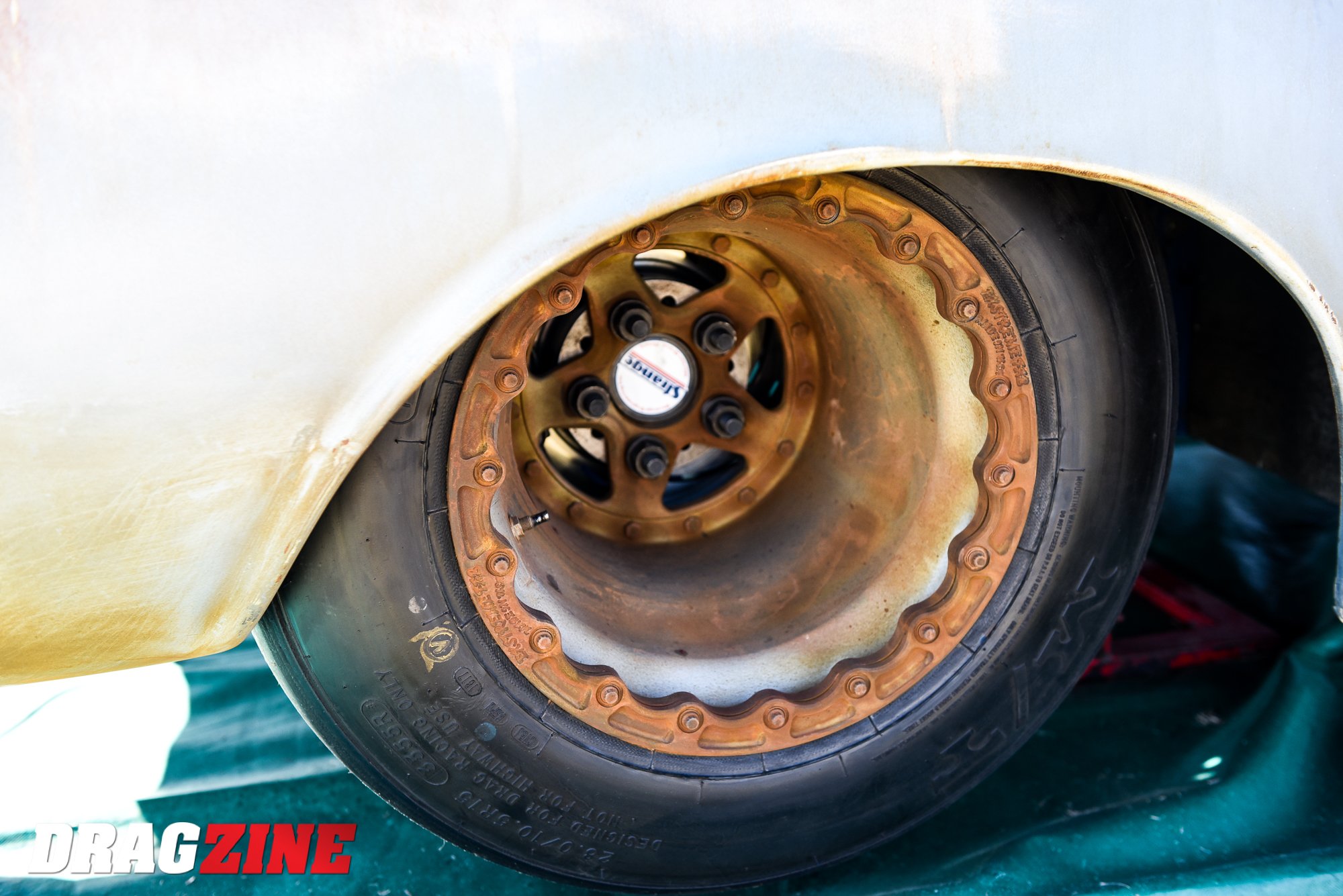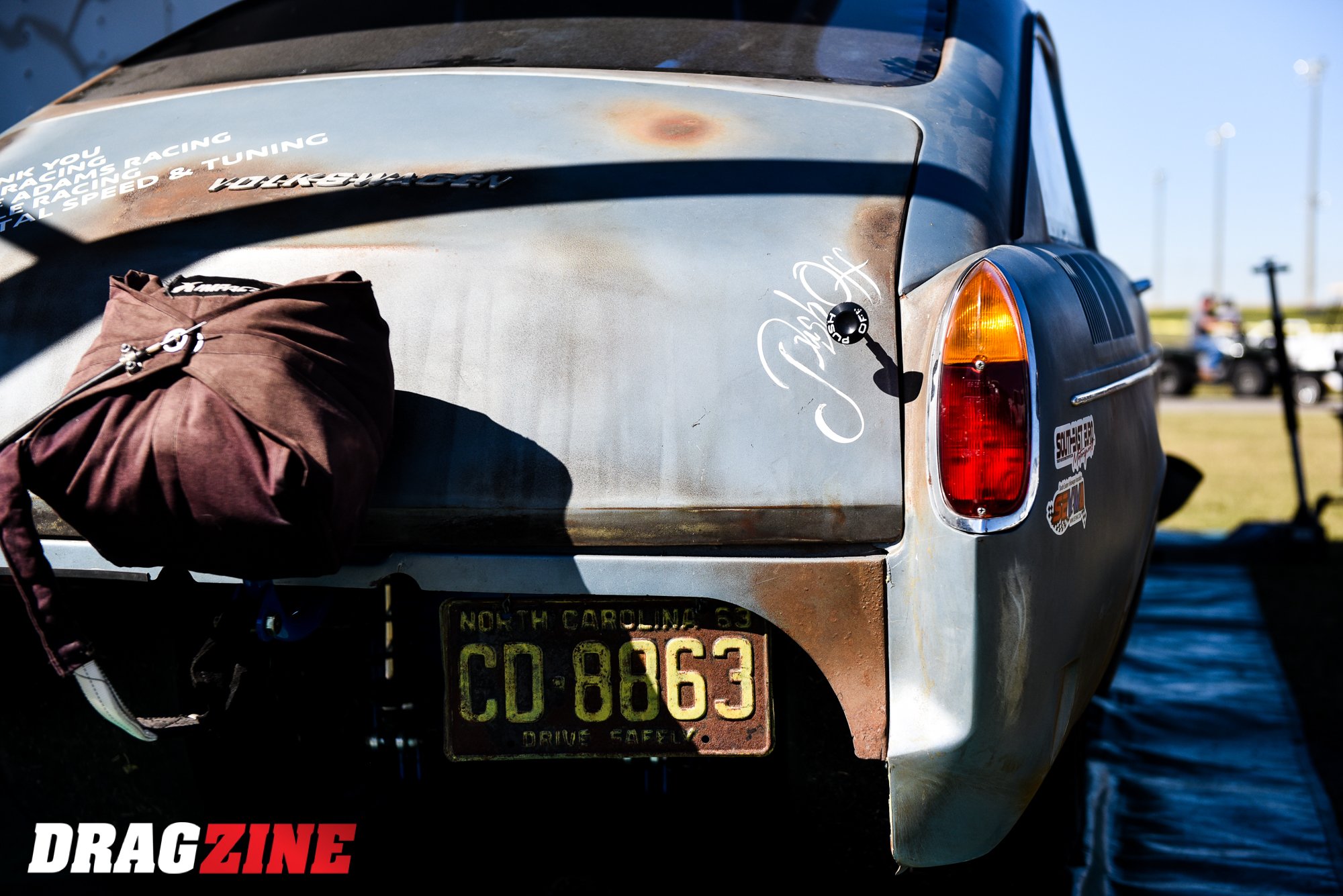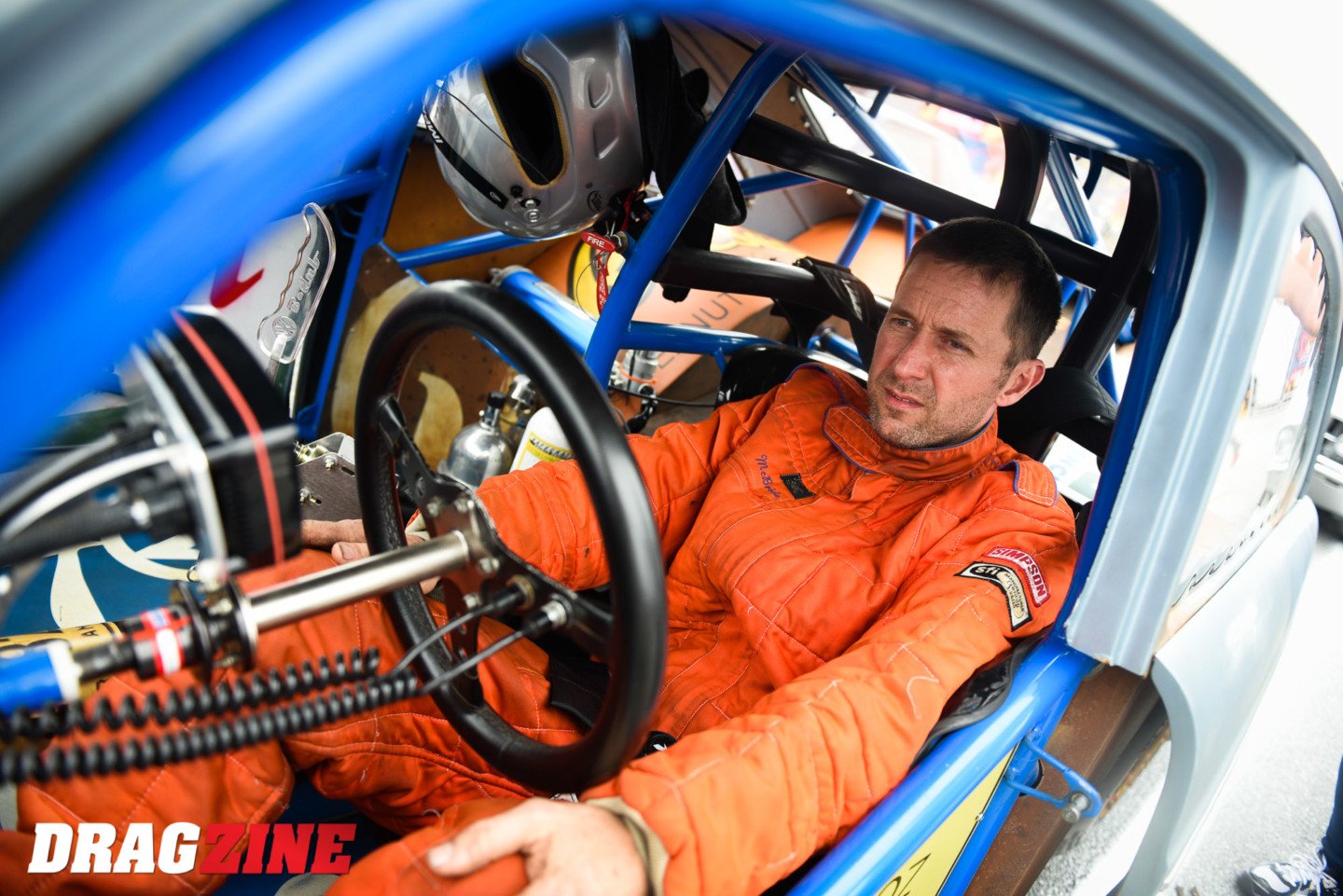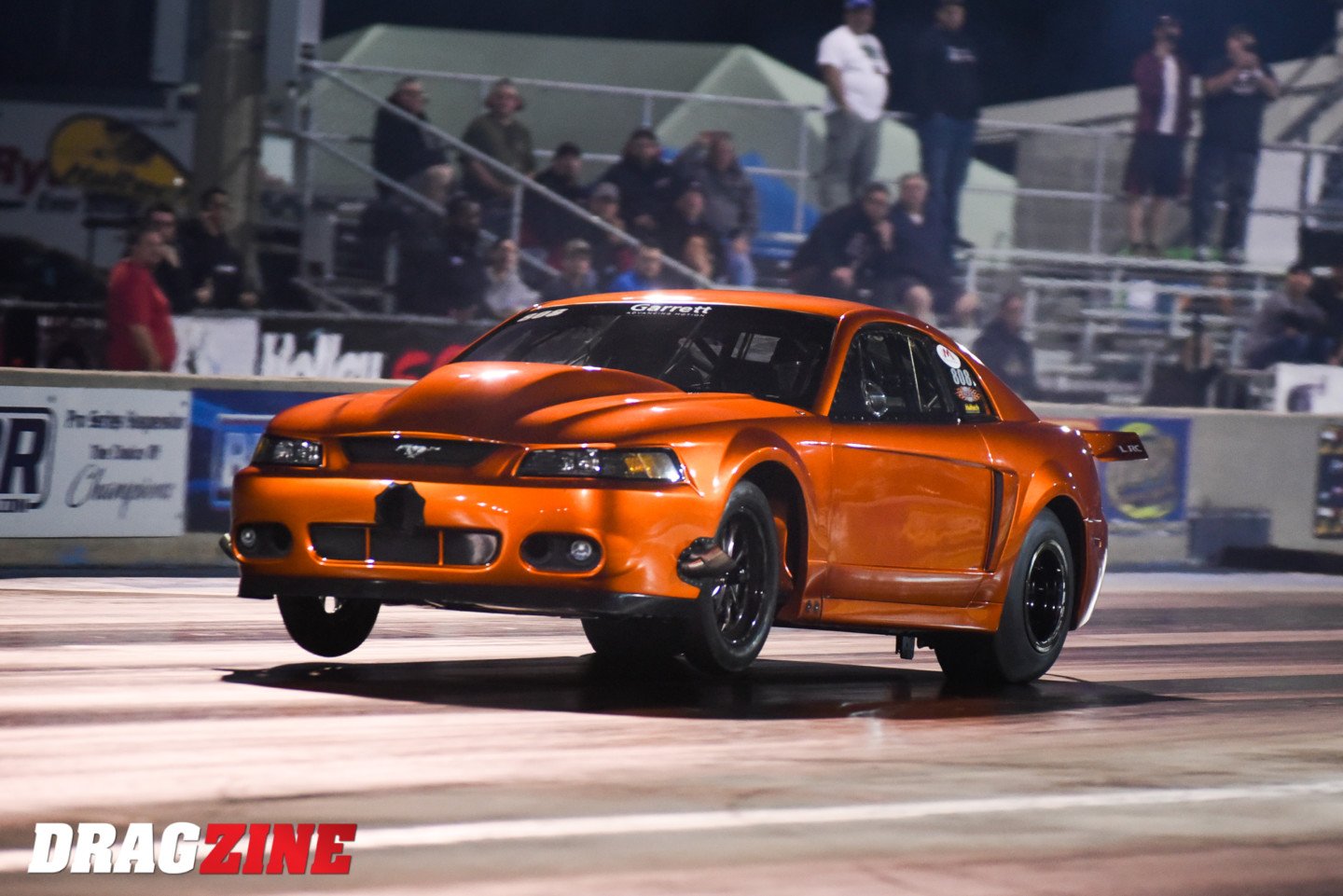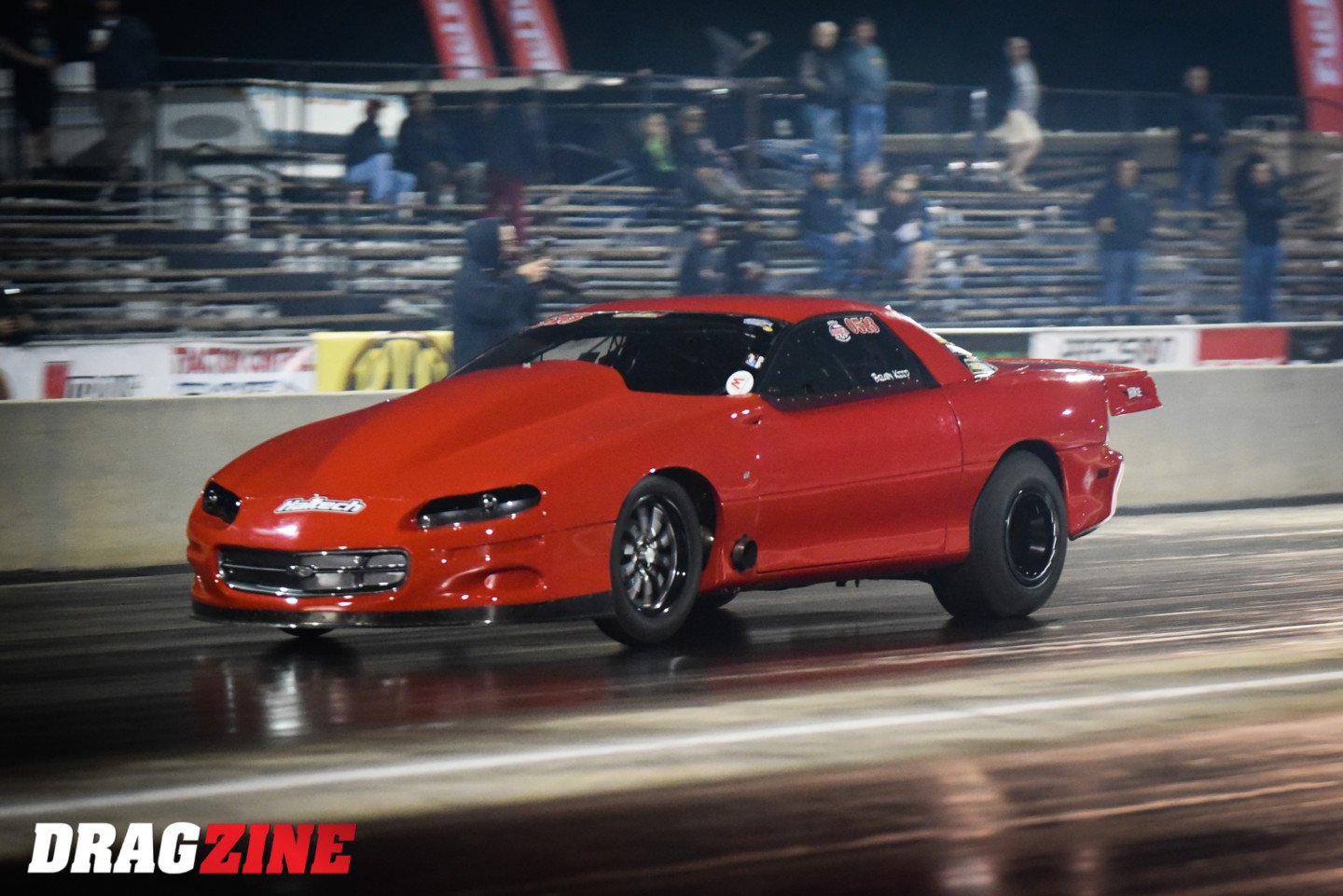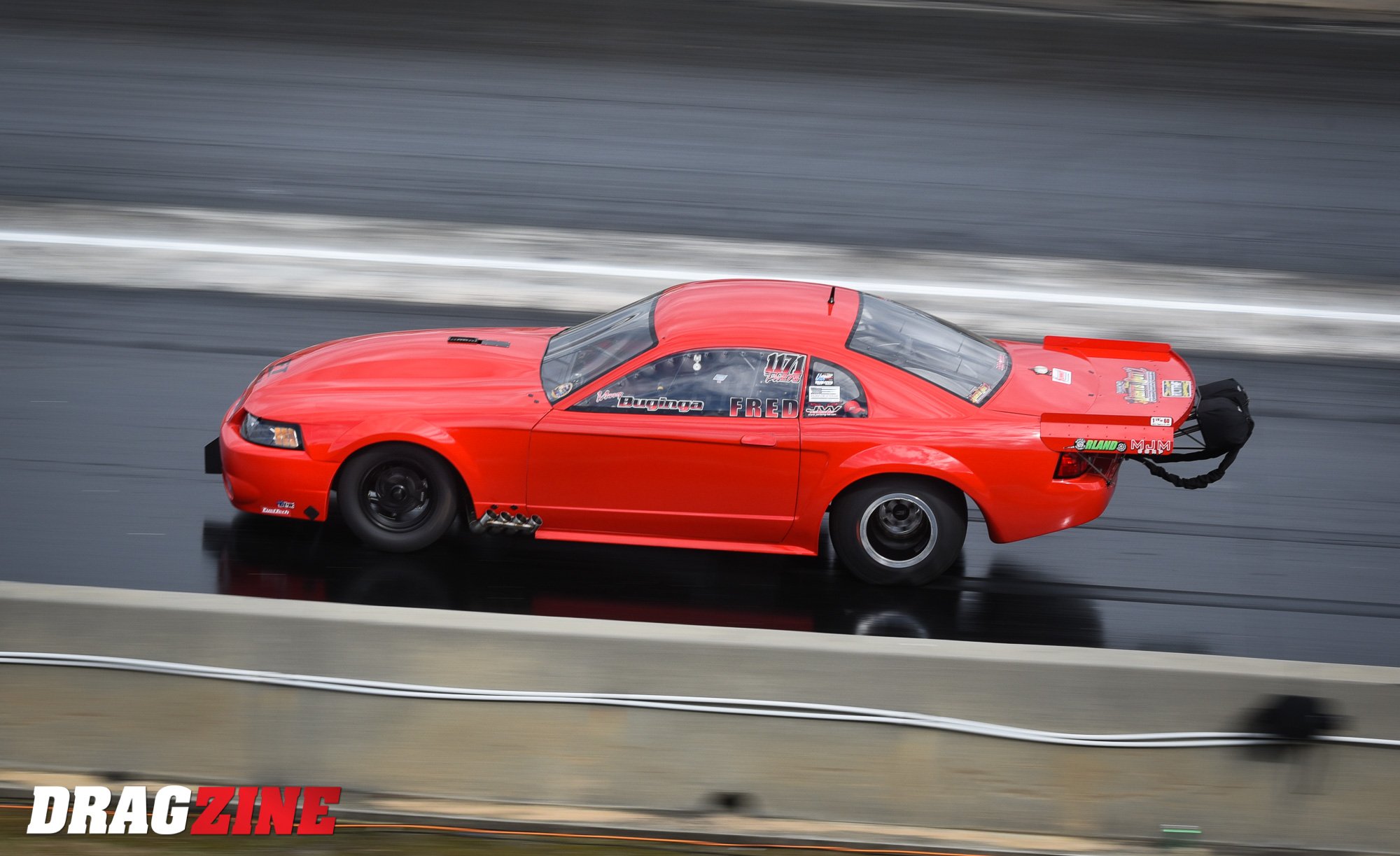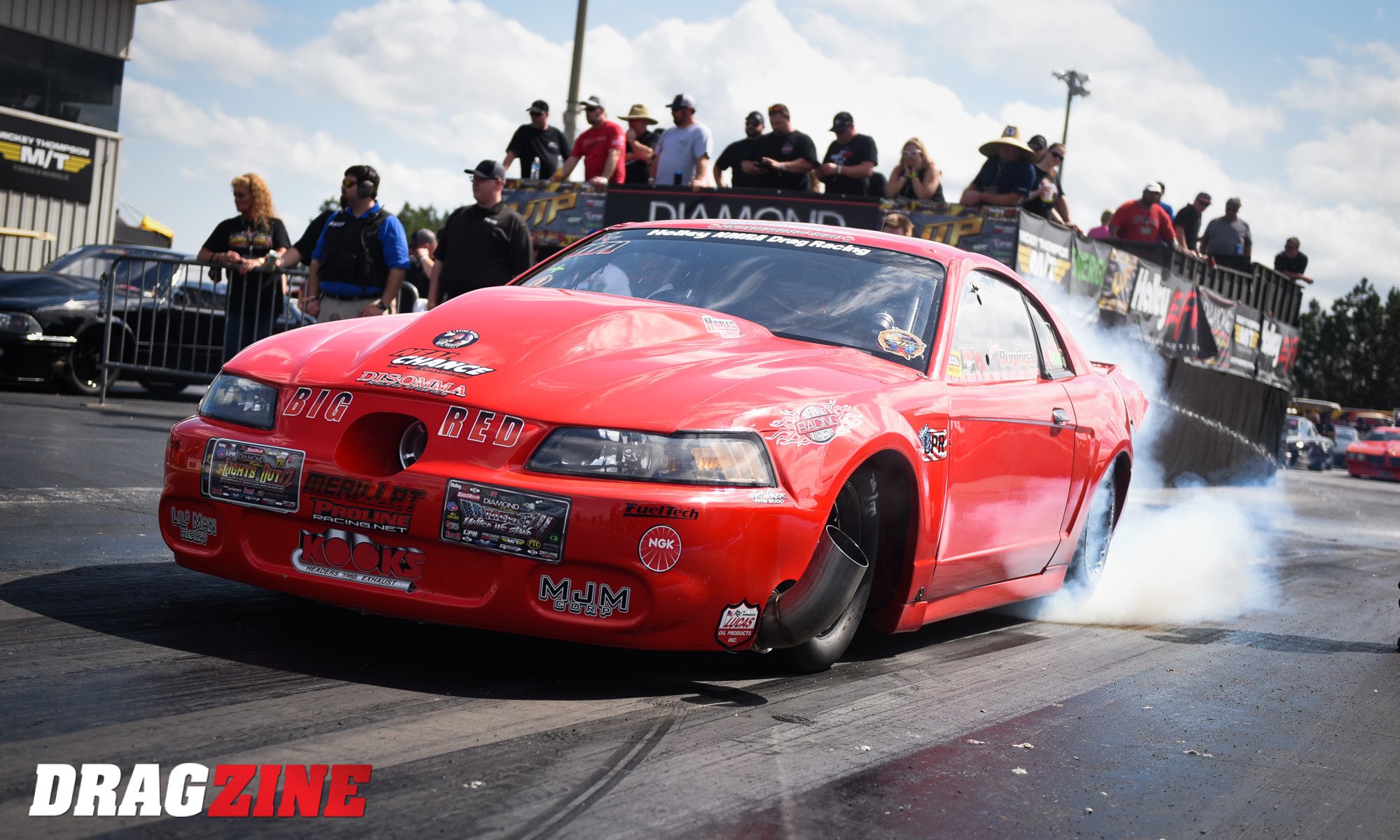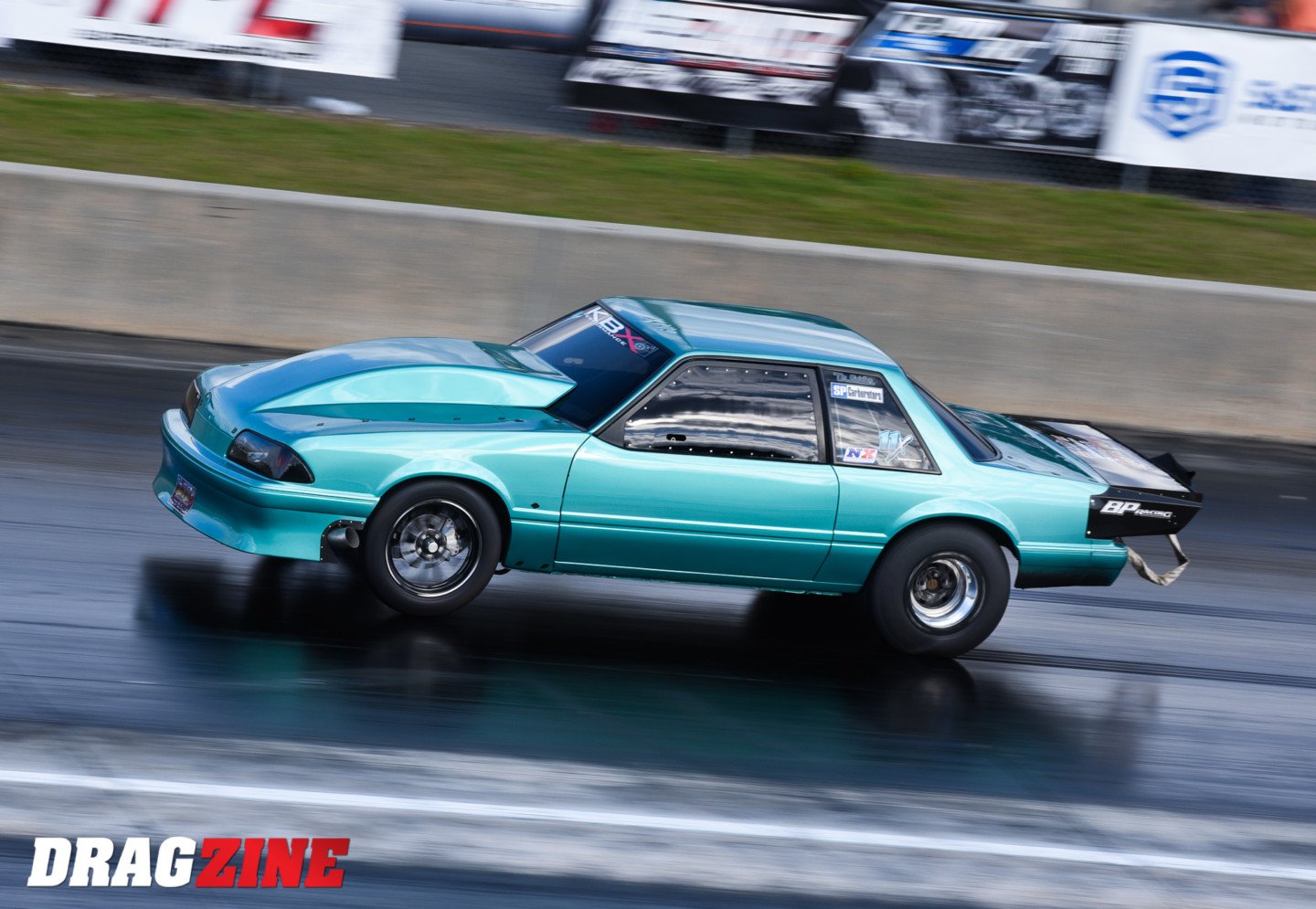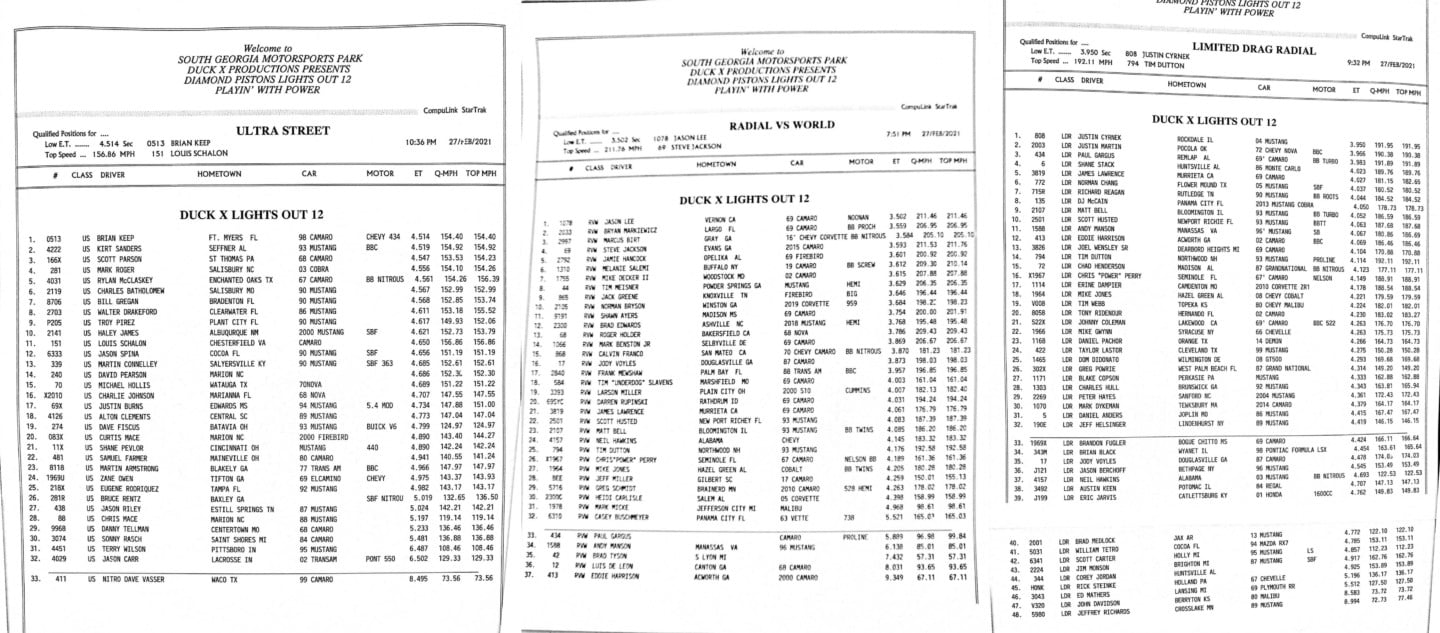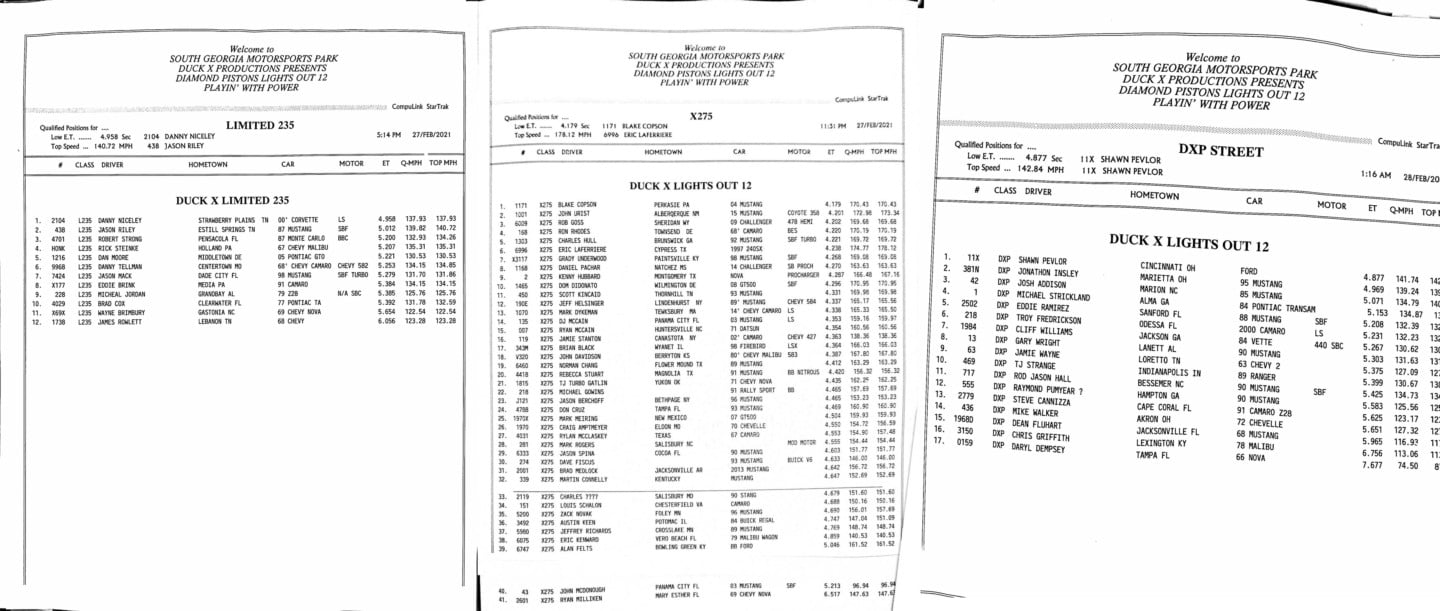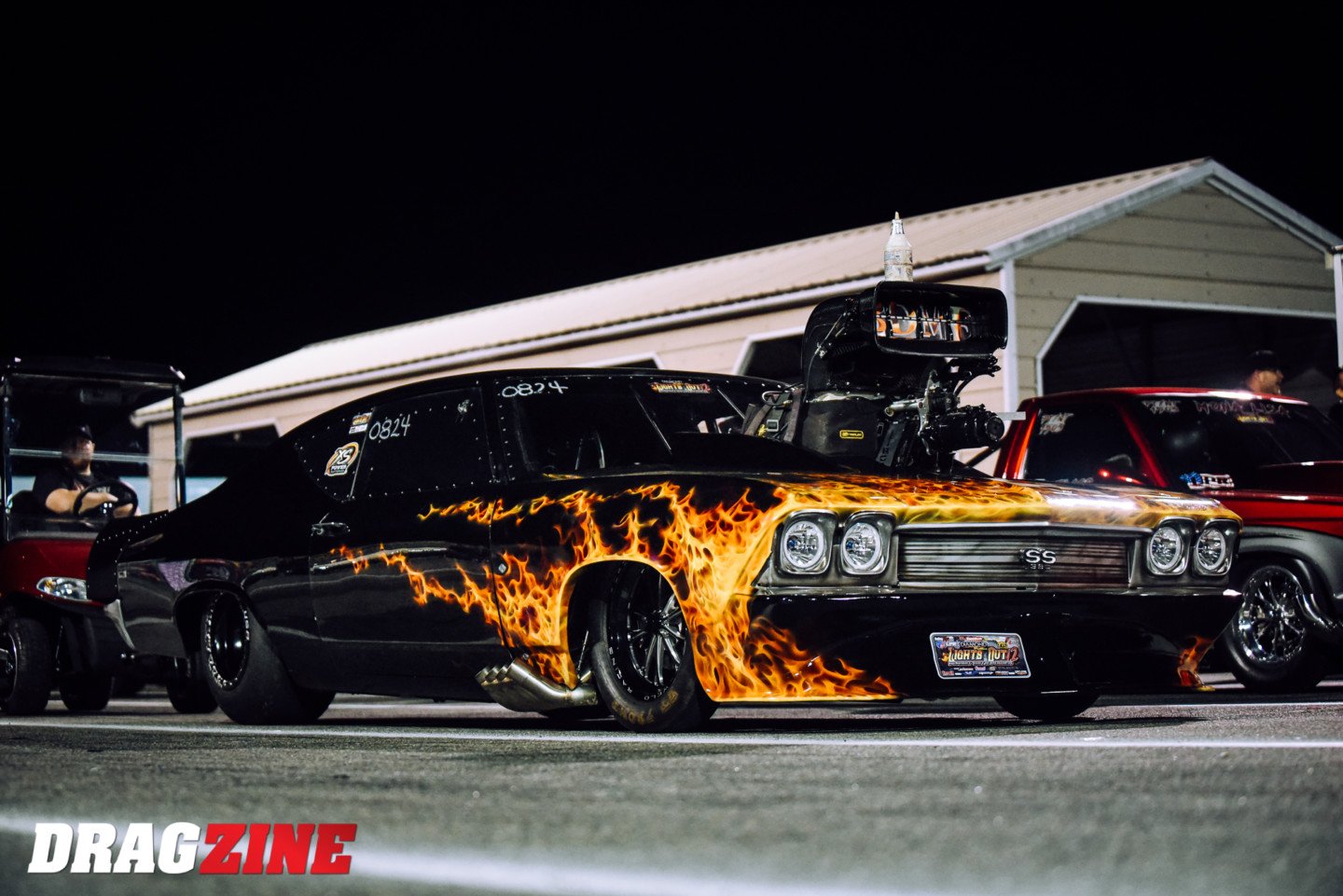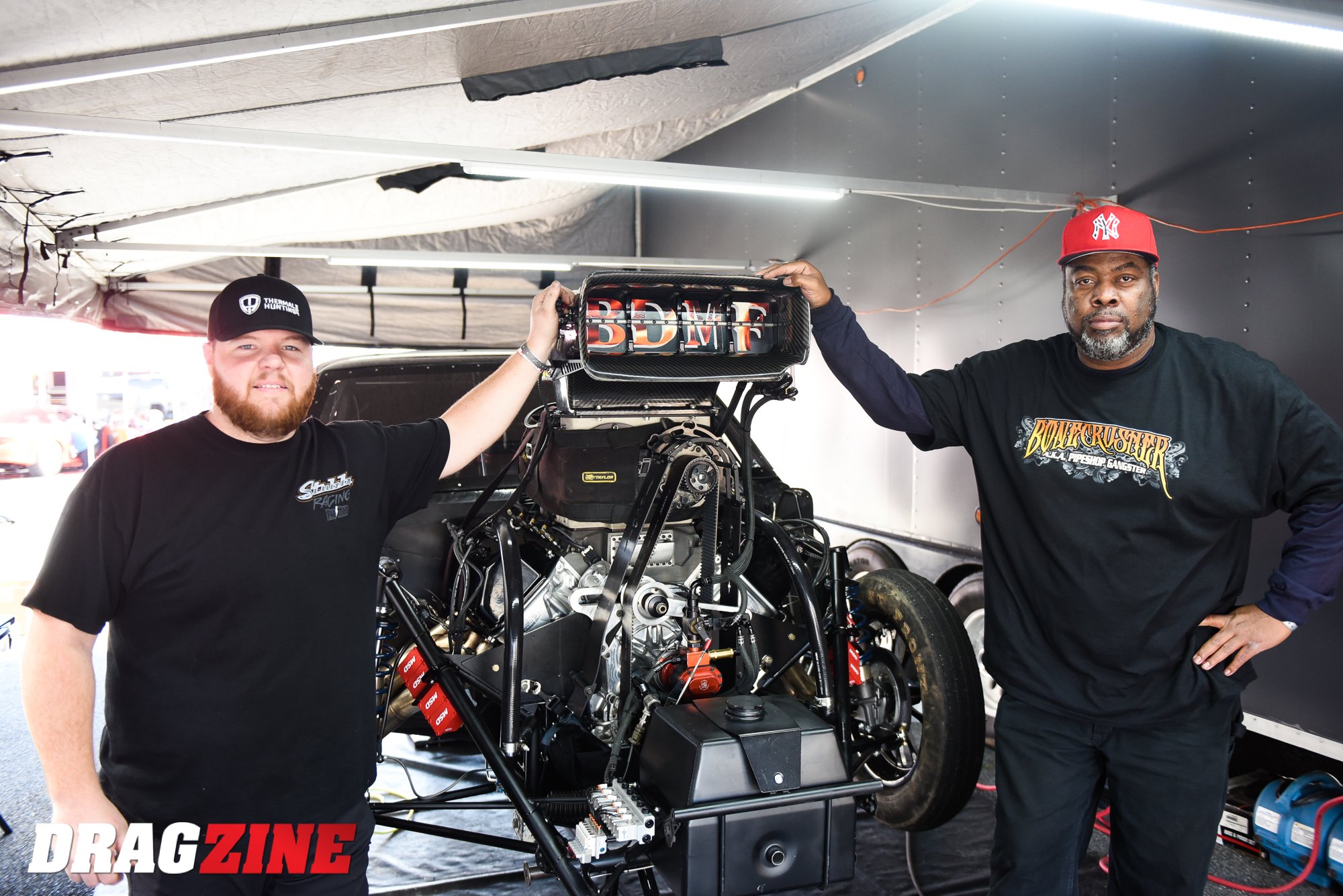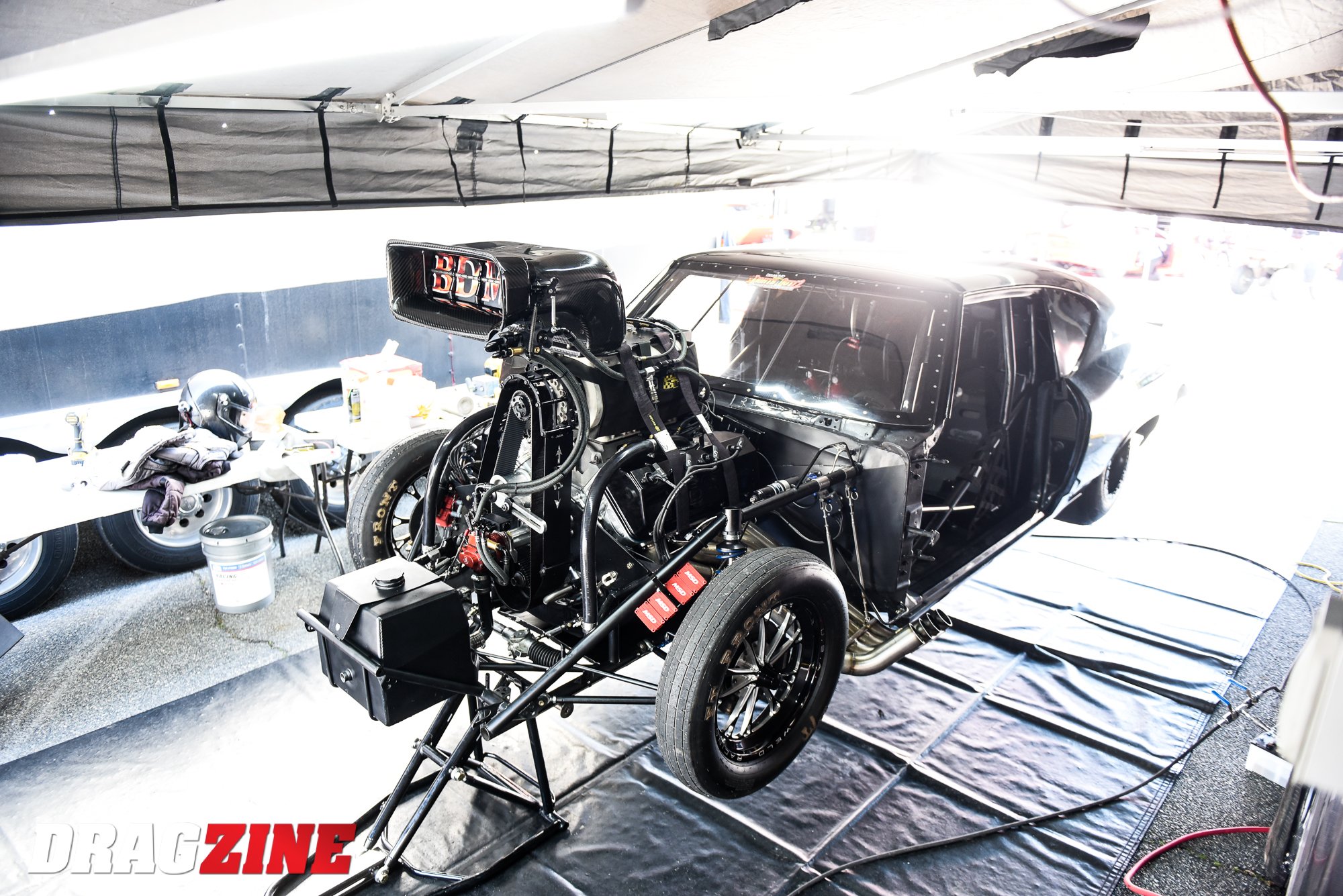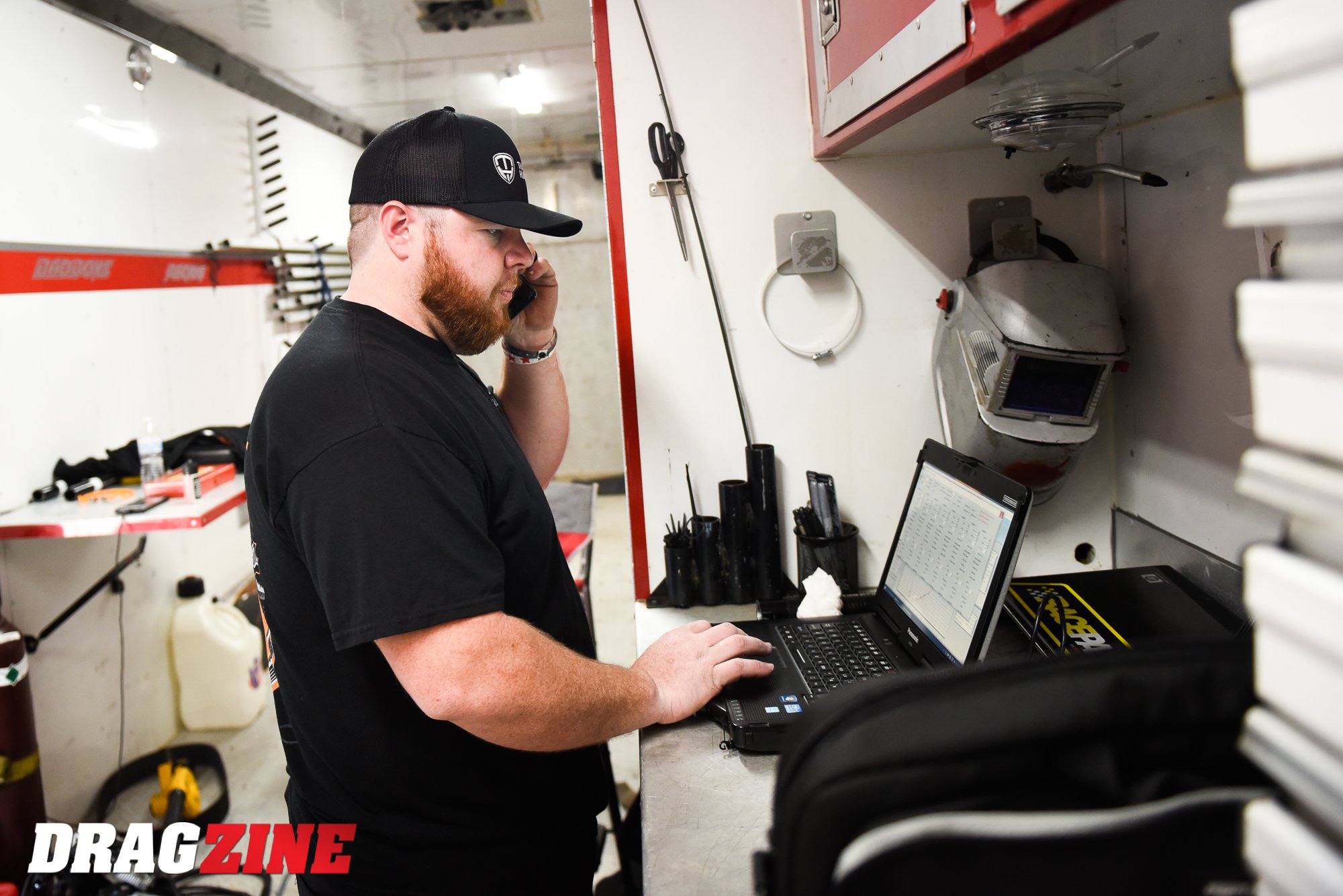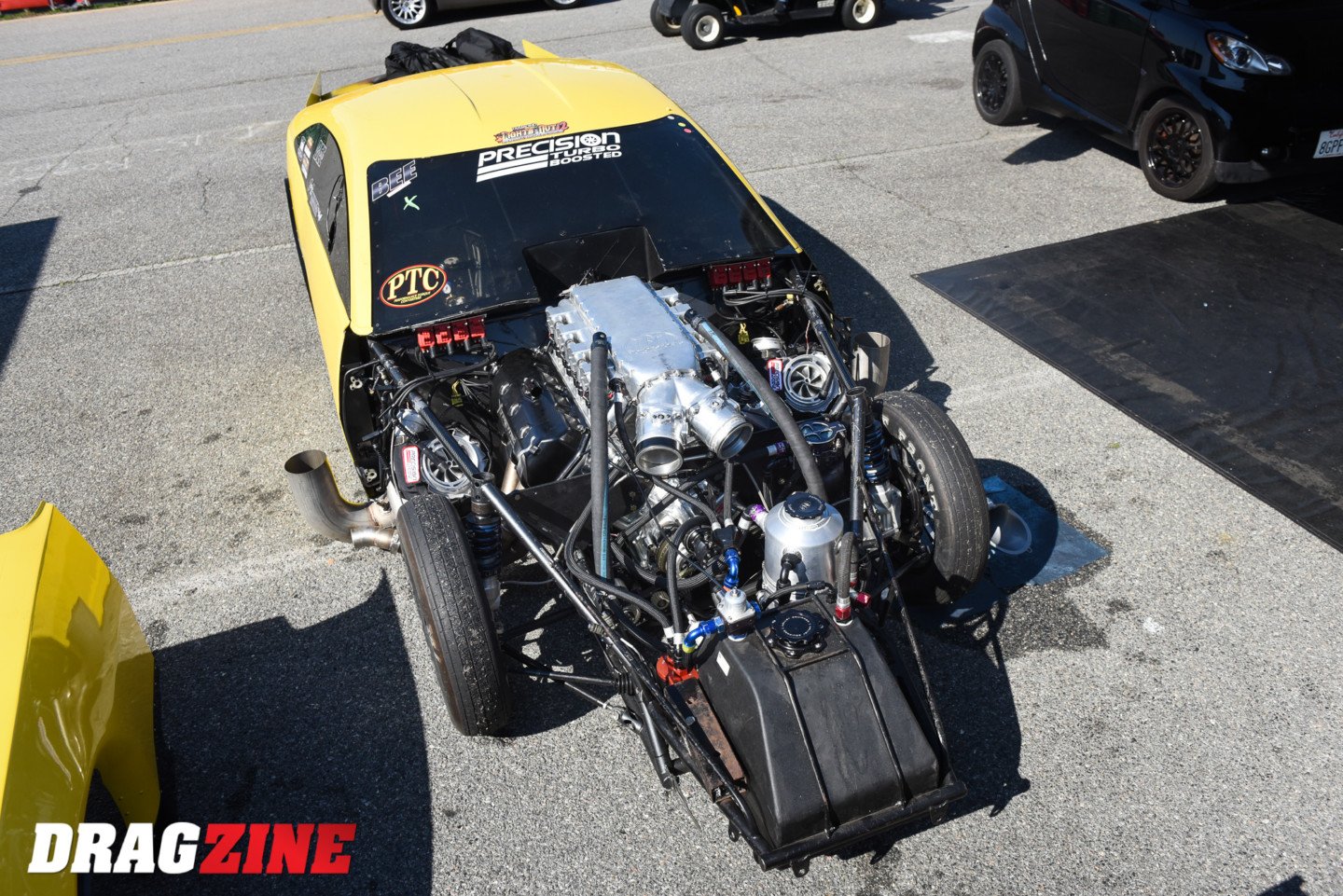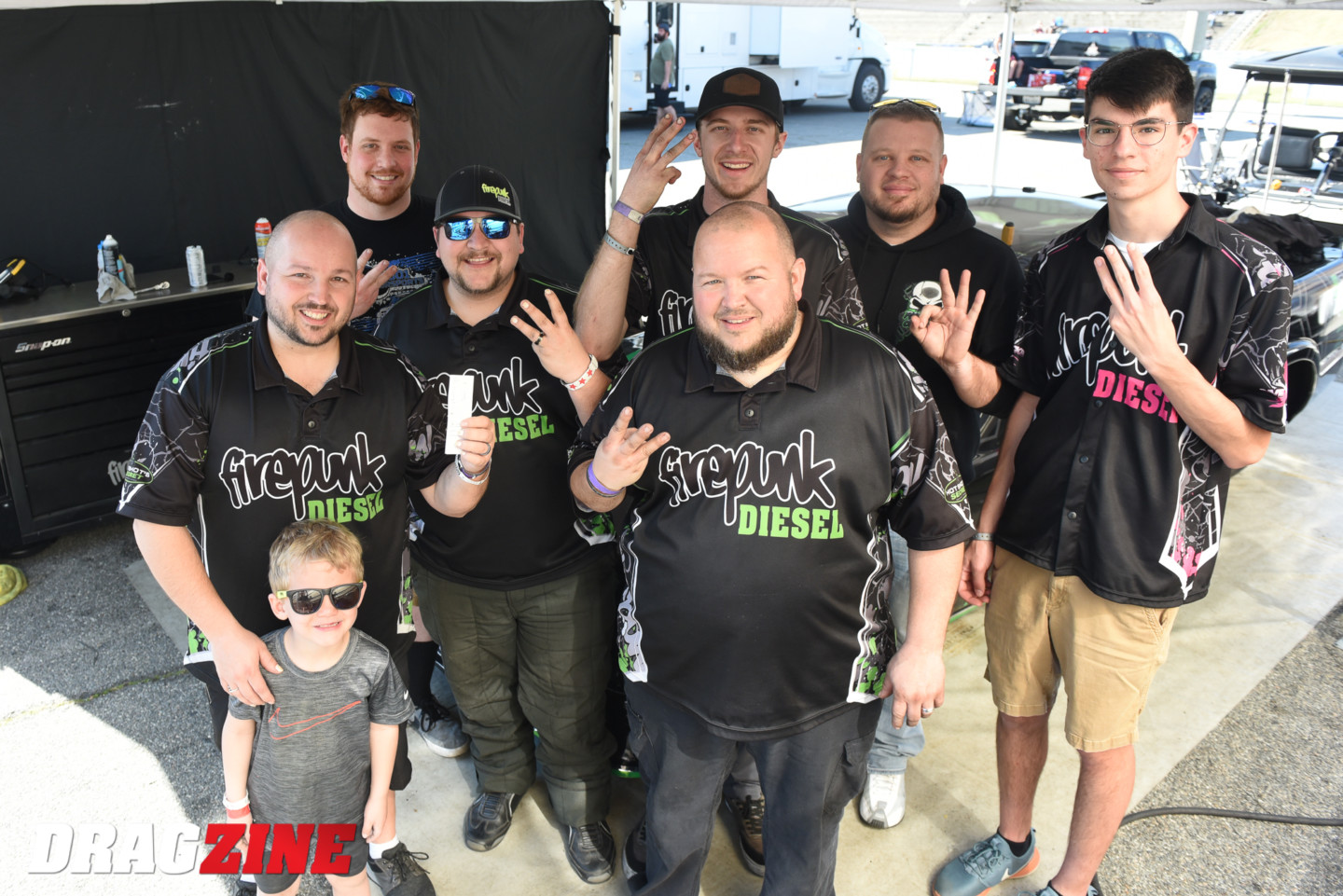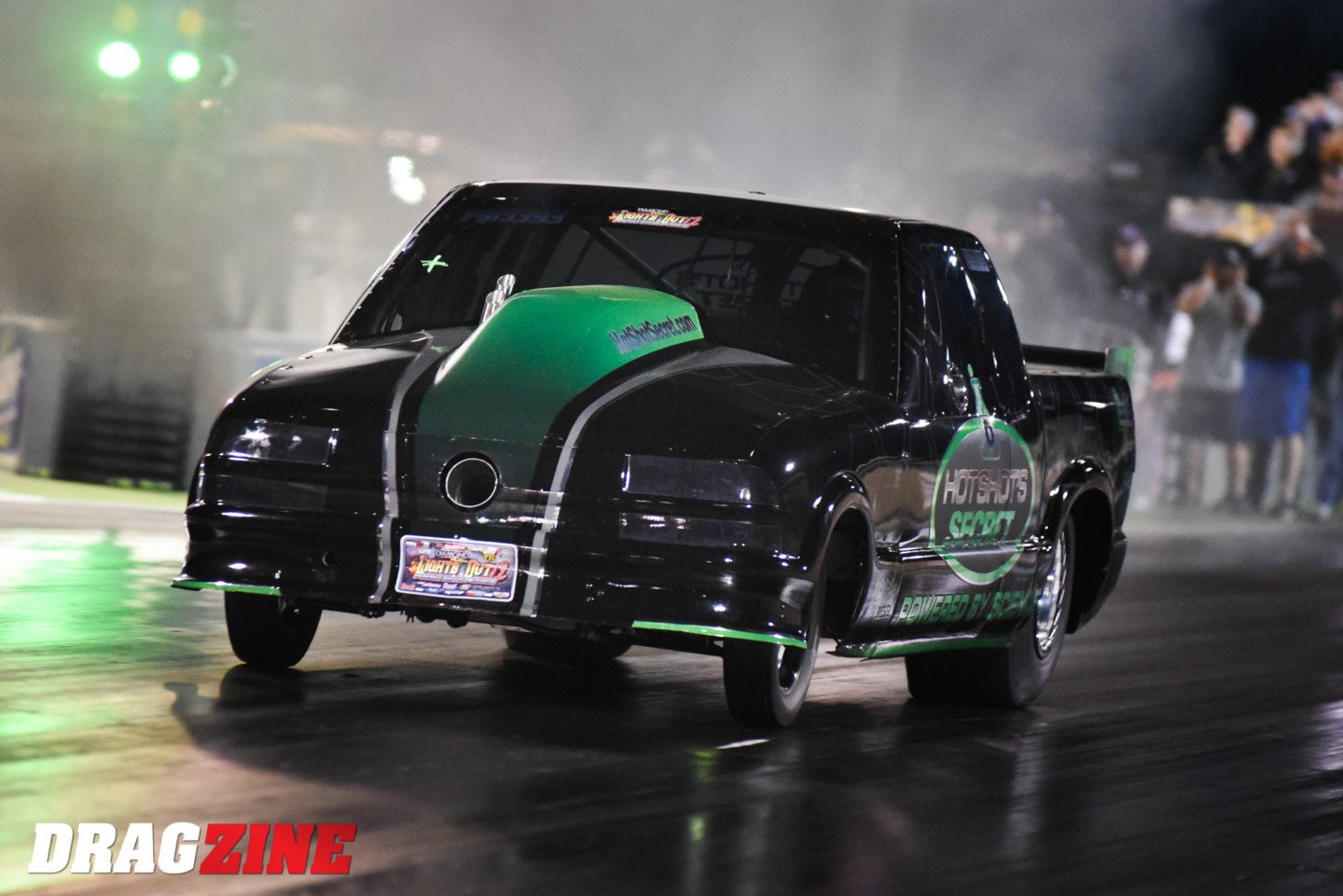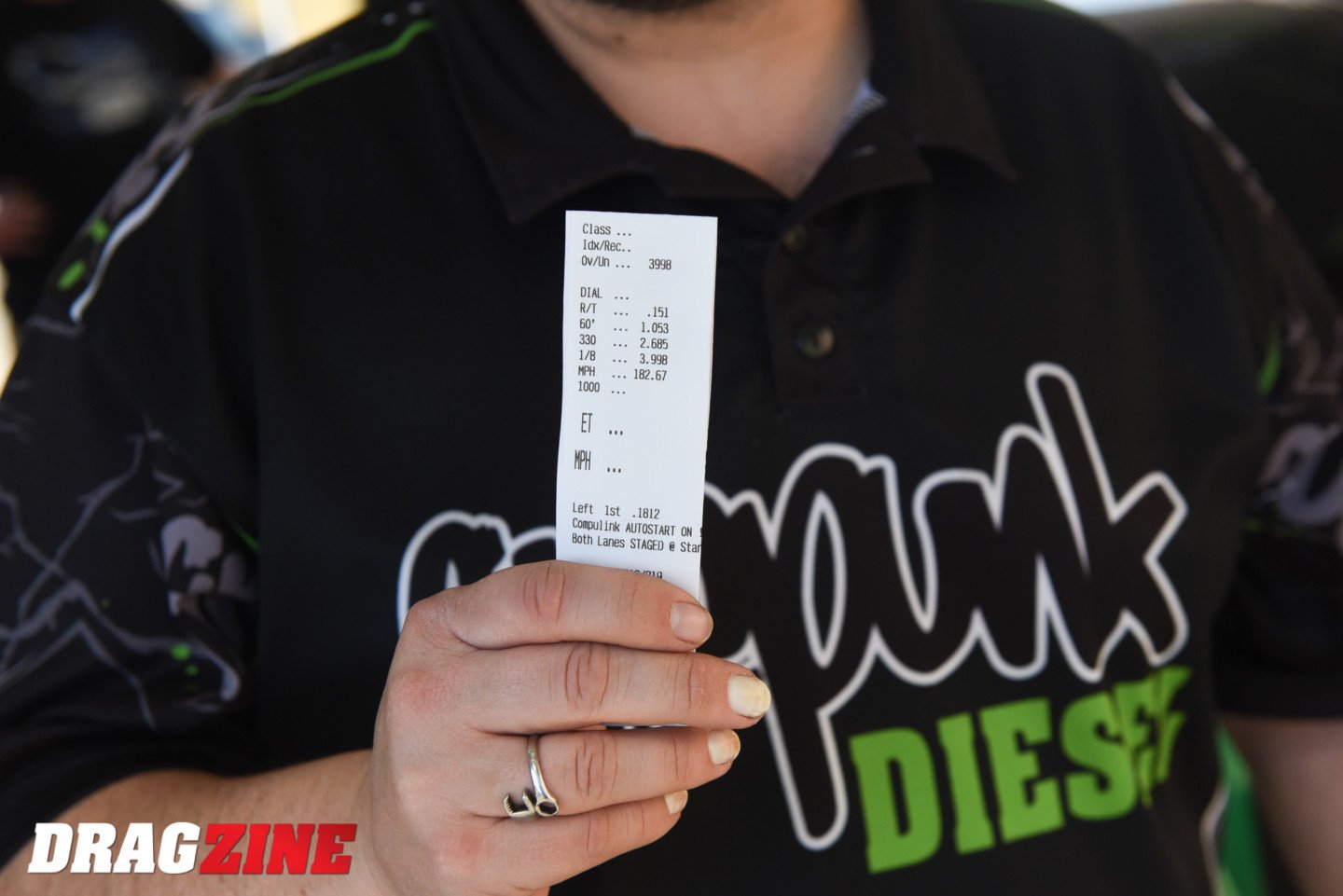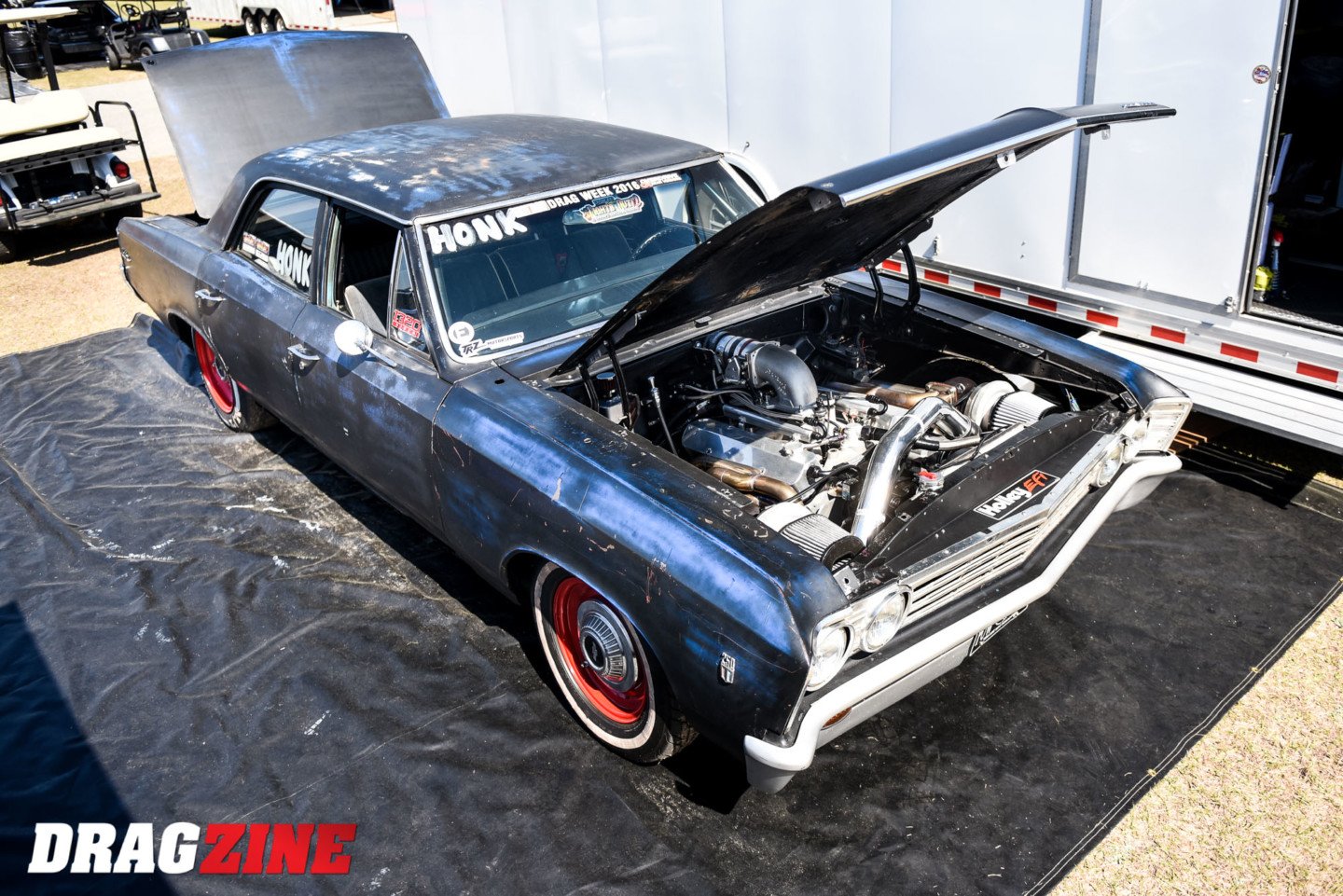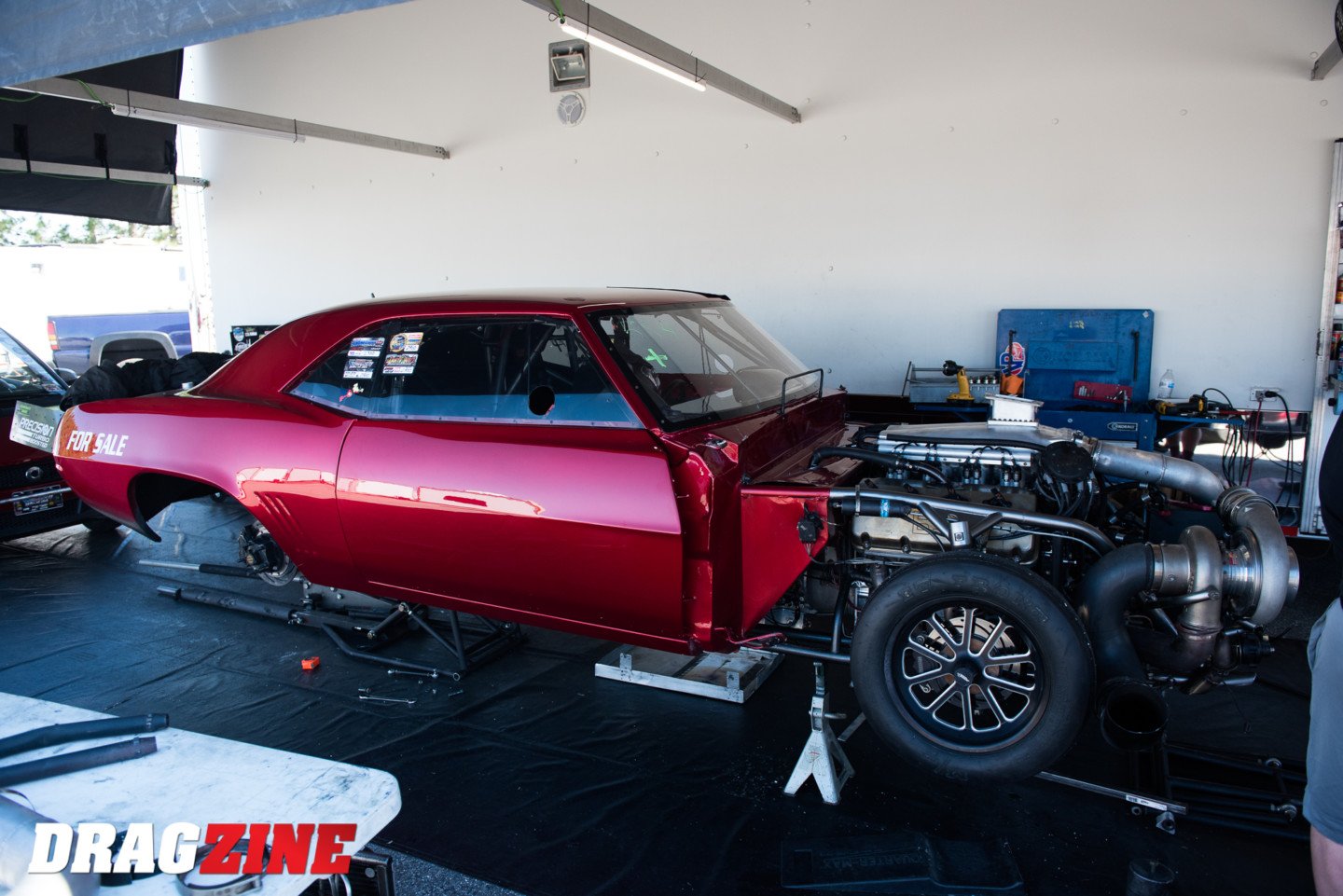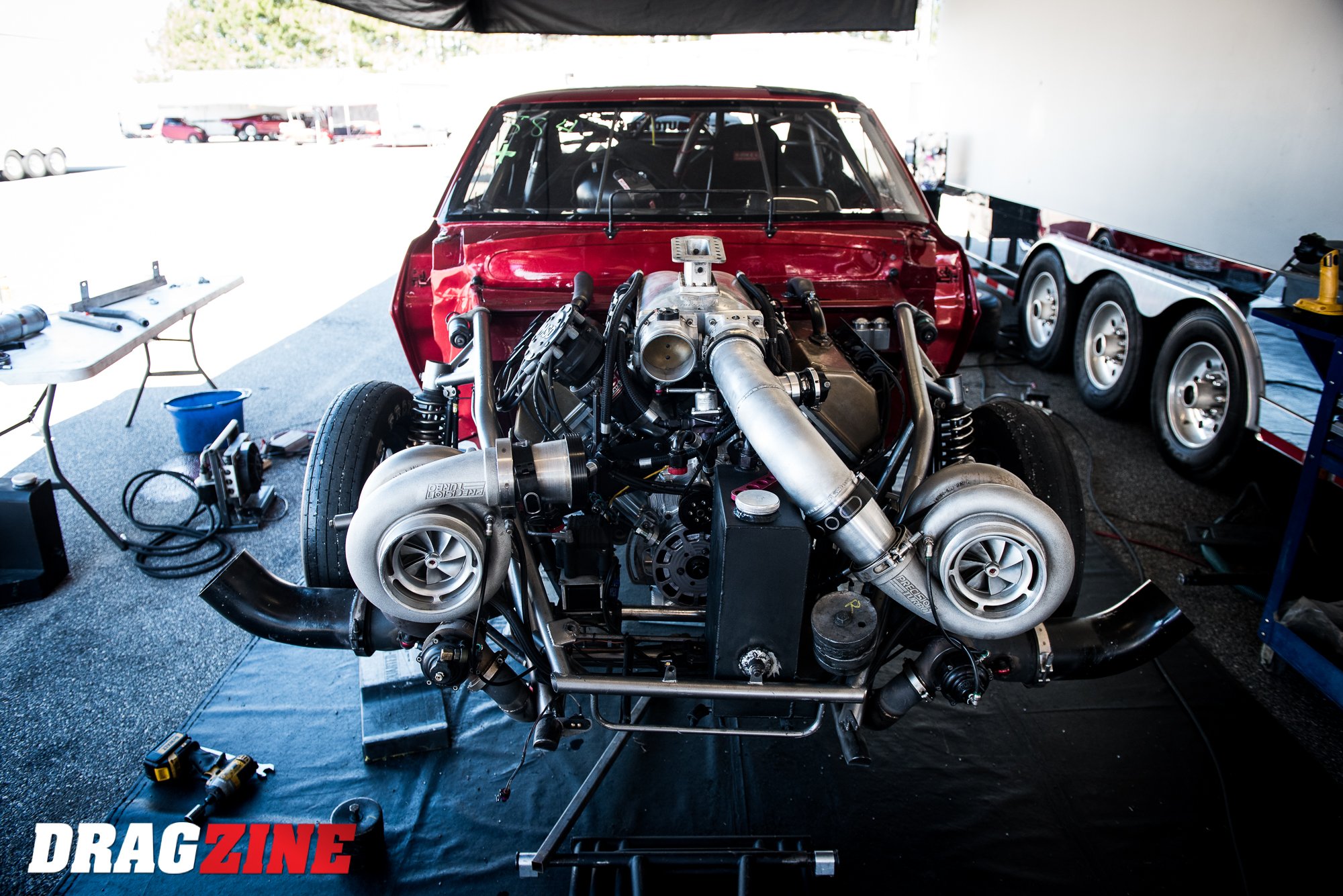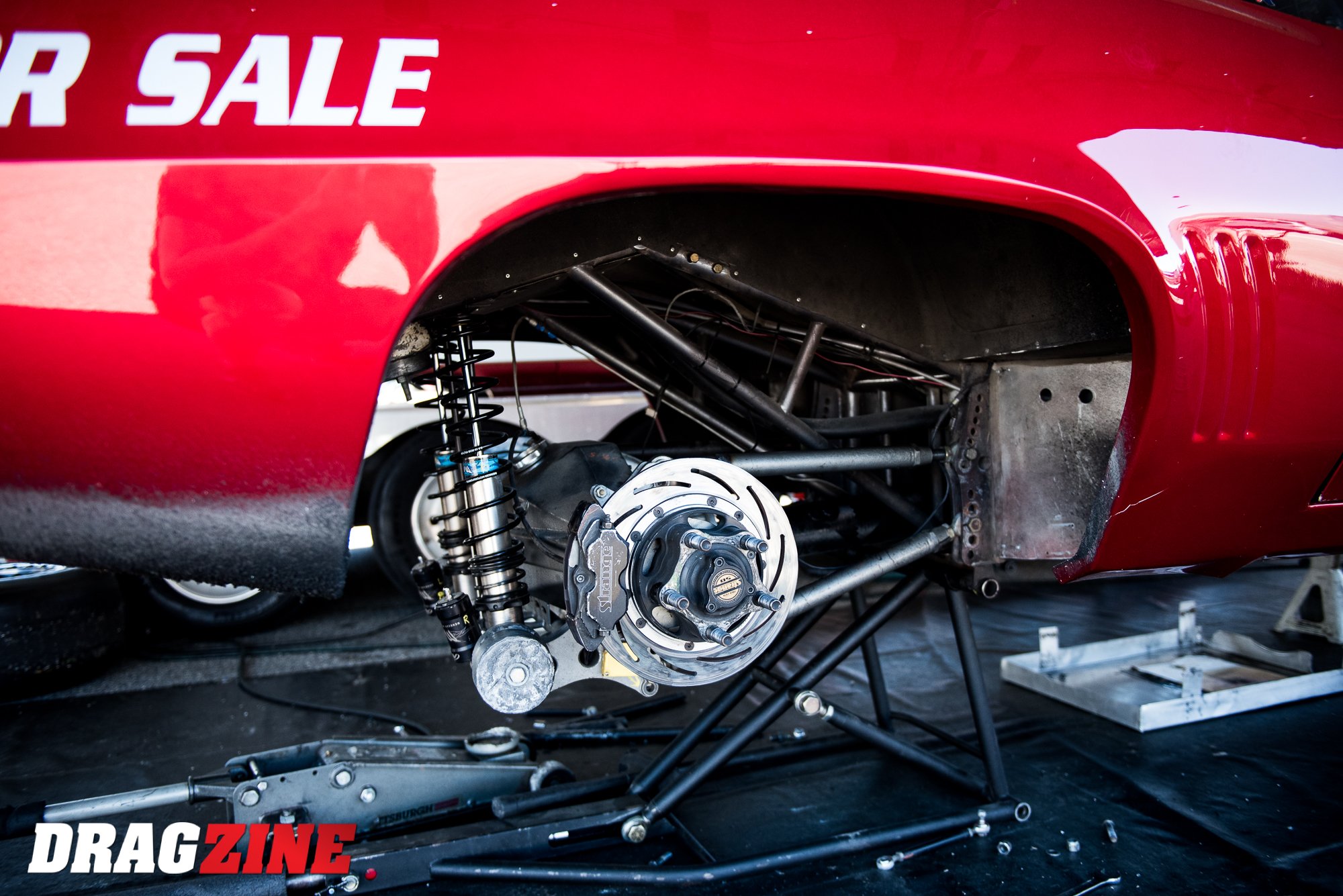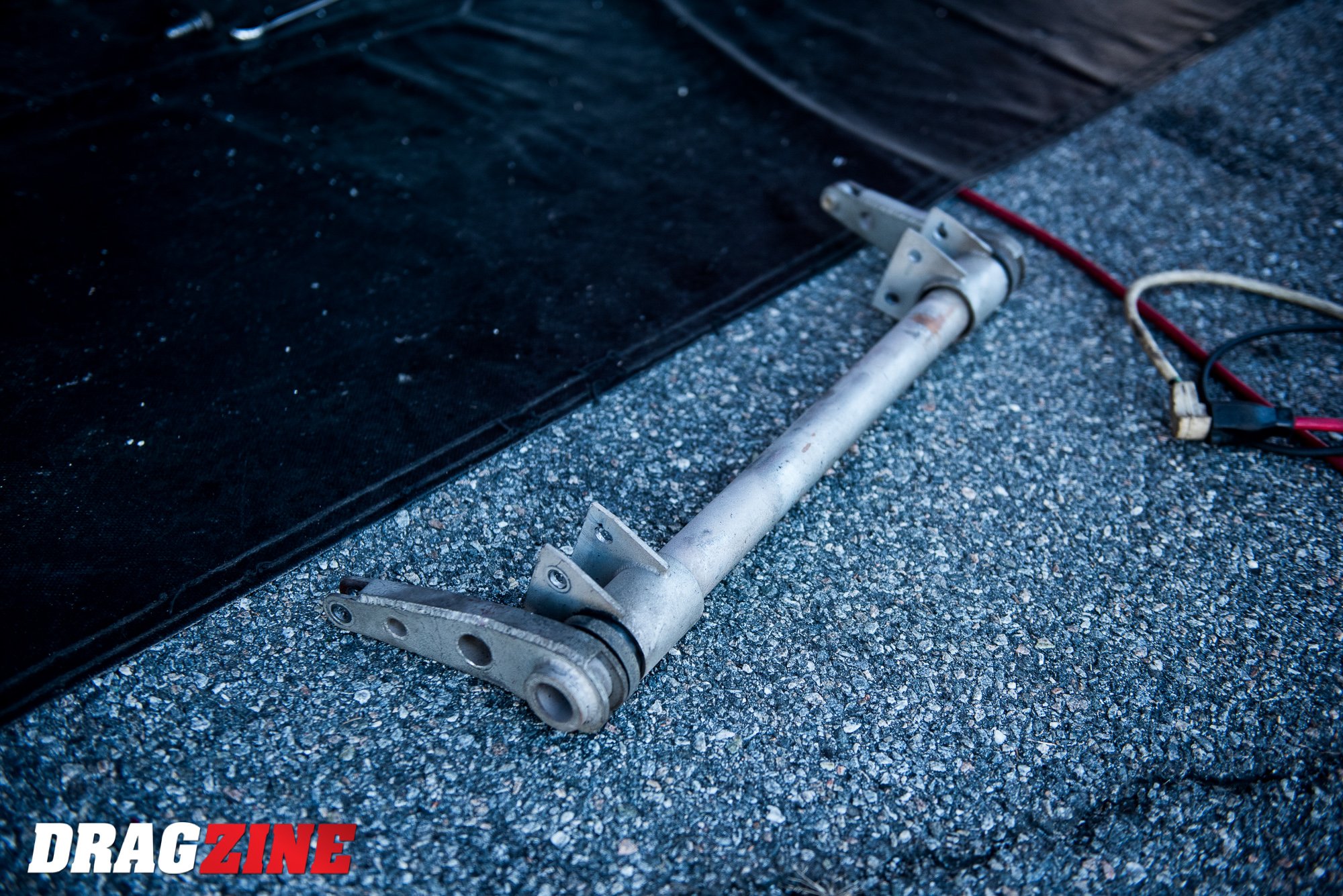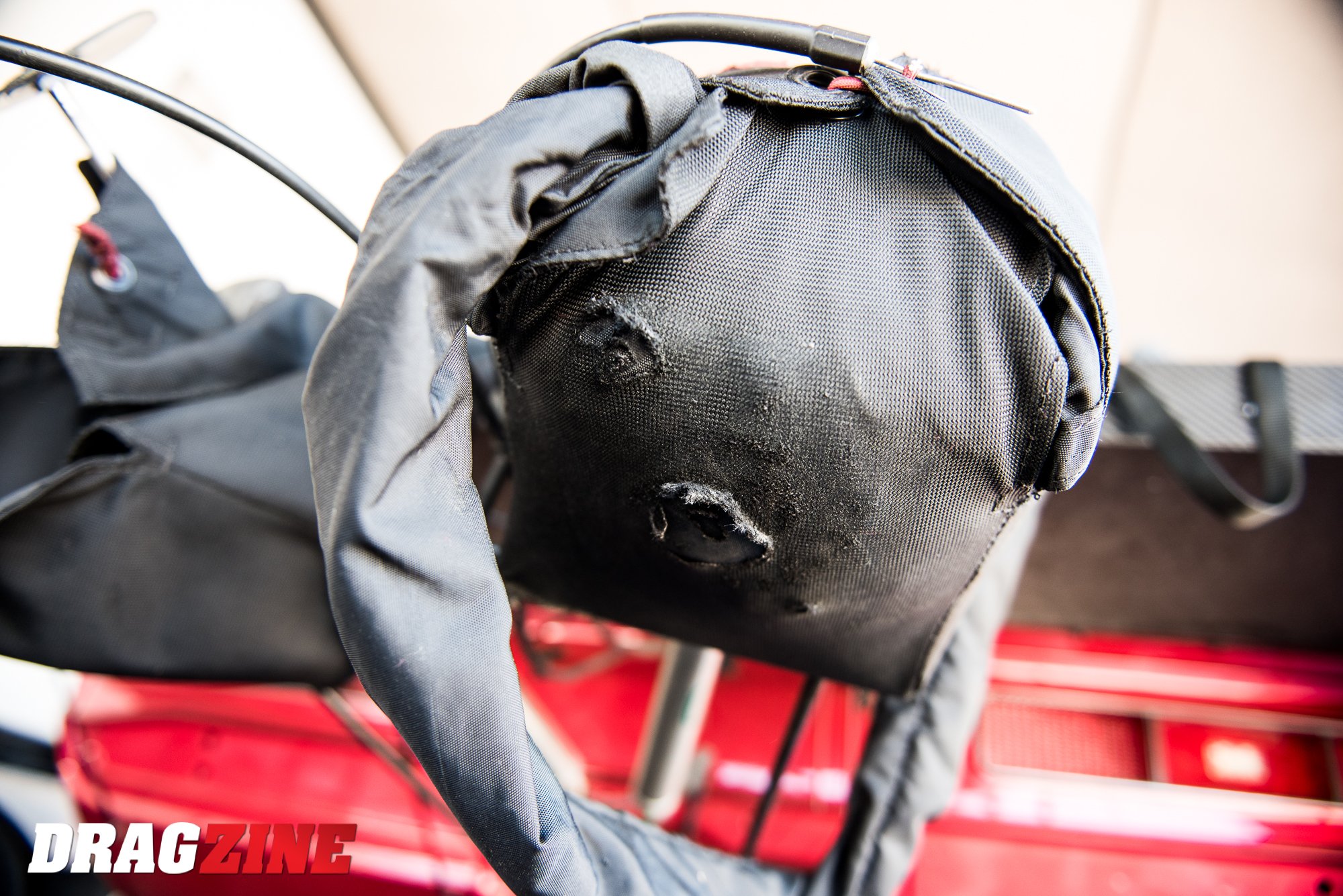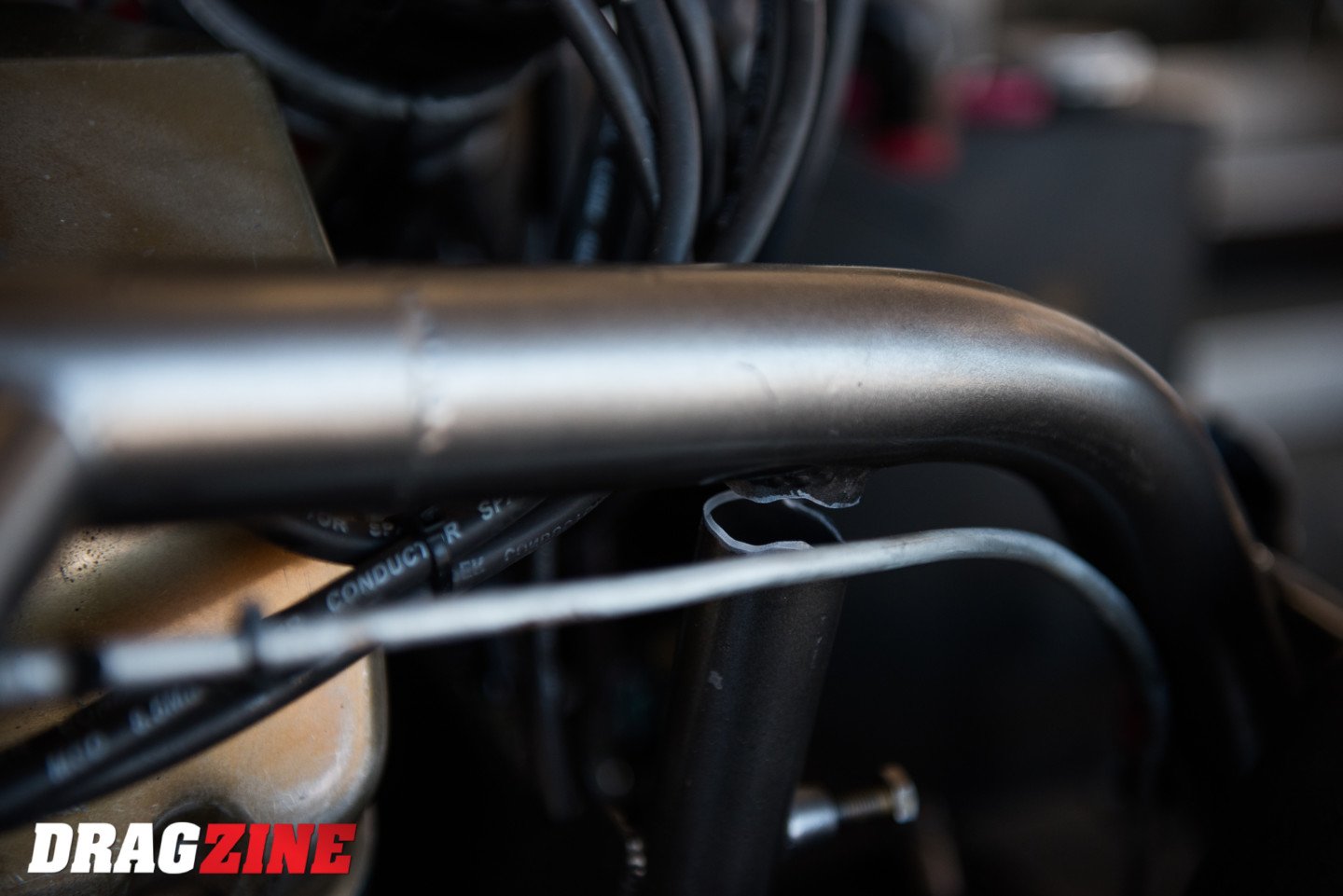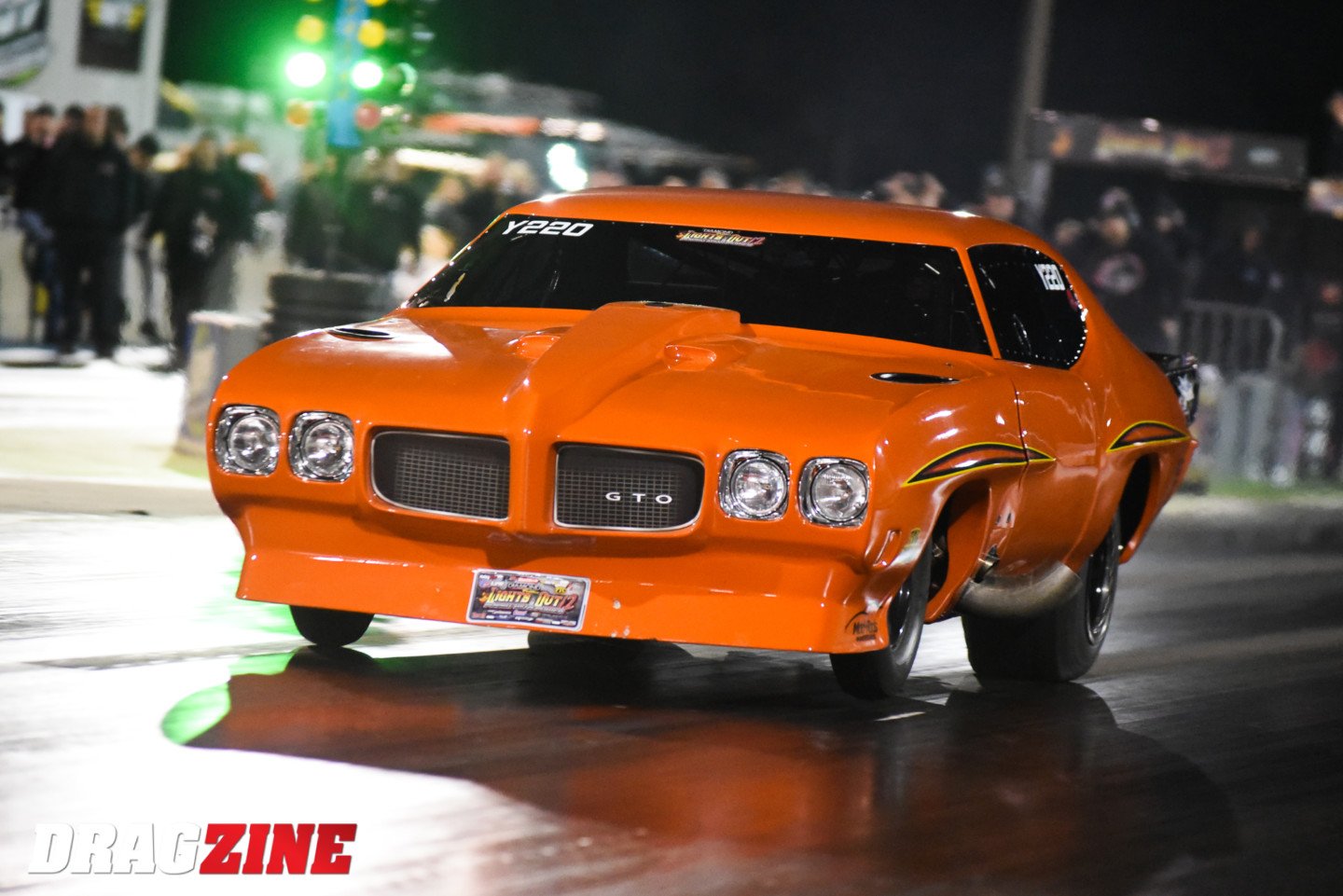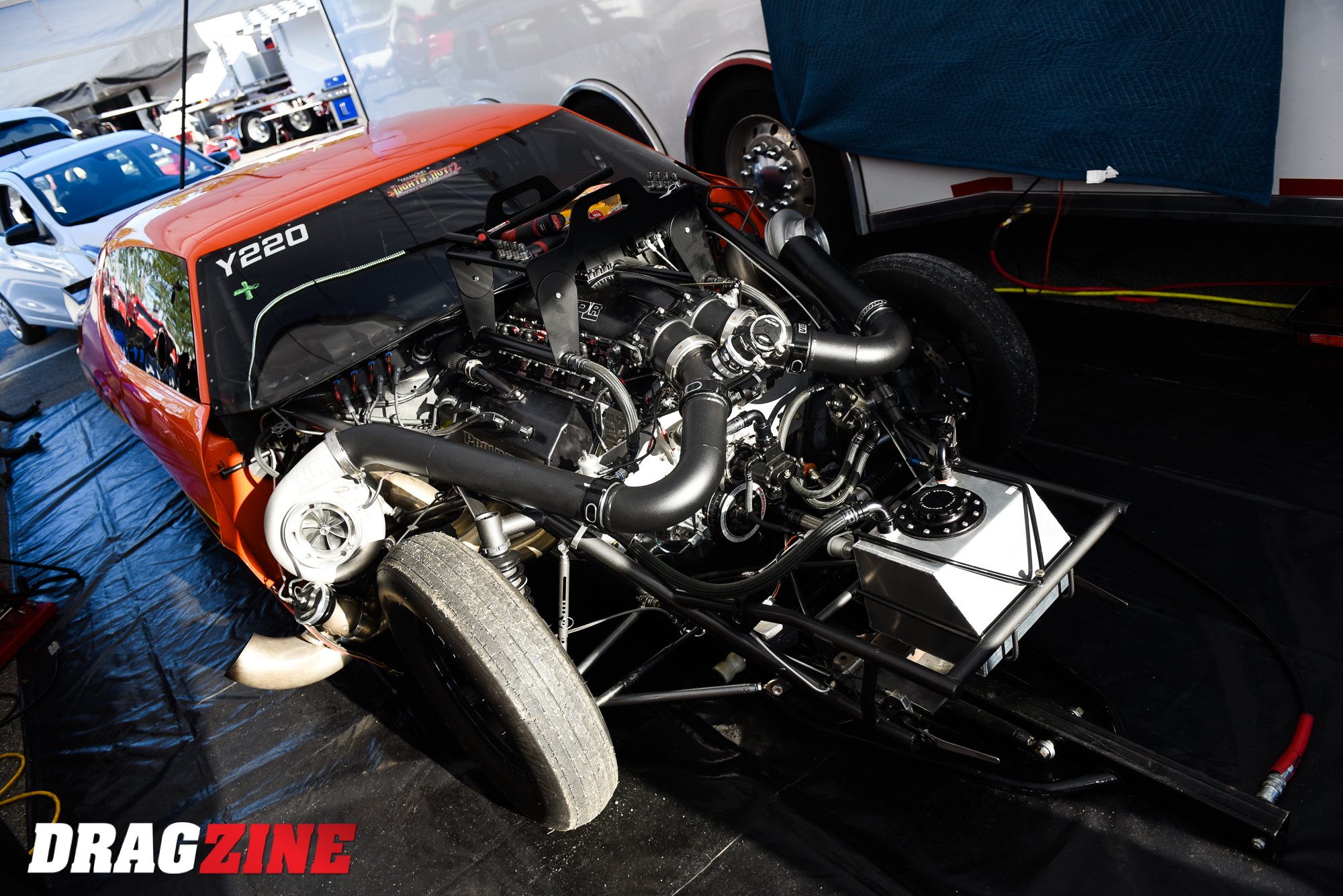Lights Out 12 Champions Crowned
Jason Lee accomplished everything one could in Radial versus The World at Lights Out 12 — the Ohio racer set the world elapsed time record on drag radials in Wednesday’s opening qualifier with a 3.50 and never looked back, scorching the South Georgia Motorsports Park to a series of 3.5-second runs on his way to victory Sunday over Georgian Marcus Birt in a great 3.569- to 3.589-second finale. Lee defeated Paul Gargus in round one, and Tim Slavens, Daniel Ray, and Jamie Hancock in subsequent round, never running slower than 3.600 in five founds of racing.
“Awesome from start to finish. The team did an excellent job. I couldn’t ask for better parts, better components, a better team, or a better working car,” Lee said of his team, led by car owner Eric Gustafson.
In Pro 275, Mo Hall chalked one up for the nitrous contingent, parlaying low-3.70s in qualifying into victory on raceday. Hall defeated Jeff Miller and his supercharged Camaro in a great final round matchup, 3.784 to 3.815, after Miller took an .067 to .039 edge out of the gate.
“It was fun racing these boys, it’s fun being down here,” Hall said of his triumph. “A big thanks to all my guys.”
Paul Gargus powered has twin-turbo Camaro to the win in Limited Drag Radial in another very tight drag race for all the marbles, his .043 and 4.063 keeping him just ahead of Tim Dutton, who was .052 on the tree and ran a right-there 4.076.
“I love it,” Gargus said. “We’ve been waiting on it. We struggled all weekend, and it finally paid off. It’s a anew combination….we switched from alcohol to gas, and the weight combination is little off, but we just kept beating on and beating on it and finally found it.”
In X275, perennial frontrunner Ron Rhodes drove his nitrous-assistant Camaro to the win over Eric LaFerriere in his “White Rice” 2JZ-powered Nissan. Rhodes had qualified strong and ran in the 4.20s throughout the weekend, going 4.22 in the opening round, and 4.31, 4.29, and 4.26 on his march to the final. LaFerriere was .009 on the tree, but struck the tires early and could only watch Rhodes drive off into the sunset.
“It [Rhodes’s birthday weekend] couldn’t be any better than that,” said Rhodes. “I don’t know what else to say…we came down here with a new setup in the car, and on my birthday weekend — we’ve been gone for a week, because we went testing in Orlando last week — to come here and race and keep getting better and better with it, I just couldn’t be any happier. This was a great birthday.”
Rylan McLaskey won his second DuckX race in a row in Ultra Street, backing up his victory at No Mercy 11 last fall with a defeat of Bill Gregan Sunday afternoon, his .044 light and 4.585 motoring away from the slowing Gregan.
Shawn Pevlor was the class of the field in DXP Street all weekend long, setting the class record with a 4.87 in qualifying and never looking back. Pevlor went 4.92 in the opening round, and followed that up with laps of 4.99, 4.98, and 4.95, before dropping a 4.91 on final round opponent Jonathan Insley.
Jason Riley collected the Limited 235 victory over Michael Jordan (not the hoops star), driving his ’97 Mustang to a 5.11 to keep ahead of Jordan, who ran 5.34 but took a huge .005 to .111 advantage out of the gate.
Badly Influenced
Greg Schmidt said he would never put a turbo on his car, nor would he ever put radials on it. This week, he’s done both.
Schmidt, a native of Brainerd, Minnesota — his family’s automotive repair business is just down the road from famed Brainerd International Raceway — races in “Cash at the Creek” events and other big-tire heads-up and no-time events in and around his home state. But he trekked down from cold and snowy Minnesota this week to the sunshine of Georgia to see what his Camaro is capable of on small tires and a super-sticky racing surface. Because of his combination (which we’ll get to in a second) Schmidt’s car only fits into Radial versus The World. And while he has no notions of being competitive with 3.5-second behemoths, this trip is all about proving some things to both himself and others.
“I normally run big tires and wheelie bars; we put it on the dyno and found we have enough power and the stuff to go run Radial versus The World. We thought we’d at least try it. Everyone is always telling us ‘put it on radials, I bet you won’t put it on radials.’ So we did, and now they’re saying ‘wow, you went really fast on radials, good job.’ But we did it because they all told us to…we figured it out despite them wanting to see us fail. On the fifth pass, we went 4.34 at 169 mph, which is my best pass ever. We’re really happy with that. We put more boost to it in Q2 and backed it up with a 4.37 at 177 mph.”
The car is a 2020 Camaro, steel roof and quarters, that began life as a Hennessey car. A 25.2 chassis carries the 528 cubic-inch Hemi and massive 118mm turbocharger that feeds an APD blow-through carburetor. Schmidt attended No Mercy 9 in 2018 with a third-generation Camaro competing in Outlaw 632 on slicks; shortly thereafter that car was sold and another third-gen was built. On just the sixth pass, Schmidt rolled the brand new car at 180 mph; the body was disposed of and that crashed chassis is what you see under this car…straightened and repaired, of course.
Schmidt’s t-shirts are emblazoned with “The Eatin’ Crow Tour” because he said he’d never put radials or a turbo on his car, and “here I am in South Georgia with radials on and it and a turbo Hemi,” he says with a grin.
“We’re just having some fun. We pulled into town Sunday and I was telling people that a week before that I was in my trailer with a giant propane heater running so that we could get the car ready and it was 40 below zero. Then I came down here a week later it was literally 100-degrees warmer.”
Despite running 210-pounds overweight for his combination in Radial versus The World, Schmidt has clicked off a best of 4.263 at 178.02 mph through four rounds of qualifying.
Through his YouTube channel, Bad Influence Garage, Schmidt has been documenting his preparations and results leading up to and throughout each day of his week-long Lights Out 12 experience.
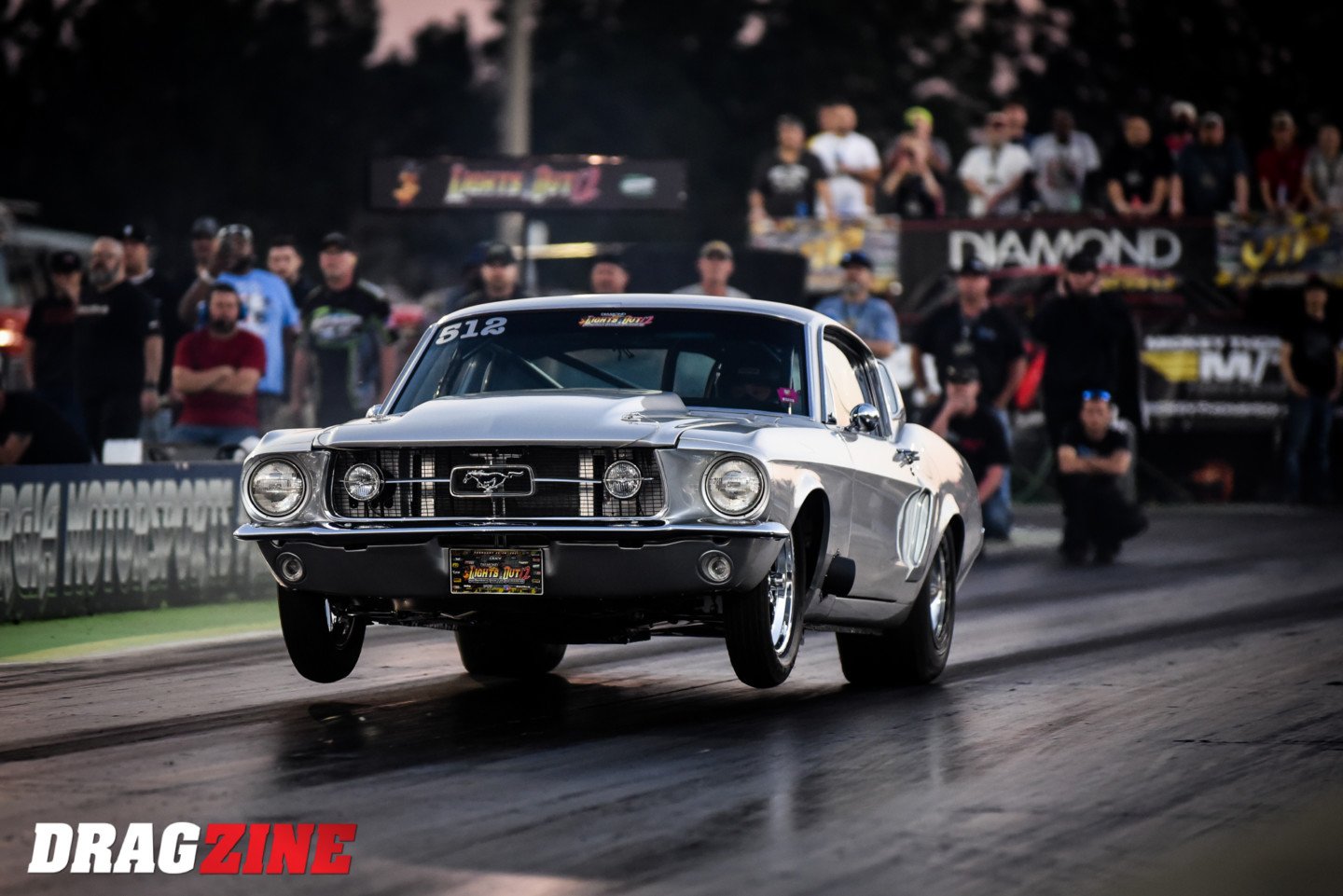
Will Harbin and Chris Cantrell brought out their absolutely stunning 1967 Ford Mustang fastback to compete in the no-time shootout this week. This former Dragzine feature car is too nice to race in our opinion, so kudos to these guys for their bravery.
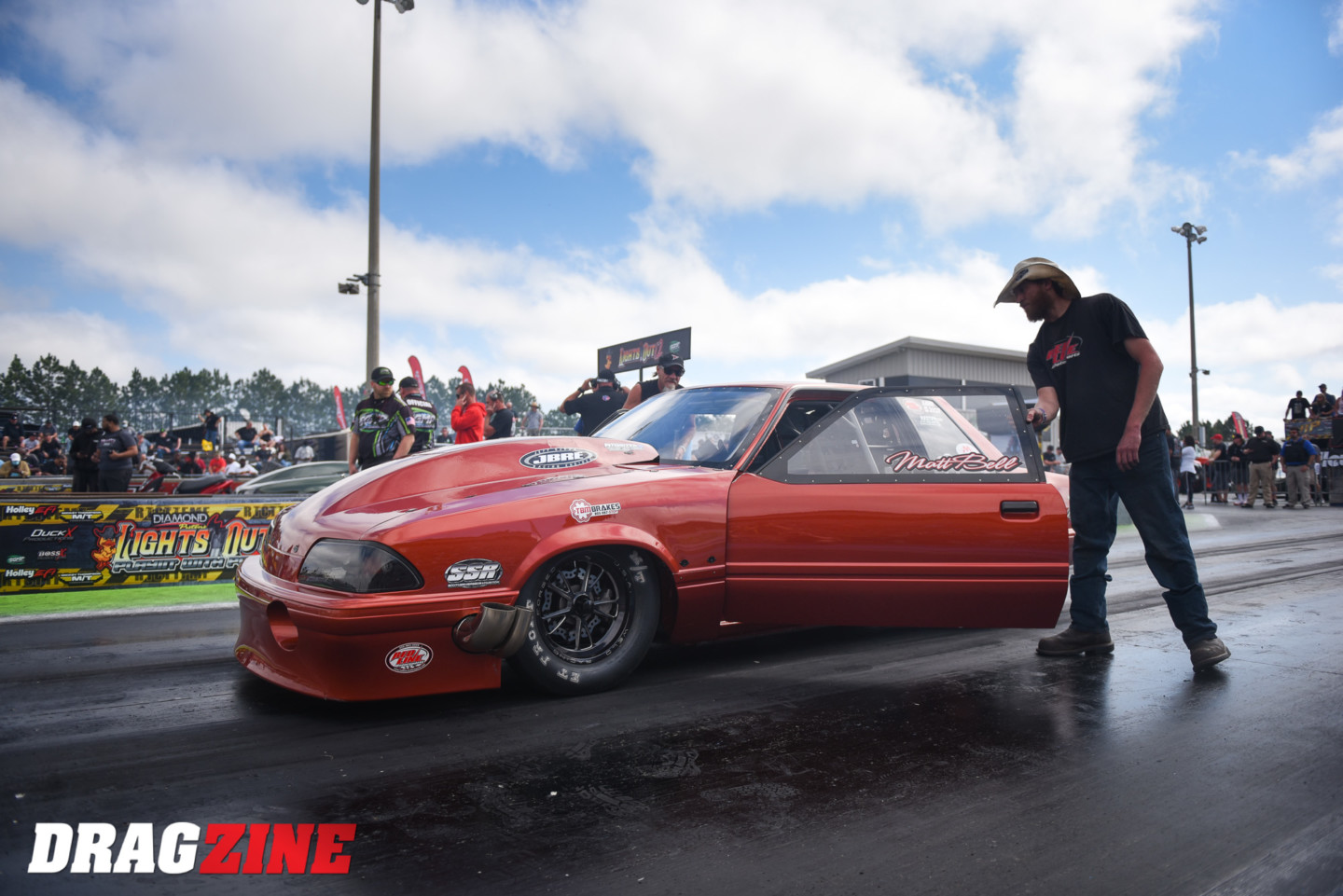
Matt Bell, driving his Limited Drag Radial Mustang in the Radial versus The World class, clocked a career-best 3.99 in the opening round of eliminations, his first trip into the 3-second zone.
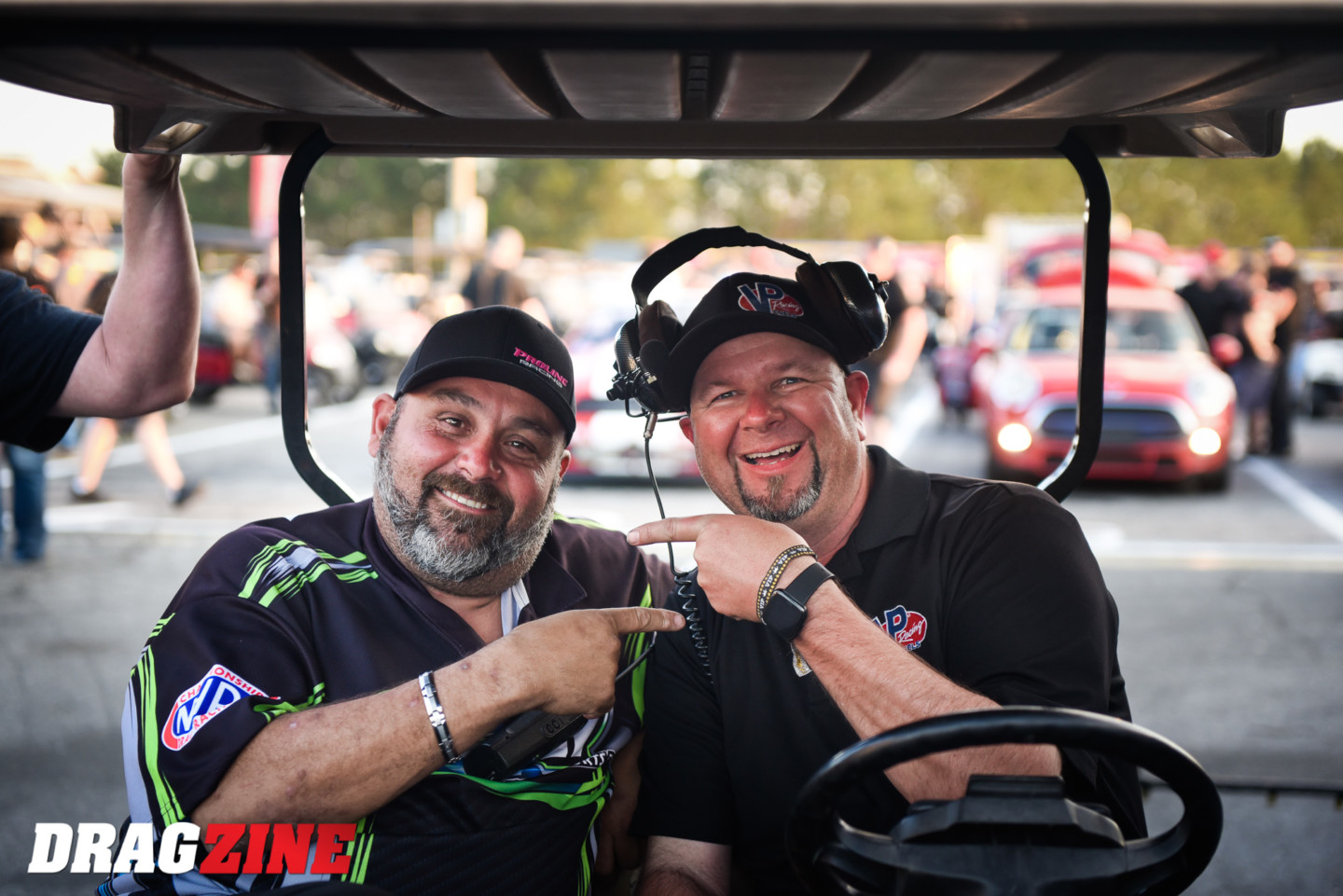
Jason “Pooch” Rueckert (right), a VP Racing Fuels regional director by day and Limited Drag Radial racer and event promoter at night, was tabbed by track owner Ozzy Moya to put his magic touch on the preparation of the South Georgia Motorsports Park surface this week. The partnership has been nothing short of a success. with new world records established in no fewer than four heads-up eliminators.
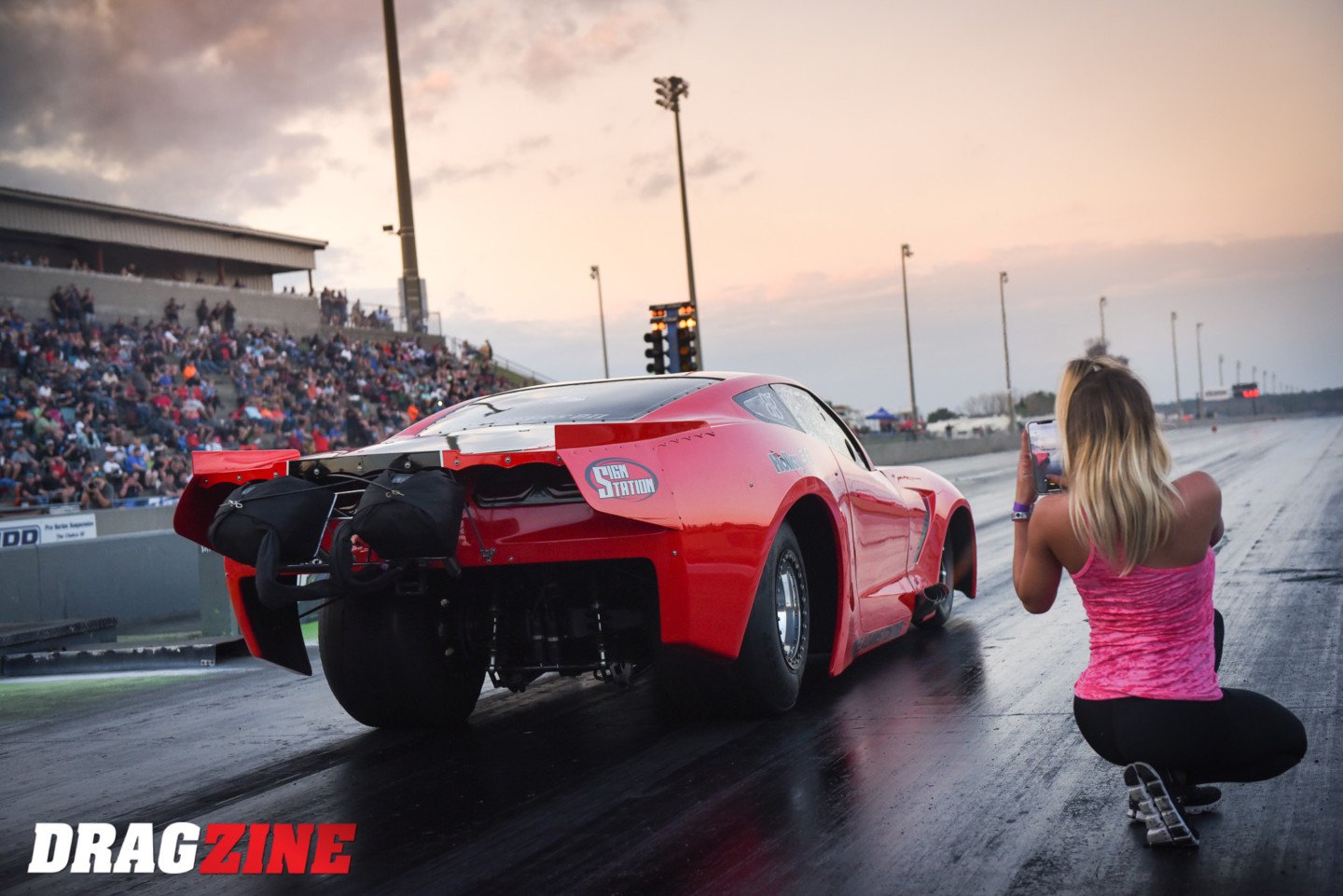
Marcus Birt qualified third in Radial versus The World with a 3.584 in his nitrous-assisted Corvette and advanced through round one to compete in Sunday’s eliminations.
What goes up must come back down....and at night, it makes for great photos! Limited Drag Radial racer Jody Voyles went all-in in the final qualifier to get in the show, but this wheelstand from his twin-turbo Camaro spelled doom for his weekend. He ended up 35th with a 4.47 best.
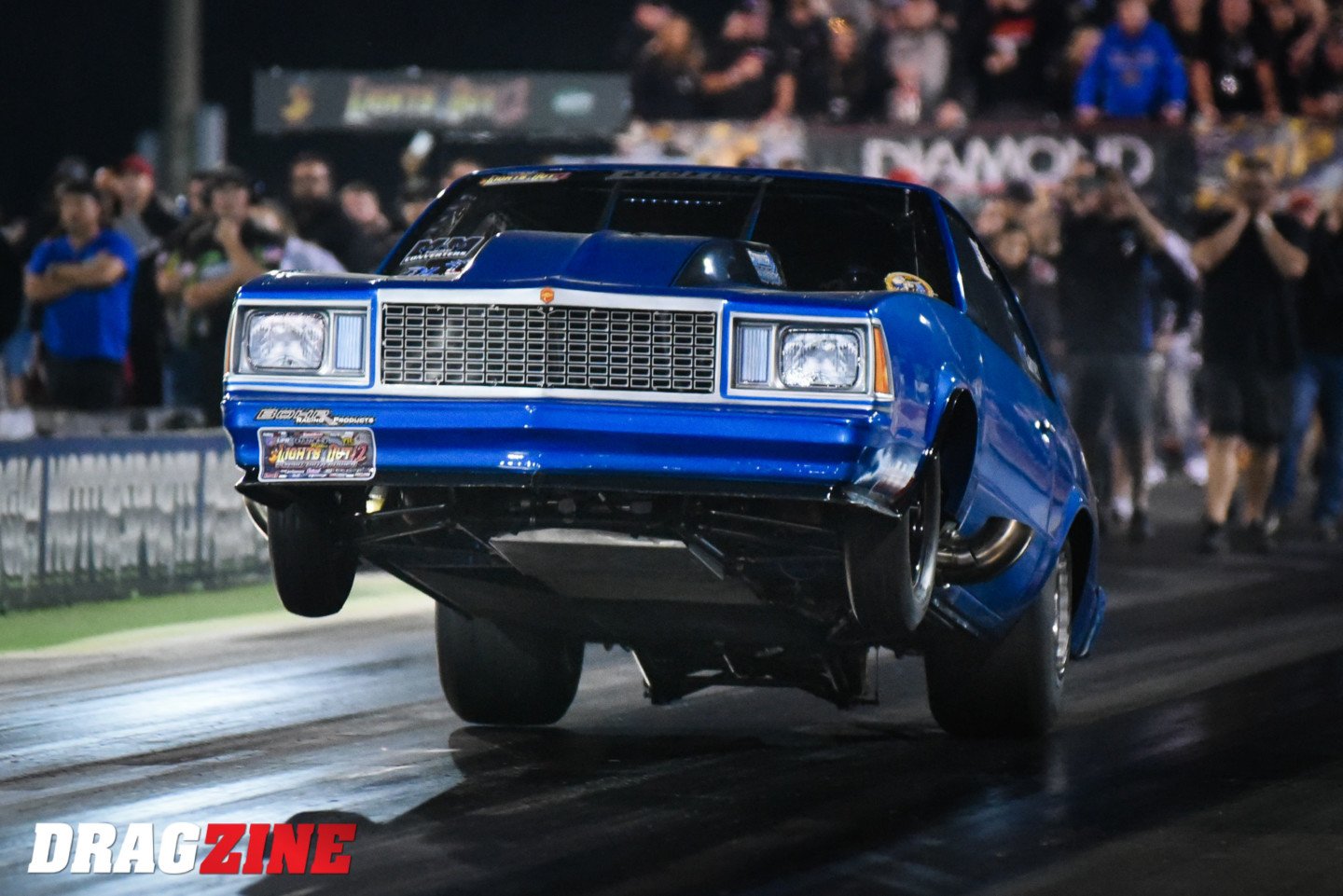
Pro 275’s Mark Micke launched into a rare wheelstand in his big-block twin-turbo Malibu during qualifying.
They Don’t Make ‘Em Like This Anymore
Outlaw-style drag racing events such as Lights Out traditionally draw a younger crowd of participants and spectators who gravitate to the modern technologies employed in today’s hottest racing machines; and so it goes without saying that Charlotte, North Carolina native Kenny Floyd has owned his 1958 Chevrolet Corvette longer than the majority of the people on hand at South Georgia Motorsports Park this week have been alive.
“I got the car back in 1968…I drove it on the street and drove it to high school,” Floyd begins. “I used to take it down to Shuffletown and Concord and Mooresville and race it. Then I went and put it on the track because I kept tearing up stuff and couldn’t get around anymore and had to buy another car. I used to run E and F/Gas and Modified with it and it’s progressed to what it is now.”
The ‘Vette retains the original body from nose to tail — save for a lighter-weight hood Floyd has made in recent years so he can lift it on and off easier. The firewall and floor pan are likewise original. Floyd had the car re-painted its candy red hue in 1986. Floyd made the seats bey hand from foam and upholstered the interior in a classic suede-like red trim to match. Power is compliments of a 400 cubic-inch small-block with a Dart block, Trick-Flow 18-degree aluminum heads, and a roller camshaft, on alcohol, transferring to a Powerglide transmission and Dana 60 rear end with 5.13 gears.
“I’ve done all the work on the car myself; the only thing I haven’t done with this car is the roll cage…I had some friends of mine do that, and another guy built the front snout. The paint, the interior, everything I’ve done myself.”
Floyd races in and around North Carolina exclusively in 6.0 index events; he’s been coming to DuckX events at SGMP for five years, scoring a runner-up best finish.
The VW of Old Meets New
The list of Volkswagen VR6-powered racecars here on the grounds of SGMP — or anywhere in there world for that matter — is a pretty short one. And we’re going out on a limb and saying Brad McBride has the fastest one.
McBride’s 1963 Volkswagen Type 3 fastback is unique for a number of reasons; here at Lights Out 12 it’s size is what immediately draws you in — this is a small car, even next to a Fox-body Mustang. But as you look closer, the details are immersive.
The car is powered by, of all things, a 2001 Volkswagen Jetta VR6 2.8-liter staggered six-cylinder with a 76mm turbocharger; McBride is using the factory block and heads, as well as the crankshaft. A set of aftermarket rods and JE pistons provide some assurance in the rotating assembly.
The VR6 was originally intended for a front-wheel-configuration, so McBride devised a. Inversion kit to swap it to rear-wheel. A Reid Powerglide transmission sends the power to a 6600 rpm stall converter, and custom fabricated 9-inch rear end housing.
“I’ve fought the #1 rod bearing in the past, but I think I’ve got it figured out. That, and head gasket issues,” McBride shares of his challenges in making a unique engine work. “The adapter plate was also a challenge. I worked though that, and then we got under the 5.40s is when we started hurting the #1 rod bearing. It’s just the way that engine is constructed, it’s using the oil from the back to the front; normally it sits sideways in the car, but the G-forces from the 60-foot are pushing against it, so I’m losing oil pressure there.”
Why the Jetta engine, you may be asking?
“It started with me and my wife building a Volkswagen Golf, and it had this engine in it. Just playing around with it, it made 440 horsepower to the tire. I’ve always raced Super Comp dragsters and stuff, and I got burned out on bracket racing and she told me to build a car and this is just what it led to. I was fascinated after doing her car with the VR6, and I thought it had potential, so I stuck with it.”
“It used to have a roof rack with a tricycle on it,” McBride adds. “When I told my brother I was going to build a VW with a bike on top and outrun my dragster he said there was no way. Well, I ran 5.27 with my dragster and the third time out with this car it went 5.23.”
McBride is here running the 275 radial No-Time class, admitting his intention is really to take advantage of the prime track and atmospheric conditions; his VW has been low fives previously, and while he’s hoping to punch it in the 4’s, he’s still a long way off from being competitive against cars with a lot more cubes and power-adder.
“I’ve got a new FuelTech ECU, new suspension, a lot of new stuff…we had to do that to reach some goals,” Brad says.
The VW is painted a patina finish on its exteriors and the wheels finished in a rust-like paint finish. Inside, though, is where McBride, a sign-maker by trade, really showcases his magic. The wheel tubs are both hand-painted in the Reese’s and Gatorade logos — a nod to he and his wife’s favorite snacks — the transmission tunnel is wrapped in state license plates (in decal form) of important places in his family’s history, and door panels also feature classic automotive logos.
Friday Qualifying Update
Jason Lee’s world record-setting 3.502 clocked during Wednesday’s uber-cool conditions has him comfortably atop the Radial versus The World field; Lee, driving Eric Gustafson’s ProCharger-boosted Chevrolet Camaro, entered the weekend as the favorite to break into the 3,40s, hot off the heels of a series of low 3.5-second runs in testing, but the warm, damp atmospheric conditions have thus far proven unfavorable for bettering his early mark. Bryan Markewiecz slotted in second with his 3,55, with Mark Marcus Birthings (3.56) and Steve Jackson (3.59) also in the 50s.
Justin Cyrnek continues to pace the Limited Drag Radial field with his Thursday evening national record pass of 3.950 at 191.95 mph, just a tick ahead of Justin Martin’s likewise impressive 3.96. Paul Gargus joined them in the threes with his 3.98, and is trailed by Shane Stack (4.023) and James Lawrence (4.027). A whopping 48 entries have taken a time in LDR, with the bump sitting at Jeff Helsinger’s 4.419 with one session of qualifying remaining on Saturday.
Just .005-seconds separate the top two in Ultra Street qualifying, as Brian Keep clocked a 4.514 to edge out Kirt Sanders’ 4.519 — the duo are presently holding off a string contingent of competitors in the 4.50s — seven of them in all.
Buginga (left) and Copson.
Manny Buginga and company have enjoyed a banner weekend thus far — Buginga has put together a string of mid- to low-3.70s in Pro 275 qualifying, including a world record and career best 3.704 on Friday evening. Buginga leads there strongest field of Pro 275 entries in history, with Jeff Miller, Eric Dillard, and Shawn Ayers all hot on his heels with 3.71-second laps to their credit. Jason Borum is anchoring the 32-car field wit his 4.35, and it takes a 3.893 to break into the top half of the show. Buginga’s team driver, Blake Copson, meanwhile, uncorked a 4.17 — the only pass in the teens thus far — in Wednesday evening’s opening session of X275 qualifying and has held strong over a field of 41 entries. The 32-car bumps spot in X275 stands at 4.647 with the fifth and final session to be run on Saturday morning. John Urist, in his Ford Coyote-powered Mustang, has impressed with a second-best 4.20, and heavy hitters Rob Goss, Ron Rhodes, and Charles Hull round out the top five.
Shawn Pevlor is invoking pain on the DXP Street field in his KBX-powered Fox-body; he clicked off a 4.89 in pre-race testing and repeated in early qualifying with another .89. Then, on Friday night the Ohio native lowered his own national record with a crushing 4.878 to pace the field into eliminations on
Saturday.
“The Bone Crusher”
Cars with flames never go out of style…nor do second-generation Chevelles.
Pro Modified vet Hank Stubbs teamed up with car owner Grady Singleton, Jr. to bring this menacing new ride to compete in Pro 275. The car was a four year project for Bessesmer, Alabama native Singleton, as chassis builds David Reese reworked the former 10.5-inch tire car for modern-day radial tire racing. Power comes via a Brad Anderson Hemi with a screw supercharger, transferred through a Liberty five-speed transmission and Brunodrive lockup converter package. Stubbs wired and plumbed the car after it left Reese’s shop. The car is largely controlled by a Davis Technologies Profiler system. Stubbs has been racing screw-blown Pro Mods around the south for a number of years with success, and while radial-tire racing is all new to him, it’s been a team effort to learn the new tire.
“For us, the biggest thing has been trying to find somewhere with a surface as good as this to test. Everywhere around us is slick-tire prep, and when we got here, everything that wouldn’t work around the house worked great and went right down through there. Everything powerplant-wise is familiar to me — David has been helping us with the chassis and once we get it working, we’ll be in good shape.”
Stubbs broke a blower belt 2-seconds into his opening qualifying shot, coasting to a 4.09; he believes it was on the path to a mid-3.80, setting them up for a push into the top half of the field as qualifying continues Thursday evening.
And yes, the flames are real — Hoover Airbrush in Birmingham, Alabama applied the unique and modern take on a classic hot rod look.
Something Different
Jeff Miller kept his plans a secret until he arrived here at SGMP: his Radial versus The World Camaro is now equipped with twin Precision turbochargers, in place of the screw supercharger it’s been outfitted with for a number of years. Miller, in the words of his crew, “got bored,” and with the help of the team at Precision, spent the early weeks of 2021 switching his combination over to take advantage of the adjusted weight package for twin-turbo cars in the class. The engine itself remains the same, save for a camshaft change and the obvious intake manifold, injectors, and turbocharger plumbing under the hood.
The First Diesel In The 3’s!
Larson Miller and the Firepunk Diesel team made history this morning with the first 3-second pass in history by a diesel-powered vehicle, scorching the South Georgia Motorsports Park 1/8-mile to the tune of a 3.998 at 182.67 mph. The barrier-breaking pass — which came on a rather warm and sunny Thursday morning during which atmospheric conditions were not prime — ends a years-long battle amongst the sport’s top diesel-fueled teams to achieve immortality.
“This means everything,” Lavon Miller says, with a grin as wide as the state of Georgia on his face. “To be the first diesel vehicle into the threes is something that makes history. You can go 4.04 and people will forget about you in a year, but to be the first to go threes lasts forever. This was a personal goal of ours and we chased it and to actually get there after a year and a half of trying is just amazing. It’s such a reward to see the team effort and everyone come together and chip off the times. It’s just amazing.”
The Chevrolet S-10 is powered by D&J Precision Machine-built billet Cummins with an XG Performance fuel system featuring 14mm CP3’s, a 98mm turbo, and three stages of nitrous oxide. A Rossler Turbo 400 and Neal Chance converter deliver all the power and torque to the 315 drag radials.
Miller clicked off a career best 4.10 in Wednesday night’s qualifier under the lights — they had already gone a 4.11 last fall — and Lavon admits even he wasn’t expecting the car to pick up a full tenth of a second.
“We took last night’s data-log and added 10-percent of fuel on the hit, made some shift point changes and knocked it right down. The change in the 60-foot made the difference. It was 1.11 last night and 1.051 today, and it wetter with down broadway. It’s little changes in the first 60-feet that sets up whole run. We weren’t completely confident coming in that we could do it — we tried really hard for the last year and a half, and I know how racing is — you can have everything in the basket you need to get it done and you still have to put it all together.
“It’s fun to do with a door car. We’re heavier — 3,090-pounds — and we have ballast in there to keep it from flipping over backward. To do it at that weight, it’s a proud moment for us,” Lavon adds.
Honk If Parts Fall Off
Rick Steinke trekked down all the way from his home in Holland, Pennsylvania with a fresh new combination to compete in the Limited 235 category this week. His 1967 Chevelle, aptly named “Honk If Parts Fall Off” — an ode to its patina’ed appearance — is sporting a pair of turbochargers for the first time. The single 88mm was swapped out for a pair of 71mm BorgWarners feeding the 421 cubic-inch small-block Chevrolet.
Steinke covered the 1/4-mile in a best of 7.99-seconds with the 88mm configuration and routinely competed in 8.50 index events in the Northeast. The car has also completed three Drag Week’s, and is one of the only cars in competition here this week that could be driven the interstate to Valdosta for dinner and not break a sweat. Steinke fired the car for the first time last Saturday night at 11 p.m. for the haul down to Georgia. To make weight, some 400-pounds had to be hung all over the car to get it to the hefty 4,005-pounds it sits at. Steinke clocked a 5.32 at 122 mph best so far this weekend.
Tim Slavens Earns His Pilot’s License
Pro 275 racer Tim Slavens made the South Georgia Motorsports Park live up to its name — “the house of the flying cars” — early in testing Wednesday when his Camaro took flight, crashing back to earth after a visually stunning aerial liftoff. The impact, while less harsh than Slavens himself believed it was going to be, still left his twin-turbo machine with considerable damage; the 4-link and anti-roll bar were bent, and the front of the chassis was both kinked and broken at the weld on the passenger side fore of the shocks.
Video by Straight Line Media
“It was just carrying the front end out there a little bit and the wheelie control settled it down. It sat down, and then it drives the timing back into it, it caught it on the bounce a little bit and then I think we were just a victim of the air that got under it and picked it up the second time. It happened so quick….when she came back up the second time I just dumped the parachutes and hung on.”
“I was looking out the side window watching where I was headed. I really thought it was going right and that it was going to come down on top of the wall. I was bracing and preparing myself, thinking ‘this is going to hurt.’ I didn’t realize that it was going to the left. If I hadn’t been lucky enough to get the chutes out, it might have been in the wall. It didn’t break the steering or anything, Sio I was still able to control it.”
“Since Bradenton we’ve been chipping away at it and feel like we’re getting a better handle on it overall. We felt good that we unloaded the same car yesterday that we loaded in Bradenton a few weeks ago. the first couple hits looked pretty good, and Tuesday night was a personal best on the 275 tire with the 3.81. This morning we didn’t really change anything and just wanted to repeat and go out there and run it all the way to the finish line, and it didn’t agree.”
“The upper right 4-link bar was bent pretty good, and the wishbone. We have stuff for that if we can get the snout bar and frame rail up front squared away. Right now we’d consider it a win to be able to go back to the starting line with it and it do what it’s supposed to. The guys from Tydo Race Cars have no quit in them, so we’ll hopefully make it back tomorrow and can make some short hits in testing to check it all out and make sure it works like it’s supposed to.”
Passers-by of Slavens’ pit at one point witnessed the team chain one side of the chassis to the trailer, and use a come-along to ratchet the bent side of the front framerails to a pickup truck to tug the bent the chassis back into place. You use what you have at your disposal, right?
Slaven’s machine has been for sale since last year, as he charts his plan to re-enter the Radial versus The World class and Midwest Pro Mod Series with a new ’69 Camaro that is presently under construction.
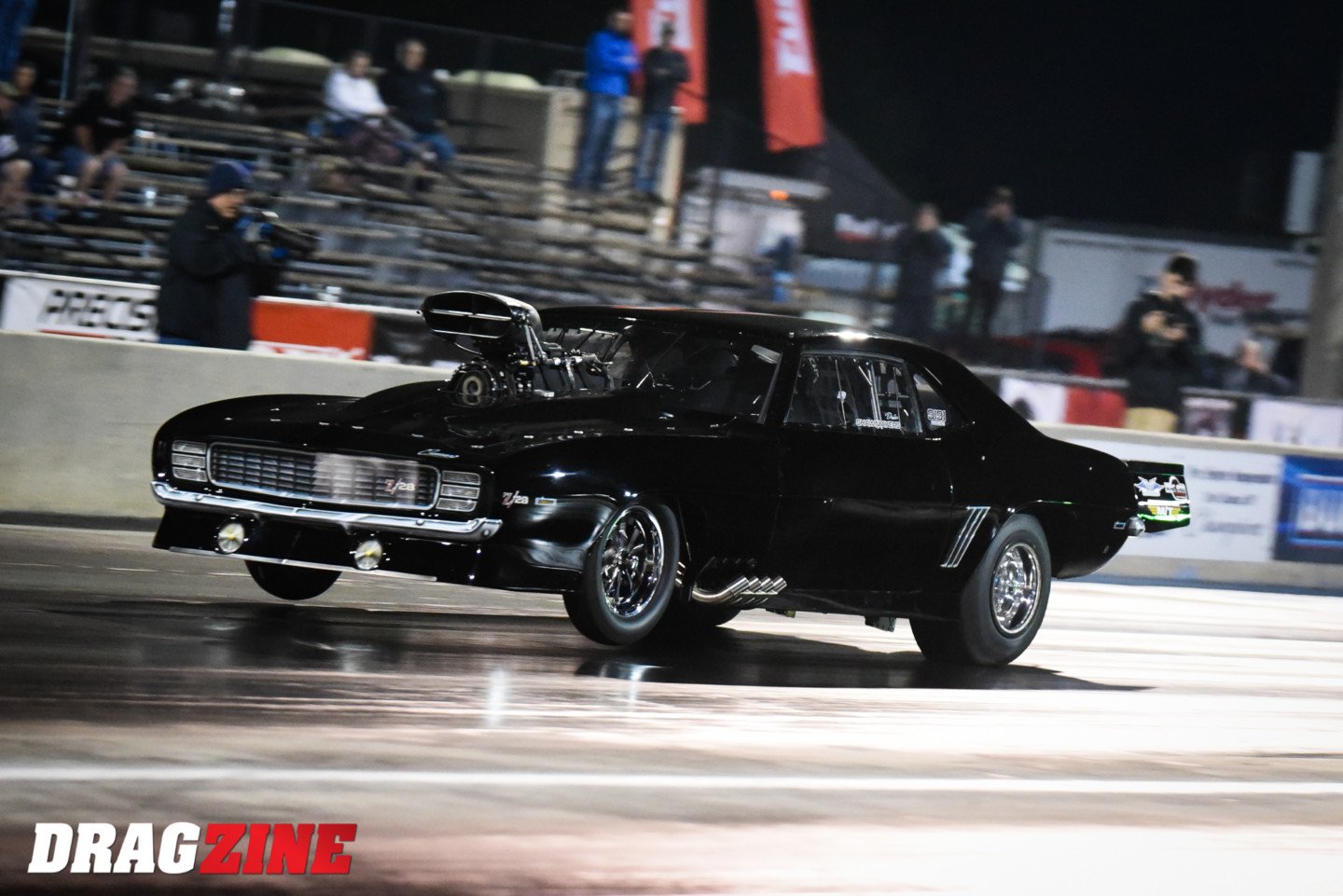
Shawn Ayers is piloting this familiar 1969 supercharged Chevrolet Camaro for Fletcher Cox in Pro 275. Ayers clocked a stout 3.71, quicker than the incoming national record, to slot in third in the order in the opening round of qualifying.
Pro 275 competitor Tommy Youmans has made the ultimate sacrifice in his efforts to run at the head of the pack in the hotly-contested category: he’s pulled his one-of-a-kind Pontiac engine in favor of a Pro Line Racing Hemi. Youmans, a hardcore Pontiac fanatic who had assembled the most powerful Poncho engine on the planet, says he had to think long and hard and a had number of conversations with tuner Jamie Miller before reluctantly agreeing to the change. “I won’t kid you, it was really, really hard,” Youmans says.
With the Pontiac combination, Youmans had been as quick as 3.97 in competition and a little quicker in testing, but he and Miller are confident it will run 3.80s with ease now that it is both producing more power and at weight for the class. In addition to the engine change, Youmans has turned to a Hart’s Turbo 98mm snails for his setup this season. Tommy’s hope is to place the 455-inch Pontiac in another of his cars and try pressing it into Pro 275 duty, as well.
Oh-So Close To History
Jason Lee, behind the wheel of Eric Gustafason's Radial versus The World supercharged Camaro, took a shot at the 40's in prime air during Wednesday's opening qualifier, coming up just a couple of ticks short, but nevertheless resetting the world's elapsed time standard on a radial. Former racer David Hance has put up a bounty of $3,499 for the first driver into the 3.4-second zone in official competition, which spurred Lee and some other players to hustle to the lanes to be among the first cars out in the session.

